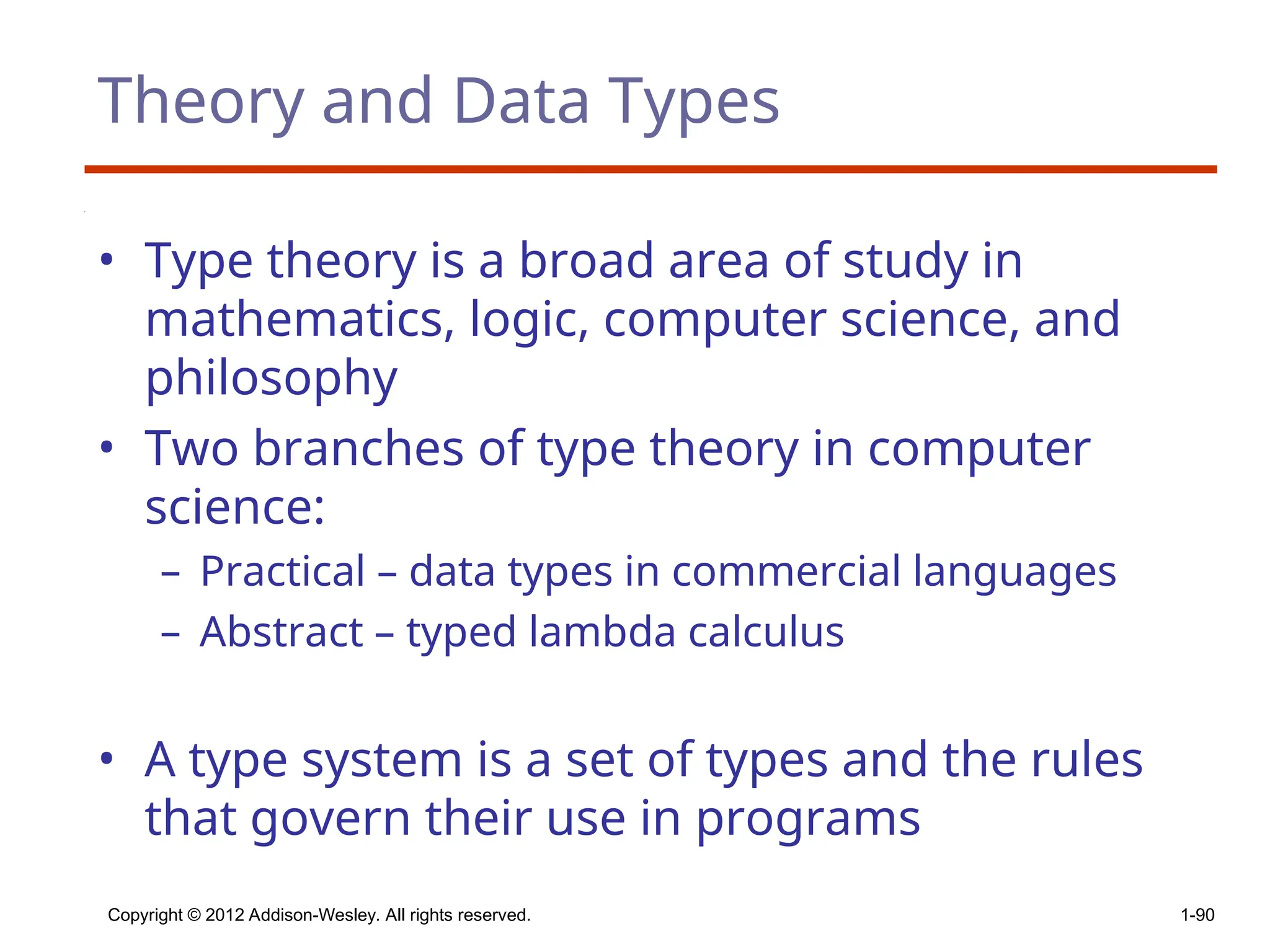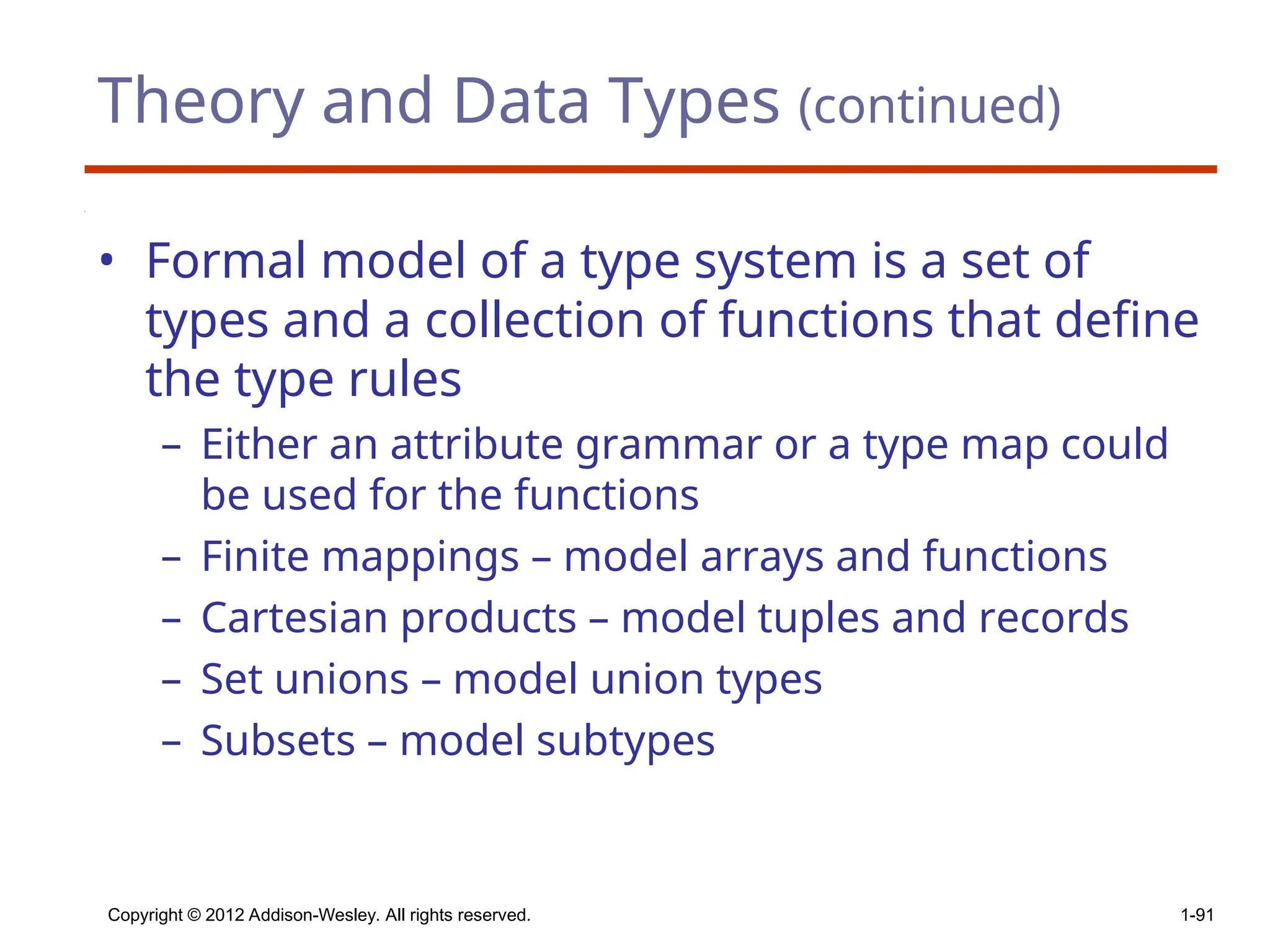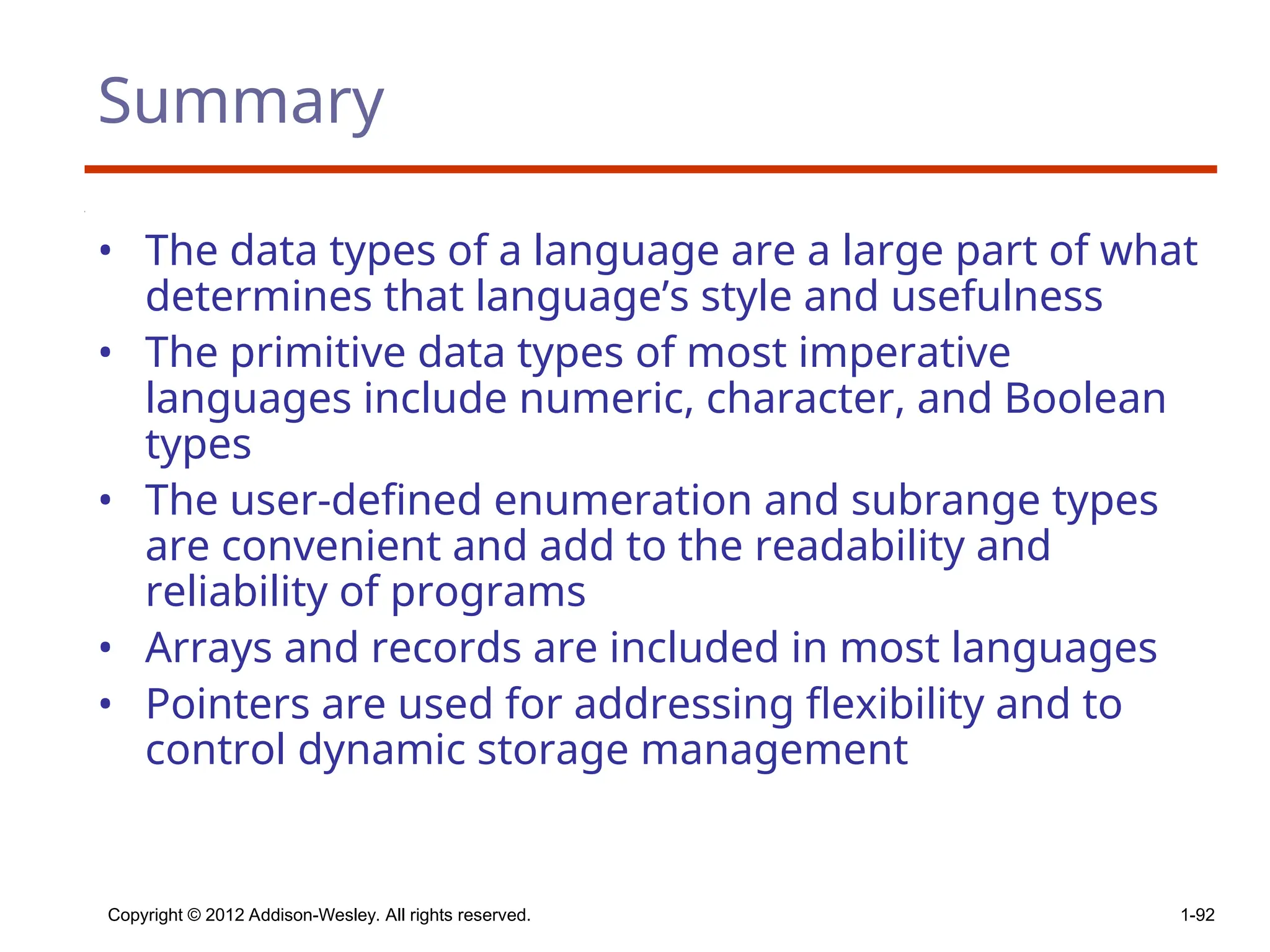More Related Content
ch6-Short.ppt eee cse www rrr www qqq rrr ttt Theory of programming language chapter 6 Primitive data types in java Similar to pl10ch6_datatypesprinciplesof programing.ppt
L6.1 Primitive data types, array, records and union.ppt 5 Names, bindings,Typechecking and Scopes a brief explanation on the topic of Imperative Programming Paradigm.pptx Theory of programming language chapter 5 SFDC Introduction to Apex 7 expressions and assignment statements Object Oriented Programming Using C++.pptx Ppt for engineering students PPL subject Tech Days 2015: A quick tour of Ada 2012 chapter 7: DATA TYPES - IN PROGRAMMING LANGUAGES Recently uploaded
collect information/produce brochures on different types of alternators VTU BCS502 MODULE 2 PART 2 DATA LINK CONTROL Chapter 4 Fluid Mechanics _2024_2025.pdf ESD Lecture-4-5 U3.pptx......................... Operators in Python and its All types.pptx L2 Regularization for Deep Learning with example What is an object and class in java .pptx Outsmarting AI_ Building Fair and Responsible Prompts - DevFestDC Class diagram of ATM, college management system, E commerce system, Library m... Electromechanical works :PUMP BASIC TRAINING KENHA 1.pdf Annual road construiction report Water-Facilities-and-Drinking-Water-Availability.pdf Quantum Theory (Engineering Chemistry ) RFC Draft Agentic Ecommerce protocol security analysis Operating Systems Structure Function Services Overview of Operators in Java with all types.pptx collect information/produce brochures on different types of alternators Reflection and Refraction of EM waves at Media interface.pdf HACKTOBERFEST 2025 - GDG ON CAMPUS NARULA Statcom. Presentation Power Quality Voltage Stabilisation for Industrial ... pl10ch6_datatypesprinciplesof programing.ppt
- 1.
- 2.
Copyright © 2012Addison-Wesley. All rights reserved. 1-2 Chapter 6 Topics • Introduction • Primitive Data Types • Character String Types • User-Defined Ordinal Types • Array Types • Associative Arrays • Record Types • Tuple Types • List Types • Union Types • Pointer and Reference Types • Type Checking • Strong Typing • Type Equivalence • Theory and Data Types - 3.
Copyright © 2012Addison-Wesley. All rights reserved. 1-3 Introduction • A data type defines a collection of data objects and a set of predefined operations on those objects • A descriptor is the collection of the attributes of a variable • An object represents an instance of a user- defined (abstract data) type • One design issue for all data types: What operations are defined and how are they specified? - 4.
Copyright © 2012Addison-Wesley. All rights reserved. 1-4 Primitive Data Types • Almost all programming languages provide a set of primitive data types • Primitive data types: Those not defined in terms of other data types • Some primitive data types are merely reflections of the hardware • Others require only a little non-hardware support for their implementation - 5.
Copyright © 2012Addison-Wesley. All rights reserved. 1-5 Primitive Data Types: Integer • Almost always an exact reflection of the hardware so the mapping is trivial • There may be as many as eight different integer types in a language • Java’s signed integer sizes: byte, short, int, long - 6.
Copyright © 2012Addison-Wesley. All rights reserved. 1-6 Primitive Data Types: Floating Point • Model real numbers, but only as approximations • Languages for scientific use support at least two floating-point types (e.g., float and double; sometimes more • Usually exactly like the hardware, but not always • IEEE Floating-Point Standard 754 - 7.
Copyright © 2012Addison-Wesley. All rights reserved. 1-7 Primitive Data Types: Complex • Some languages support a complex type, e.g., C99, Fortran, and Python • Each value consists of two floats, the real part and the imaginary part • Literal form (in Python): (7 + 3j), where 7 is the real part and 3 is the imaginary part - 8.
Copyright © 2012Addison-Wesley. All rights reserved. 1-8 Primitive Data Types: Decimal • For business applications (money) – Essential to COBOL – C# offers a decimal data type • Store a fixed number of decimal digits, in coded form (BCD) • Advantage: accuracy • Disadvantages: limited range, wastes memory - 9.
Copyright © 2012Addison-Wesley. All rights reserved. 1-9 Primitive Data Types: Boolean • Simplest of all • Range of values: two elements, one for “true” and one for “false” • Could be implemented as bits, but often as bytes – Advantage: readability - 10.
Copyright © 2012Addison-Wesley. All rights reserved. 1-10 Primitive Data Types: Character • Stored as numeric codings • Most commonly used coding: ASCII • An alternative, 16-bit coding: Unicode (UCS-2) – Includes characters from most natural languages – Originally used in Java – C# and JavaScript also support Unicode • 32-bit Unicode (UCS-4) – Supported by Fortran, starting with 2003 - 11.
Copyright © 2012Addison-Wesley. All rights reserved. 1-11 Character String Types • Values are sequences of characters • Design issues: – Is it a primitive type or just a special kind of array? – Should the length of strings be static or dynamic? - 12.
Copyright © 2012Addison-Wesley. All rights reserved. 1-12 Character String Types Operations • Typical operations: – Assignment and copying – Comparison (=, >, etc.) – Catenation – Substring reference – Pattern matching - 13.
Copyright © 2012Addison-Wesley. All rights reserved. 1-13 Character String Type in Certain Languages • C and C++ – Not primitive – Use char arrays and a library of functions that provide operations • SNOBOL4 (a string manipulation language) – Primitive – Many operations, including elaborate pattern matching • Fortran and Python – Primitive type with assignment and several operations • Java – Primitive via the String class • Perl, JavaScript, Ruby, and PHP - Provide built-in pattern matching, using regular expressions - 14.
Copyright © 2012Addison-Wesley. All rights reserved. 1-14 Character String Length Options • Static: COBOL, Java’s String class • Limited Dynamic Length: C and C++ – In these languages, a special character is used to indicate the end of a string’s characters, rather than maintaining the length • Dynamic (no maximum): SNOBOL4, Perl, JavaScript • Ada supports all three string length options - 15.
Copyright © 2012Addison-Wesley. All rights reserved. 1-15 Character String Type Evaluation • Aid to writability • As a primitive type with static length, they are inexpensive to provide--why not have them? • Dynamic length is nice, but is it worth the expense? - 16.
Copyright © 2012Addison-Wesley. All rights reserved. 1-16 Character String Implementation • Static length: compile-time descriptor • Limited dynamic length: may need a run-time descriptor for length (but not in C and C++) • Dynamic length: need run-time descriptor; allocation/deallocation is the biggest implementation problem - 17.
Copyright © 2012Addison-Wesley. All rights reserved. 1-17 Compile- and Run-Time Descriptors Compile-time descriptor for static strings Run-time descriptor for limited dynamic strings - 18.
Copyright © 2012Addison-Wesley. All rights reserved. 1-18 User-Defined Ordinal Types • An ordinal type is one in which the range of possible values can be easily associated with the set of positive integers • Examples of primitive ordinal types in Java – integer – char – boolean - 19.
Copyright © 2012Addison-Wesley. All rights reserved. 1-19 Enumeration Types • All possible values, which are named constants, are provided in the definition • C# example enum days {mon, tue, wed, thu, fri, sat, sun}; • Design issues – Is an enumeration constant allowed to appear in more than one type definition, and if so, how is the type of an occurrence of that constant checked? – Are enumeration values coerced to integer? – Any other type coerced to an enumeration type? - 20.
Copyright © 2012Addison-Wesley. All rights reserved. 1-20 Evaluation of Enumerated Type • Aid to readability, e.g., no need to code a color as a number • Aid to reliability, e.g., compiler can check: – operations (don’t allow colors to be added) – No enumeration variable can be assigned a value outside its defined range – Ada, C#, and Java 5.0 provide better support for enumeration than C++ because enumeration type variables in these languages are not coerced into integer types - 21.
Copyright © 2012Addison-Wesley. All rights reserved. 1-21 Subrange Types • An ordered contiguous subsequence of an ordinal type – Example: 12..18 is a subrange of integer type • Ada’s design type Days is (mon, tue, wed, thu, fri, sat, sun); subtype Weekdays is Days range mon..fri; subtype Index is Integer range 1..100; Day1: Days; Day2: Weekday; Day2 := Day1; - 22.
Copyright © 2012Addison-Wesley. All rights reserved. 1-22 Subrange Evaluation • Aid to readability – Make it clear to the readers that variables of subrange can store only certain range of values • Reliability – Assigning a value to a subrange variable that is outside the specified range is detected as an error - 23.
Copyright © 2012Addison-Wesley. All rights reserved. 1-23 Implementation of User-Defined Ordinal Types • Enumeration types are implemented as integers • Subrange types are implemented like the parent types with code inserted (by the compiler) to restrict assignments to subrange variables - 24.
Copyright © 2012Addison-Wesley. All rights reserved. 1-24 Array Types • An array is a homogeneous aggregate of data elements in which an individual element is identified by its position in the aggregate, relative to the first element. - 25.
Copyright © 2012Addison-Wesley. All rights reserved. 1-25 Array Design Issues • What types are legal for subscripts? • Are subscripting expressions in element references range checked? • When are subscript ranges bound? • When does allocation take place? • Are ragged or rectangular multidimensional arrays allowed, or both? • What is the maximum number of subscripts? • Can array objects be initialized? • Are any kind of slices supported? - 26.
Copyright © 2012Addison-Wesley. All rights reserved. 1-26 Array Indexing • Indexing (or subscripting) is a mapping from indices to elements array_name (index_value_list) an element • Index Syntax – Fortran and Ada use parentheses • Ada explicitly uses parentheses to show uniformity between array references and function calls because both are mappings – Most other languages use brackets - 27.
Copyright © 2012Addison-Wesley. All rights reserved. 1-27 Arrays Index (Subscript) Types • FORTRAN, C: integer only • Ada: integer or enumeration (includes Boolean and char) • Java: integer types only • Index range checking - C, C++, Perl, and Fortran do not specify range checking - Java, ML, C# specify range checking - In Ada, the default is to require range checking, but it can be turned off - 28.
Copyright © 2012Addison-Wesley. All rights reserved. 1-28 Subscript Binding and Array Categories • Static: subscript ranges are statically bound and storage allocation is static (before run-time) – Advantage: efficiency (no dynamic allocation) • Fixed stack-dynamic: subscript ranges are statically bound, but the allocation is done at declaration time – Advantage: space efficiency - 29.
Copyright © 2012Addison-Wesley. All rights reserved. 1-29 Subscript Binding and Array Categories (continued) • Stack-dynamic: subscript ranges are dynamically bound and the storage allocation is dynamic (done at run-time) – Advantage: flexibility (the size of an array need not be known until the array is to be used) • Fixed heap-dynamic: similar to fixed stack- dynamic: storage binding is dynamic but fixed after allocation (i.e., binding is done when requested and storage is allocated from heap, not stack) - 30.
Copyright © 2012Addison-Wesley. All rights reserved. 1-30 Subscript Binding and Array Categories (continued) • Heap-dynamic: binding of subscript ranges and storage allocation is dynamic and can change any number of times – Advantage: flexibility (arrays can grow or shrink during program execution) - 31.
Copyright © 2012Addison-Wesley. All rights reserved. 1-31 Subscript Binding and Array Categories (continued) • C and C++ arrays that include static modifier are static • C and C++ arrays without static modifier are fixed stack-dynamic • C and C++ provide fixed heap-dynamic arrays • C# includes a second array class ArrayList that provides fixed heap-dynamic • Perl, JavaScript, Python, and Ruby support heap-dynamic arrays - 32.
Copyright © 2012Addison-Wesley. All rights reserved. 1-32 Array Initialization • Some language allow initialization at the time of storage allocation – C, C++, Java, C# example int list [] = {4, 5, 7, 83} – Character strings in C and C++ char name [] = ″freddie″; – Arrays of strings in C and C++ char *names [] = {″Bob″, ″Jake″, ″Joe″]; – Java initialization of String objects String[] names = {″Bob″, ″Jake″, ″Joe″}; - 33.
Copyright © 2012Addison-Wesley. All rights reserved. 1-33 Heterogeneous Arrays • A heterogeneous array is one in which the elements need not be of the same type • Supported by Perl, Python, JavaScript, and Ruby - 34.
Array Initialization • C-basedlanguages – int list [] = {1, 3, 5, 7} – char *names [] = {″Mike″, ″Fred″, ″Mary Lou″}; • Ada – List : array (1..5) of Integer := (1 => 17, 3 => 34, others => 0); • Python – List comprehensions list = [x ** 2 for x in range(12) if x % 3 == 0] puts [0, 9, 36, 81] in list Copyright © 2012 Addison-Wesley. All rights reserved. 1-34 - 35.
Copyright © 2012Addison-Wesley. All rights reserved. 1-35 Arrays Operations • APL provides the most powerful array processing operations for vectors and matrixes as well as unary operators (for example, to reverse column elements) • Ada allows array assignment but also catenation • Python’s array assignments, but they are only reference changes. Python also supports array catenation and element membership operations • Ruby also provides array catenation • Fortran provides elemental operations because they are between pairs of array elements – For example, + operator between two arrays results in an array of the sums of the element pairs of the two arrays - 36.
Copyright © 2012Addison-Wesley. All rights reserved. 1-36 Rectangular and Jagged Arrays • A rectangular array is a multi-dimensioned array in which all of the rows have the same number of elements and all columns have the same number of elements • A jagged matrix has rows with varying number of elements – Possible when multi-dimensioned arrays actually appear as arrays of arrays • C, C++, and Java support jagged arrays • Fortran, Ada, and C# support rectangular arrays (C# also supports jagged arrays) - 37.
Copyright © 2012Addison-Wesley. All rights reserved. 1-37 Slices • A slice is some substructure of an array; nothing more than a referencing mechanism • Slices are only useful in languages that have array operations - 38.
Copyright © 2012Addison-Wesley. All rights reserved. 1-38 Slice Examples • Python vector = [2, 4, 6, 8, 10, 12, 14, 16] mat = [[1, 2, 3], [4, 5, 6], [7, 8, 9]] vector (3:6) is a three-element array mat[0][0:2] is the first and second element of the first row of mat • Ruby supports slices with the slice method list.slice(2, 2) returns the third and fourth elements of list - 39.
Copyright © 2012Addison-Wesley. All rights reserved. 1-39 Implementation of Arrays • Access function maps subscript expressions to an address in the array • Access function for single-dimensioned arrays: address(list[k]) = address (list[lower_bound]) + ((k-lower_bound) * element_size) - 40.
Copyright © 2012Addison-Wesley. All rights reserved. 1-40 Accessing Multi-dimensioned Arrays • Two common ways: – Row major order (by rows) – used in most languages – Column major order (by columns) – used in Fortran – A compile-time descriptor for a multidimensional array - 41.
Copyright © 2012Addison-Wesley. All rights reserved. 1-41 Locating an Element in a Multi- dimensioned Array •General format Location (a[I,j]) = address of a [row_lb,col_lb] + (((I - row_lb) * n) + (j - col_lb)) * element_size - 42.
Copyright © 2012Addison-Wesley. All rights reserved. 1-42 Compile-Time Descriptors Single-dimensioned array Multidimensional array - 43.
Copyright © 2012Addison-Wesley. All rights reserved. 1-43 Associative Arrays • An associative array is an unordered collection of data elements that are indexed by an equal number of values called keys – User-defined keys must be stored • Design issues: - What is the form of references to elements? - Is the size static or dynamic? • Built-in type in Perl, Python, Ruby, and Lua – In Lua, they are supported by tables - 44.
Copyright © 2012Addison-Wesley. All rights reserved. 1-44 Associative Arrays in Perl • Names begin with %; literals are delimited by parentheses %hi_temps = ("Mon" => 77, "Tue" => 79, "Wed" => 65, …); • Subscripting is done using braces and keys $hi_temps{"Wed"} = 83; – Elements can be removed with delete delete $hi_temps{"Tue"}; - 45.
Copyright © 2012Addison-Wesley. All rights reserved. 1-45 Record Types • A record is a possibly heterogeneous aggregate of data elements in which the individual elements are identified by names • Design issues: – What is the syntactic form of references to the field? – Are elliptical references allowed - 46.
Copyright © 2012Addison-Wesley. All rights reserved. 1-46 Definition of Records in COBOL • COBOL uses level numbers to show nested records; others use recursive definition 01 EMP-REC. 02 EMP-NAME. 05 FIRST PIC X(20). 05 MID PIC X(10). 05 LAST PIC X(20). 02 HOURLY-RATE PIC 99V99. - 47.
Copyright © 2012Addison-Wesley. All rights reserved. 1-47 Definition of Records in Ada • Record structures are indicated in an orthogonal way type Emp_Rec_Type is record First: String (1..20); Mid: String (1..10); Last: String (1..20); Hourly_Rate: Float; end record; Emp_Rec: Emp_Rec_Type; - 48.
Copyright © 2012Addison-Wesley. All rights reserved. 1-48 References to Records • Record field references 1. COBOL field_name OF record_name_1 OF ... OF record_name_n 2. Others (dot notation) record_name_1.record_name_2. ... record_name_n.field_name • Fully qualified references must include all record names • Elliptical references allow leaving out record names as long as the reference is unambiguous, for example in COBOL FIRST, FIRST OF EMP-NAME, and FIRST of EMP-REC are elliptical references to the employee’s first name - 49.
Copyright © 2012Addison-Wesley. All rights reserved. 1-49 Operations on Records • Assignment is very common if the types are identical • Ada allows record comparison • Ada records can be initialized with aggregate literals • COBOL provides MOVE CORRESPONDING – Copies a field of the source record to the corresponding field in the target record - 50.
Copyright © 2012Addison-Wesley. All rights reserved. 1-50 Evaluation and Comparison to Arrays • Records are used when collection of data values is heterogeneous • Access to array elements is much slower than access to record fields, because subscripts are dynamic (field names are static) • Dynamic subscripts could be used with record field access, but it would disallow type checking and it would be much slower - 51.
Copyright © 2012Addison-Wesley. All rights reserved. 1-51 Implementation of Record Type Offset address relative to the beginning of the records is associated with each field - 52.
Tuple Types • Atuple is a data type that is similar to a record, except that the elements are not named • Used in Python, ML, and F# to allow functions to return multiple values – Python • Closely related to its lists, but immutable • Create with a tuple literal myTuple = (3, 5.8, ′apple′) Referenced with subscripts (begin at 1) Catenation with + and deleted with del Copyright © 2012 Addison-Wesley. All rights reserved. 1-52 - 53.
Tuple Types (continued) •ML val myTuple = (3, 5.8, ′apple′); - Access as follows: #1(myTuple) is the first element - A new tuple type can be defined type intReal = int * real; • F# let tup = (3, 5, 7) let a, b, c = tup This assigns a tuple to a tuple pattern (a, b, c) Copyright © 2012 Addison-Wesley. All rights reserved. 1-53 - 54.
List Types • Listsin LISP and Scheme are delimited by parentheses and use no commas (A B C D) and (A (B C) D) • Data and code have the same form As data, (A B C) is literally what it is As code, (A B C) is the function A applied to the parameters B and C • The interpreter needs to know which a list is, so if it is data, we quote it with an apostrophe ′(A B C) is data Copyright © 2012 Addison-Wesley. All rights reserved. 1-54 - 55.
List Types (continued) •List Operations in Scheme – CAR returns the first element of its list parameter (CAR ′(A B C)) returns A – CDR returns the remainder of its list parameter after the first element has been removed (CDR ′(A B C)) returns (B C) - CONS puts its first parameter into its second parameter, a list, to make a new list (CONS ′A (B C)) returns (A B C) - LIST returns a new list of its parameters (LIST ′A ′B ′(C D)) returns (A B (C D)) Copyright © 2012 Addison-Wesley. All rights reserved. 1-55 - 56.
List Types (continued) •List Operations in ML – Lists are written in brackets and the elements are separated by commas – List elements must be of the same type – The Scheme CONS function is a binary operator in ML, :: 3 :: [5, 7, 9] evaluates to [3, 5, 7, 9] – The Scheme CAR and CDR functions are named hd and tl, respectively Copyright © 2012 Addison-Wesley. All rights reserved. 1-56 - 57.
List Types (continued) •F# Lists – Like those of ML, except elements are separated by semicolons and hd and tl are methods of the List class • Python Lists – The list data type also serves as Python’s arrays – Unlike Scheme, Common LISP, ML, and F#, Python’s lists are mutable – Elements can be of any type – Create a list with an assignment myList = [3, 5.8, "grape"] Copyright © 2012 Addison-Wesley. All rights reserved. 1-57 - 58.
List Types (continued) •Python Lists (continued) – List elements are referenced with subscripting, with indices beginning at zero x = myList[1] Sets x to 5.8 – List elements can be deleted with del del myList[1] – List Comprehensions – derived from set notation [x * x for x in range(6) if x % 3 == 0] range(12) creates [0, 1, 2, 3, 4, 5, 6] Constructed list: [0, 9, 36] Copyright © 2012 Addison-Wesley. All rights reserved. 1-58 - 59.
List Types (continued) •Haskell’s List Comprehensions – The original [n * n | n <- [1..10]] • F#’s List Comprehensions let myArray = [|for i in 1 .. 5 -> [i * i) |] • Both C# and Java supports lists through their generic heap-dynamic collection classes, List and ArrayList, respectively Copyright © 2012 Addison-Wesley. All rights reserved. 1-59 - 60.
Copyright © 2012Addison-Wesley. All rights reserved. 1-60 Unions Types • A union is a type whose variables are allowed to store different type values at different times during execution • Design issues – Should type checking be required? – Should unions be embedded in records? - 61.
Copyright © 2012Addison-Wesley. All rights reserved. 1-61 Discriminated vs. Free Unions • Fortran, C, and C++ provide union constructs in which there is no language support for type checking; the union in these languages is called free union • Type checking of unions require that each union include a type indicator called a discriminant – Supported by Ada - 62.
Copyright © 2012Addison-Wesley. All rights reserved. 1-62 Ada Union Types type Shape is (Circle, Triangle, Rectangle); type Colors is (Red, Green, Blue); type Figure (Form: Shape) is record Filled: Boolean; Color: Colors; case Form is when Circle => Diameter: Float; when Triangle => Leftside, Rightside: Integer; Angle: Float; when Rectangle => Side1, Side2: Integer; end case; end record; - 63.
Copyright © 2012Addison-Wesley. All rights reserved. 1-63 Ada Union Type Illustrated A discriminated union of three shape variables - 64.
Implementation of Unions typeNode (Tag : Boolean) is record case Tag is when True => Count : Integer; when False => Sum : Float; end case; end record; Copyright © 2012 Addison-Wesley. All rights reserved. 1-64 - 65.
Copyright © 2012Addison-Wesley. All rights reserved. 1-65 Evaluation of Unions • Free unions are unsafe – Do not allow type checking • Java and C# do not support unions – Reflective of growing concerns for safety in programming language • Ada’s descriminated unions are safe - 66.
Copyright © 2012Addison-Wesley. All rights reserved. 1-66 Pointer and Reference Types • A pointer type variable has a range of values that consists of memory addresses and a special value, nil • Provide the power of indirect addressing • Provide a way to manage dynamic memory • A pointer can be used to access a location in the area where storage is dynamically created (usually called a heap) - 67.
Copyright © 2012Addison-Wesley. All rights reserved. 1-67 Design Issues of Pointers • What are the scope of and lifetime of a pointer variable? • What is the lifetime of a heap-dynamic variable? • Are pointers restricted as to the type of value to which they can point? • Are pointers used for dynamic storage management, indirect addressing, or both? • Should the language support pointer types, reference types, or both? - 68.
Copyright © 2012Addison-Wesley. All rights reserved. 1-68 Pointer Operations • Two fundamental operations: assignment and dereferencing • Assignment is used to set a pointer variable’s value to some useful address • Dereferencing yields the value stored at the location represented by the pointer’s value – Dereferencing can be explicit or implicit – C++ uses an explicit operation via * j = *ptr sets j to the value located at ptr - 69.
Copyright © 2012Addison-Wesley. All rights reserved. 1-69 Pointer Assignment Illustrated The assignment operation j = *ptr - 70.
Copyright © 2012Addison-Wesley. All rights reserved. 1-70 Problems with Pointers • Dangling pointers (dangerous) – A pointer points to a heap-dynamic variable that has been deallocated • Lost heap-dynamic variable – An allocated heap-dynamic variable that is no longer accessible to the user program (often called garbage) • Pointer p1 is set to point to a newly created heap-dynamic variable • Pointer p1 is later set to point to another newly created heap-dynamic variable • The process of losing heap-dynamic variables is called memory leakage - 71.
Copyright © 2012Addison-Wesley. All rights reserved. 1-71 Pointers in Ada • Some dangling pointers are disallowed because dynamic objects can be automatically deallocated at the end of pointer's type scope • The lost heap-dynamic variable problem is not eliminated by Ada (possible with UNCHECKED_DEALLOCATION) - 72.
Copyright © 2012Addison-Wesley. All rights reserved. 1-72 Pointers in C and C++ • Extremely flexible but must be used with care • Pointers can point at any variable regardless of when or where it was allocated • Used for dynamic storage management and addressing • Pointer arithmetic is possible • Explicit dereferencing and address-of operators • Domain type need not be fixed (void *) void * can point to any type and can be type checked (cannot be de-referenced) - 73.
Copyright © 2012Addison-Wesley. All rights reserved. 1-73 Pointer Arithmetic in C and C++ float stuff[100]; float *p; p = stuff; *(p+5) is equivalent to stuff[5] and p[5] *(p+i) is equivalent to stuff[i] and p[i] - 74.
Copyright © 2012Addison-Wesley. All rights reserved. 1-74 Reference Types • C++ includes a special kind of pointer type called a reference type that is used primarily for formal parameters – Advantages of both pass-by-reference and pass- by-value • Java extends C++’s reference variables and allows them to replace pointers entirely – References are references to objects, rather than being addresses • C# includes both the references of Java and the pointers of C++ - 75.
Copyright © 2012Addison-Wesley. All rights reserved. 1-75 Evaluation of Pointers • Dangling pointers and dangling objects are problems as is heap management • Pointers are like goto's--they widen the range of cells that can be accessed by a variable • Pointers or references are necessary for dynamic data structures--so we can't design a language without them - 76.
Copyright © 2012Addison-Wesley. All rights reserved. 1-76 Representations of Pointers • Large computers use single values • Intel microprocessors use segment and offset - 77.
Copyright © 2012Addison-Wesley. All rights reserved. 1-77 Dangling Pointer Problem • Tombstone: extra heap cell that is a pointer to the heap-dynamic variable – The actual pointer variable points only at tombstones – When heap-dynamic variable de-allocated, tombstone remains but set to nil – Costly in time and space . Locks-and-keys: Pointer values are represented as (key, address) pairs – Heap-dynamic variables are represented as variable plus cell for integer lock value – When heap-dynamic variable allocated, lock value is created and placed in lock cell and key cell of pointer - 78.
Copyright © 2012Addison-Wesley. All rights reserved. 1-78 Heap Management • A very complex run-time process • Single-size cells vs. variable-size cells • Two approaches to reclaim garbage – Reference counters (eager approach): reclamation is gradual – Mark-sweep (lazy approach): reclamation occurs when the list of variable space becomes empty - 79.
Copyright © 2012Addison-Wesley. All rights reserved. 1-79 Reference Counter • Reference counters: maintain a counter in every cell that store the number of pointers currently pointing at the cell – Disadvantages: space required, execution time required, complications for cells connected circularly – Advantage: it is intrinsically incremental, so significant delays in the application execution are avoided - 80.
Copyright © 2012Addison-Wesley. All rights reserved. 1-80 Mark-Sweep • The run-time system allocates storage cells as requested and disconnects pointers from cells as necessary; mark-sweep then begins – Every heap cell has an extra bit used by collection algorithm – All cells initially set to garbage – All pointers traced into heap, and reachable cells marked as not garbage – All garbage cells returned to list of available cells – Disadvantages: in its original form, it was done too infrequently. When done, it caused significant delays in application execution. Contemporary mark-sweep algorithms avoid this by doing it more often—called incremental mark-sweep - 81.
- 82.
Copyright © 2012Addison-Wesley. All rights reserved. 1-82 Variable-Size Cells • All the difficulties of single-size cells plus more • Required by most programming languages • If mark-sweep is used, additional problems occur – The initial setting of the indicators of all cells in the heap is difficult – The marking process in nontrivial – Maintaining the list of available space is another source of overhead - 83.
Type Checking • Generalizethe concept of operands and operators to include subprograms and assignments • Type checking is the activity of ensuring that the operands of an operator are of compatible types • A compatible type is one that is either legal for the operator, or is allowed under language rules to be implicitly converted, by compiler- generated code, to a legal type – This automatic conversion is called a coercion. • A type error is the application of an operator to an operand of an inappropriate type Copyright © 2012 Addison-Wesley. All rights reserved. 1-83 - 84.
Type Checking (continued) •If all type bindings are static, nearly all type checking can be static • If type bindings are dynamic, type checking must be dynamic • A programming language is strongly typed if type errors are always detected • Advantage of strong typing: allows the detection of the misuses of variables that result in type errors Copyright © 2012 Addison-Wesley. All rights reserved. 1-84 - 85.
Strong Typing Language examples: –C and C++ are not: parameter type checking can be avoided; unions are not type checked – Ada is, almost (UNCHECKED CONVERSION is loophole) (Java and C# are similar to Ada) Copyright © 2012 Addison-Wesley. All rights reserved. 1-85 - 86.
Strong Typing (continued) •Coercion rules strongly affect strong typing-- they can weaken it considerably (C++ versus Ada) • Although Java has just half the assignment coercions of C++, its strong typing is still far less effective than that of Ada Copyright © 2012 Addison-Wesley. All rights reserved. 1-86 - 87.
Name Type Equivalence •Name type equivalence means the two variables have equivalent types if they are in either the same declaration or in declarations that use the same type name • Easy to implement but highly restrictive: – Subranges of integer types are not equivalent with integer types – Formal parameters must be the same type as their corresponding actual parameters Copyright © 2012 Addison-Wesley. All rights reserved. 1-87 - 88.
Structure Type Equivalence •Structure type equivalence means that two variables have equivalent types if their types have identical structures • More flexible, but harder to implement Copyright © 2012 Addison-Wesley. All rights reserved. 1-88 - 89.
Type Equivalence (continued) •Consider the problem of two structured types: – Are two record types equivalent if they are structurally the same but use different field names? – Are two array types equivalent if they are the same except that the subscripts are different? (e.g. [1..10] and [0..9]) – Are two enumeration types equivalent if their components are spelled differently? – With structural type equivalence, you cannot differentiate between types of the same structure (e.g. different units of speed, both float) Copyright © 2012 Addison-Wesley. All rights reserved. 1-89 - 90.
Theory and DataTypes • Type theory is a broad area of study in mathematics, logic, computer science, and philosophy • Two branches of type theory in computer science: – Practical – data types in commercial languages – Abstract – typed lambda calculus • A type system is a set of types and the rules that govern their use in programs Copyright © 2012 Addison-Wesley. All rights reserved. 1-90 - 91.
Theory and DataTypes (continued) • Formal model of a type system is a set of types and a collection of functions that define the type rules – Either an attribute grammar or a type map could be used for the functions – Finite mappings – model arrays and functions – Cartesian products – model tuples and records – Set unions – model union types – Subsets – model subtypes Copyright © 2012 Addison-Wesley. All rights reserved. 1-91 - 92.
Copyright © 2012Addison-Wesley. All rights reserved. 1-92 Summary • The data types of a language are a large part of what determines that language’s style and usefulness • The primitive data types of most imperative languages include numeric, character, and Boolean types • The user-defined enumeration and subrange types are convenient and add to the readability and reliability of programs • Arrays and records are included in most languages • Pointers are used for addressing flexibility and to control dynamic storage management
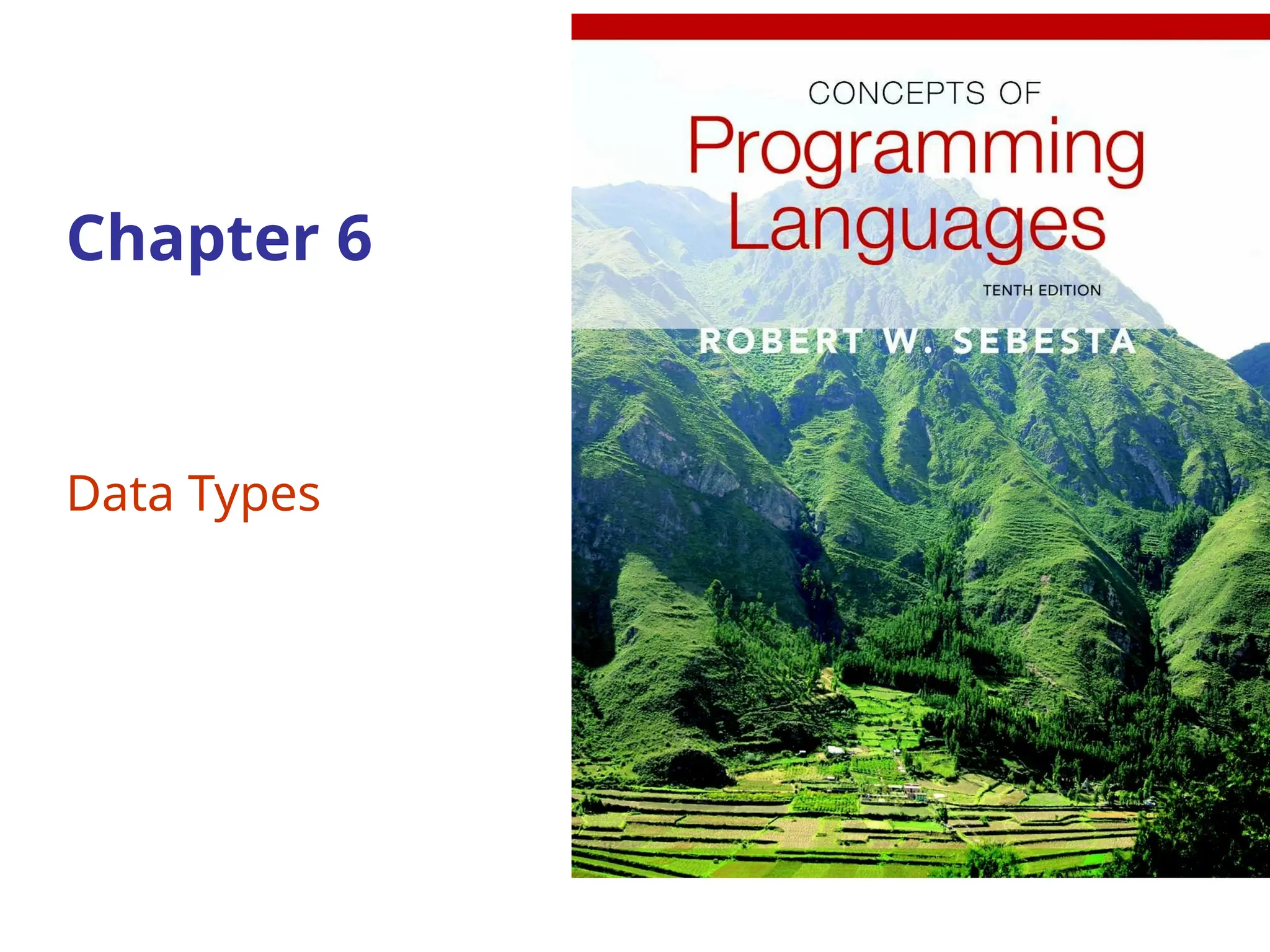
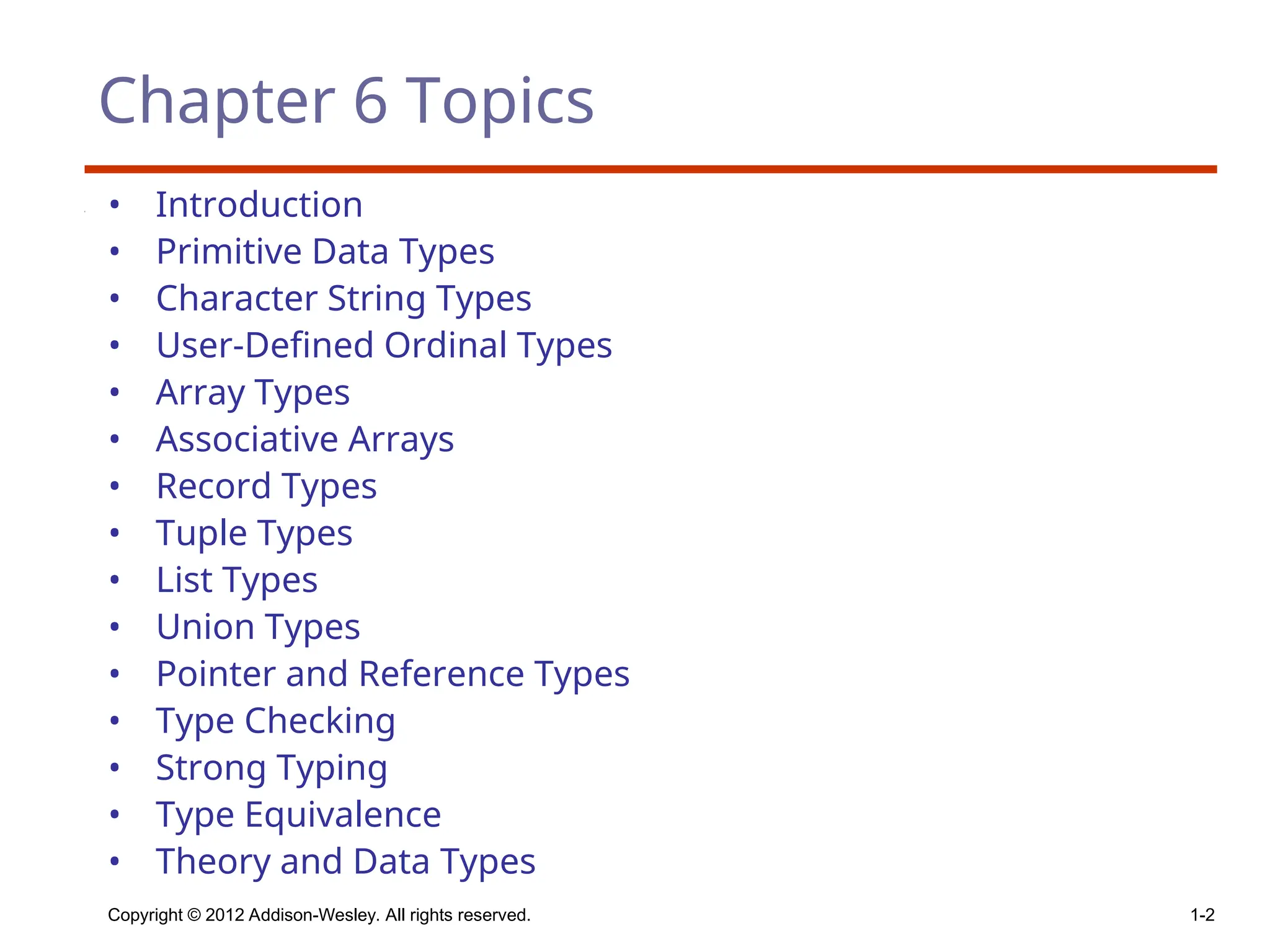
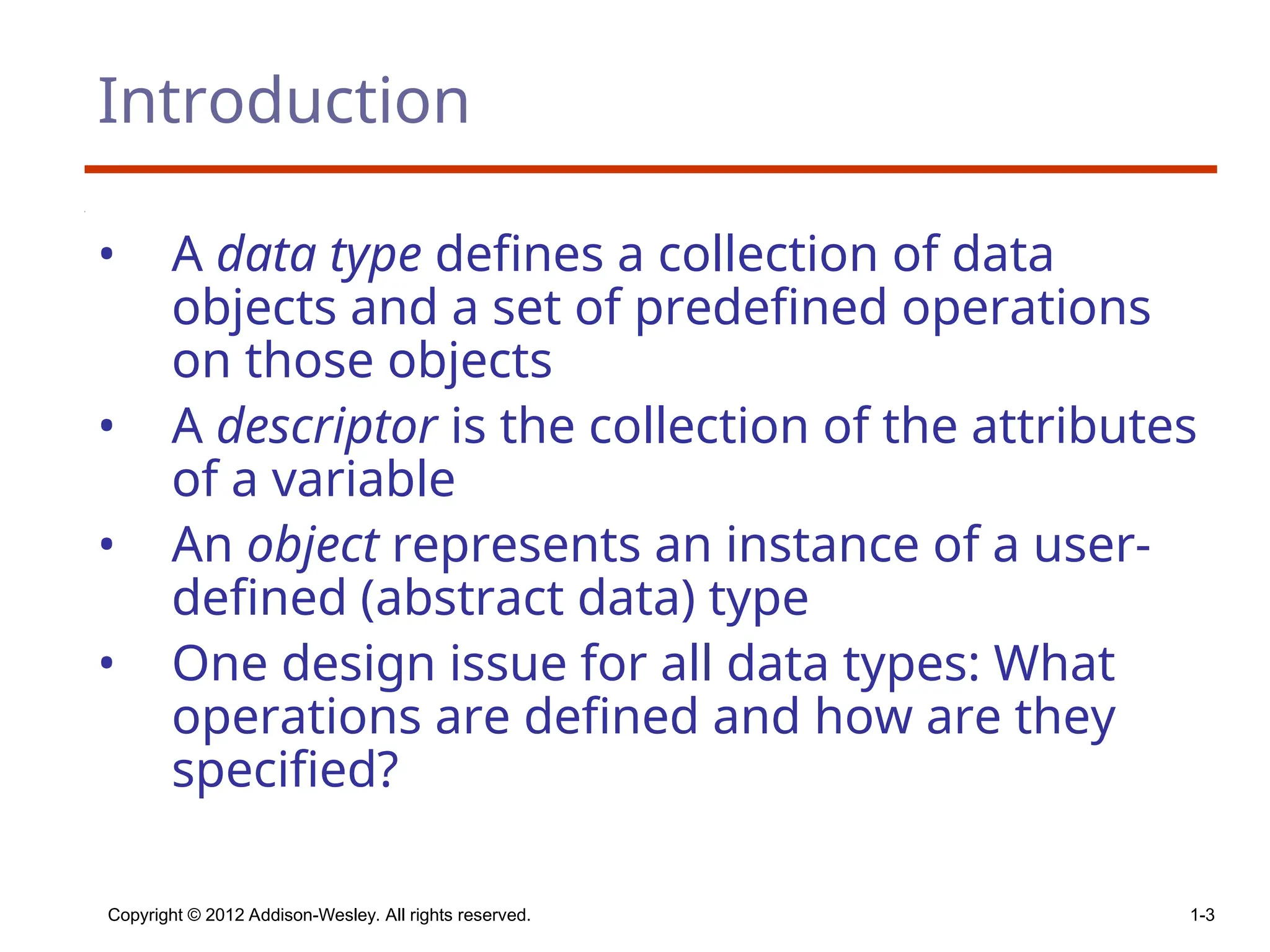
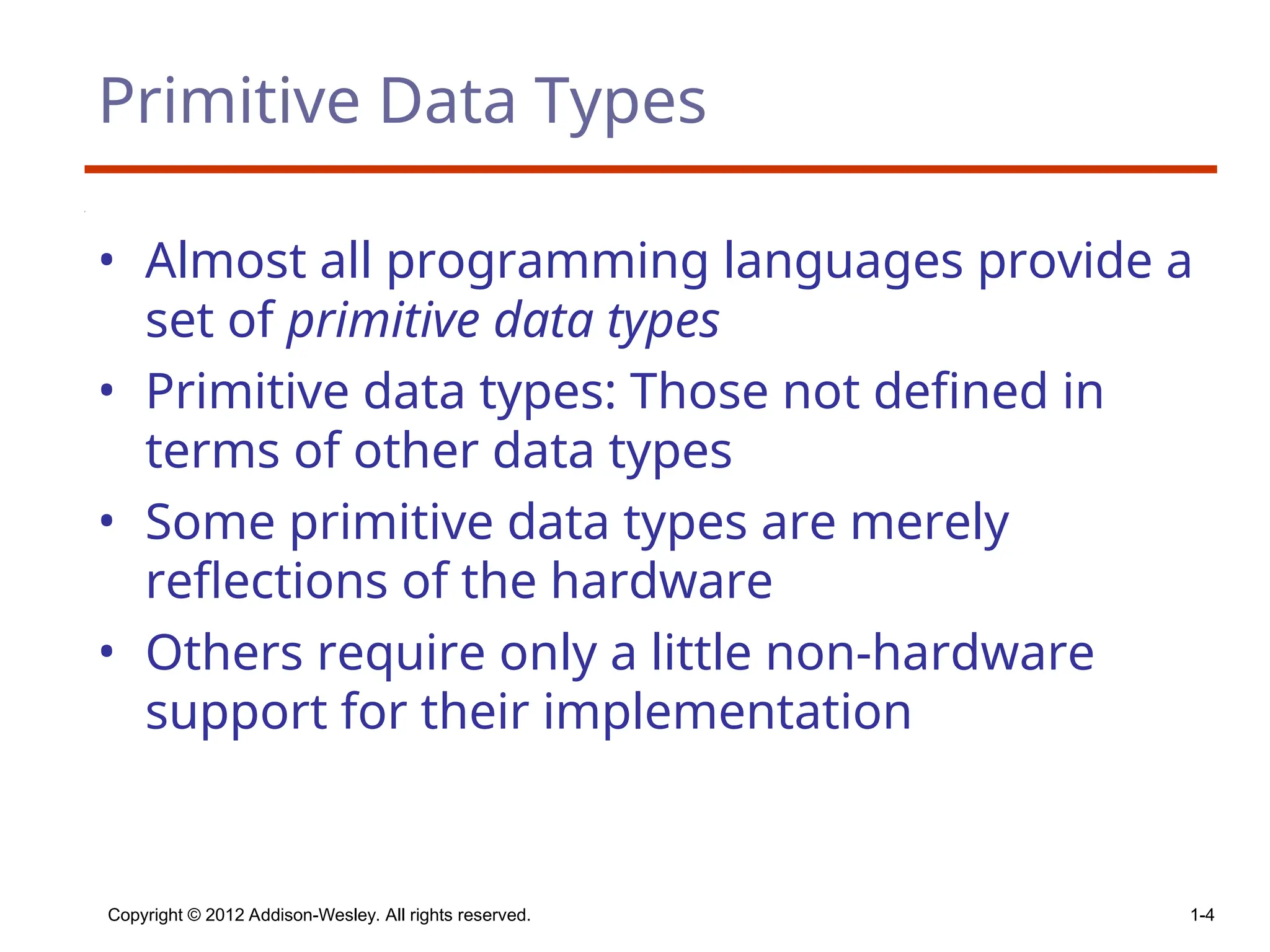
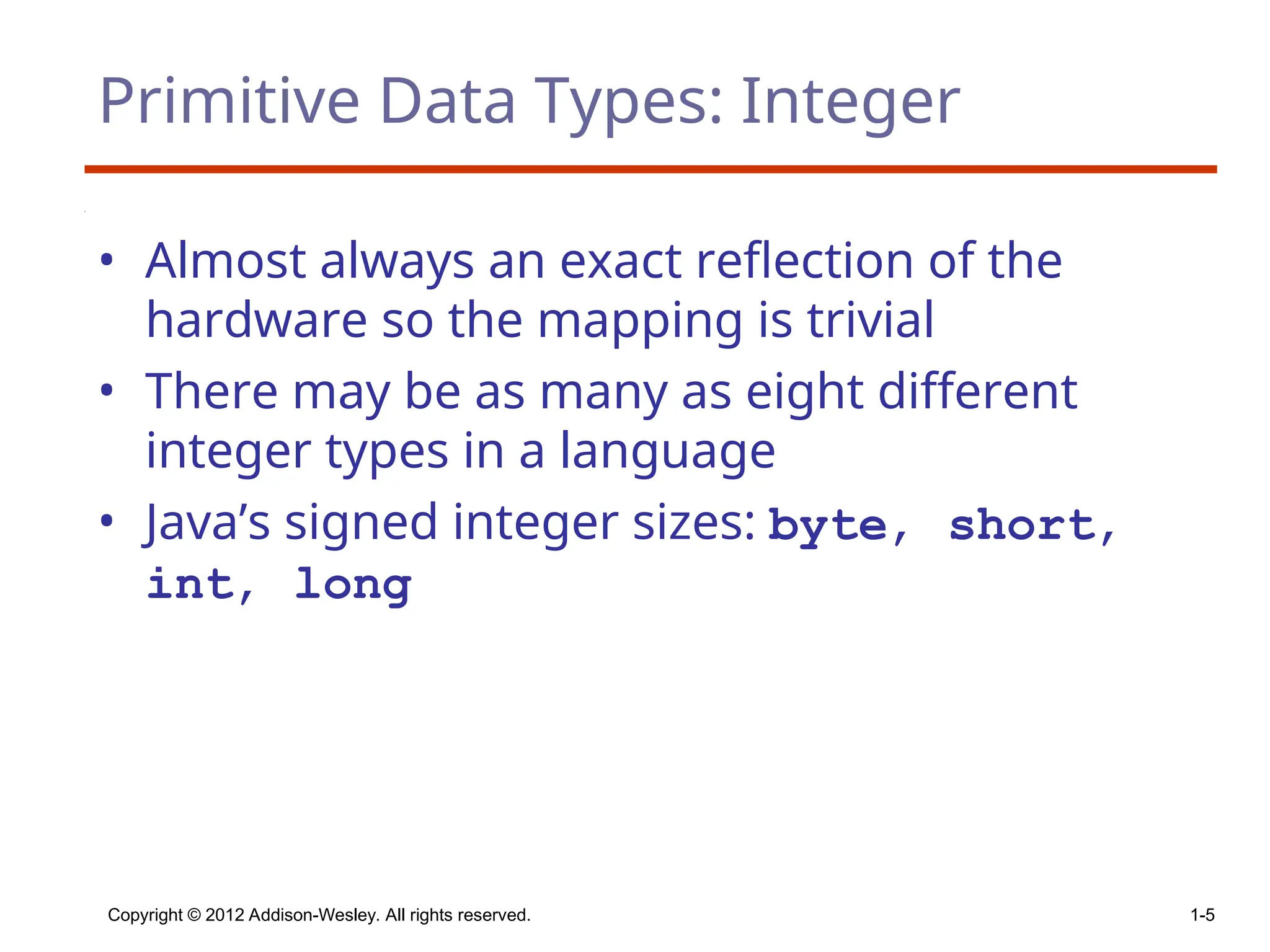
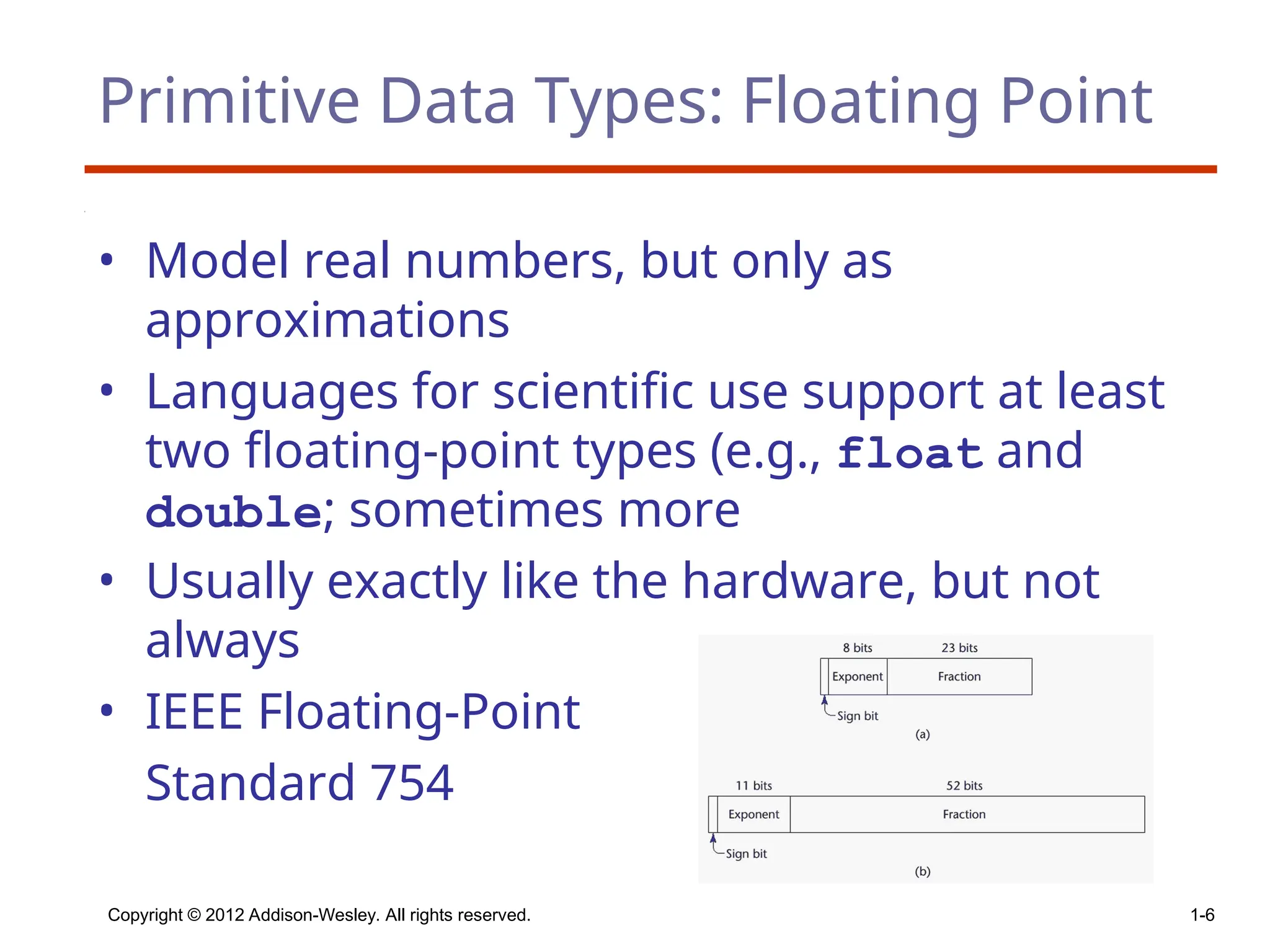
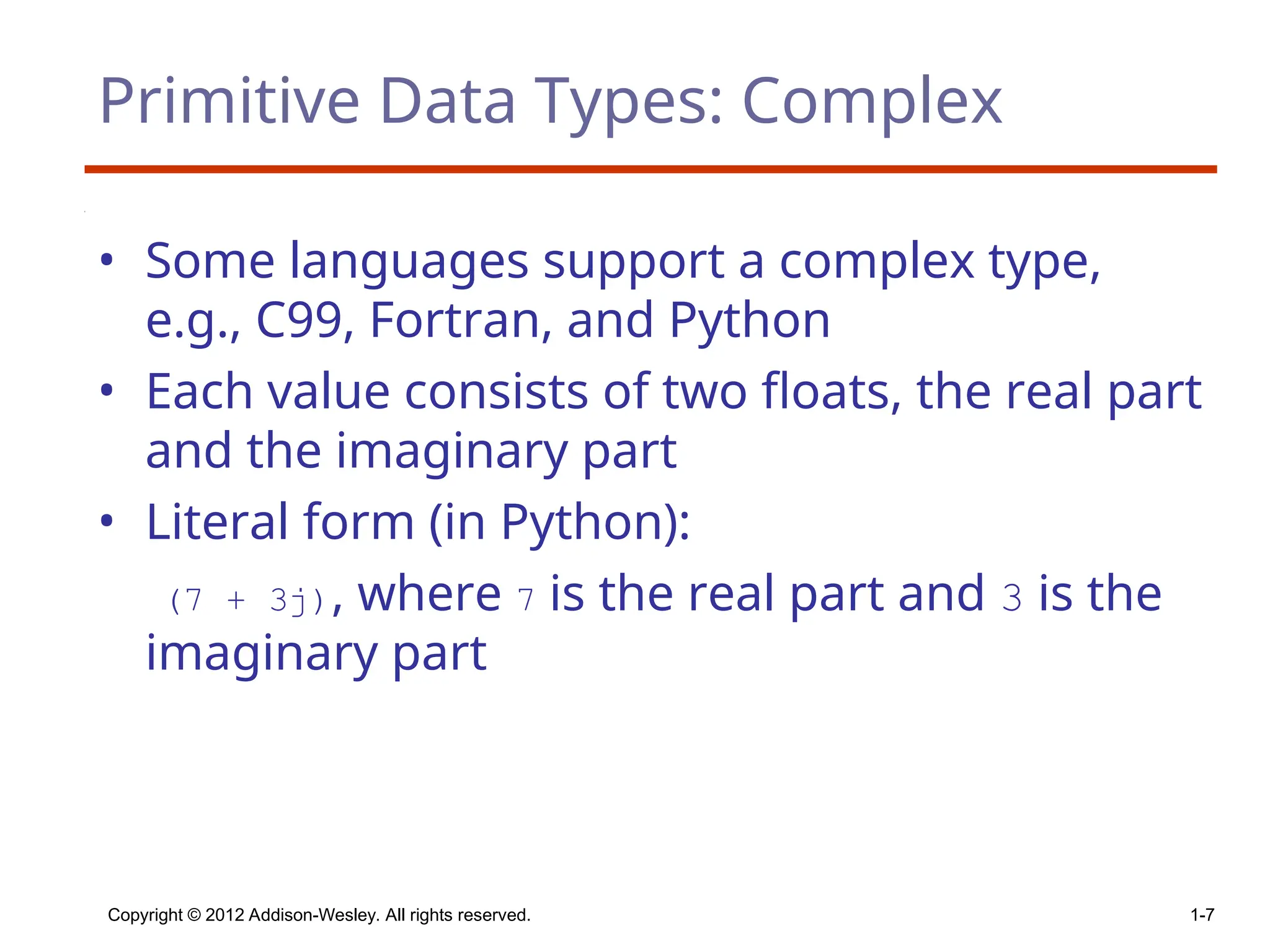
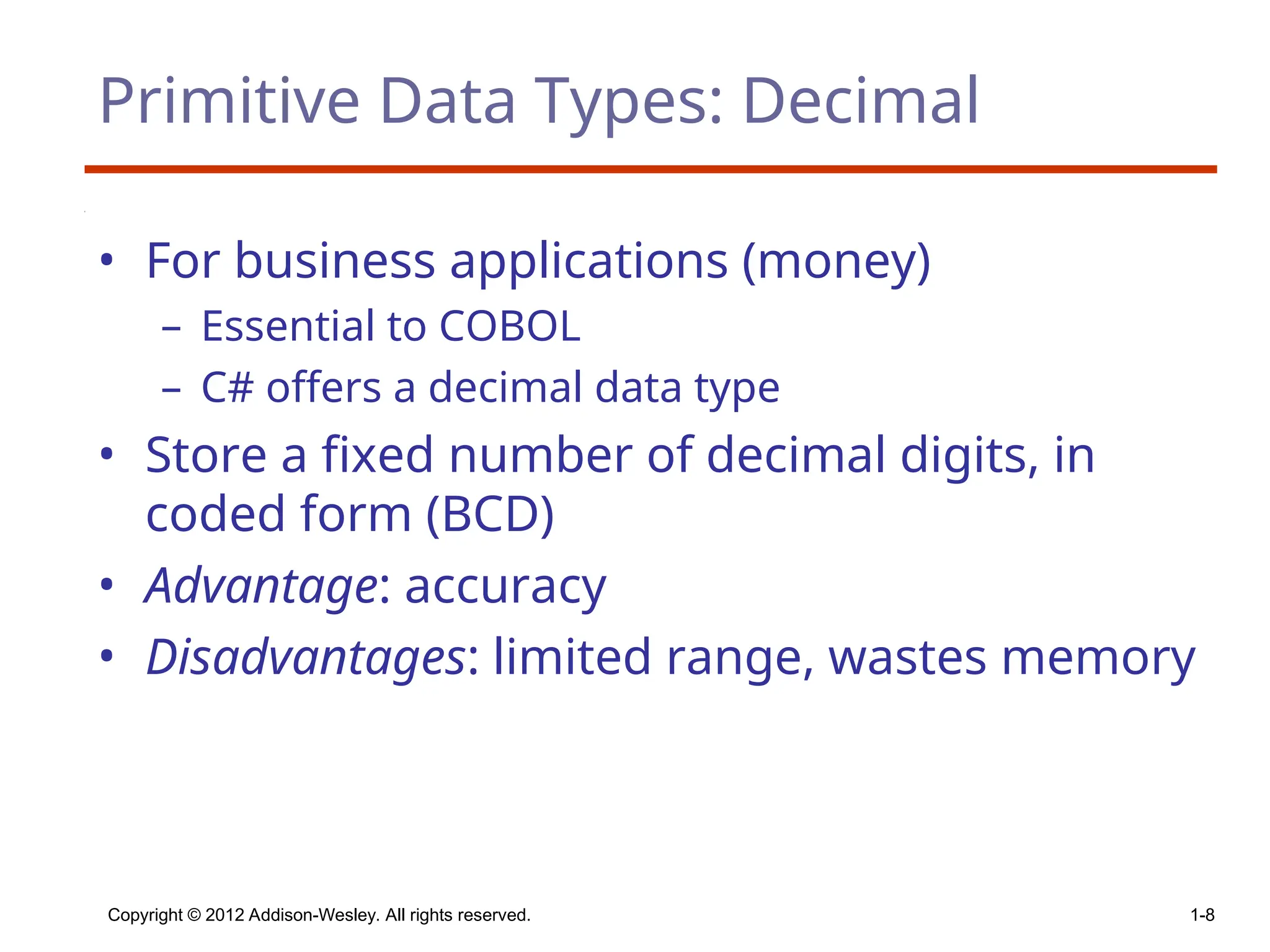
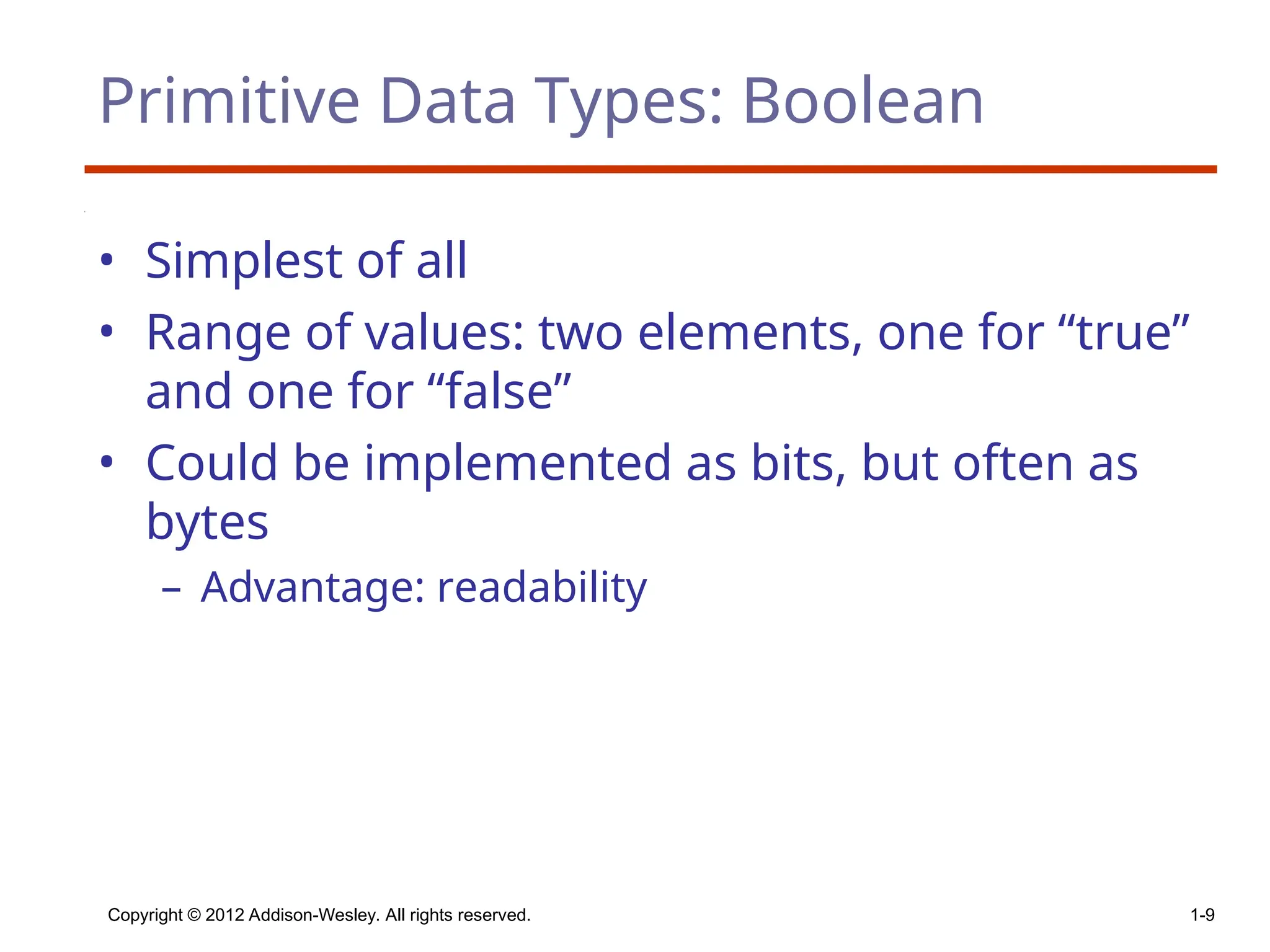
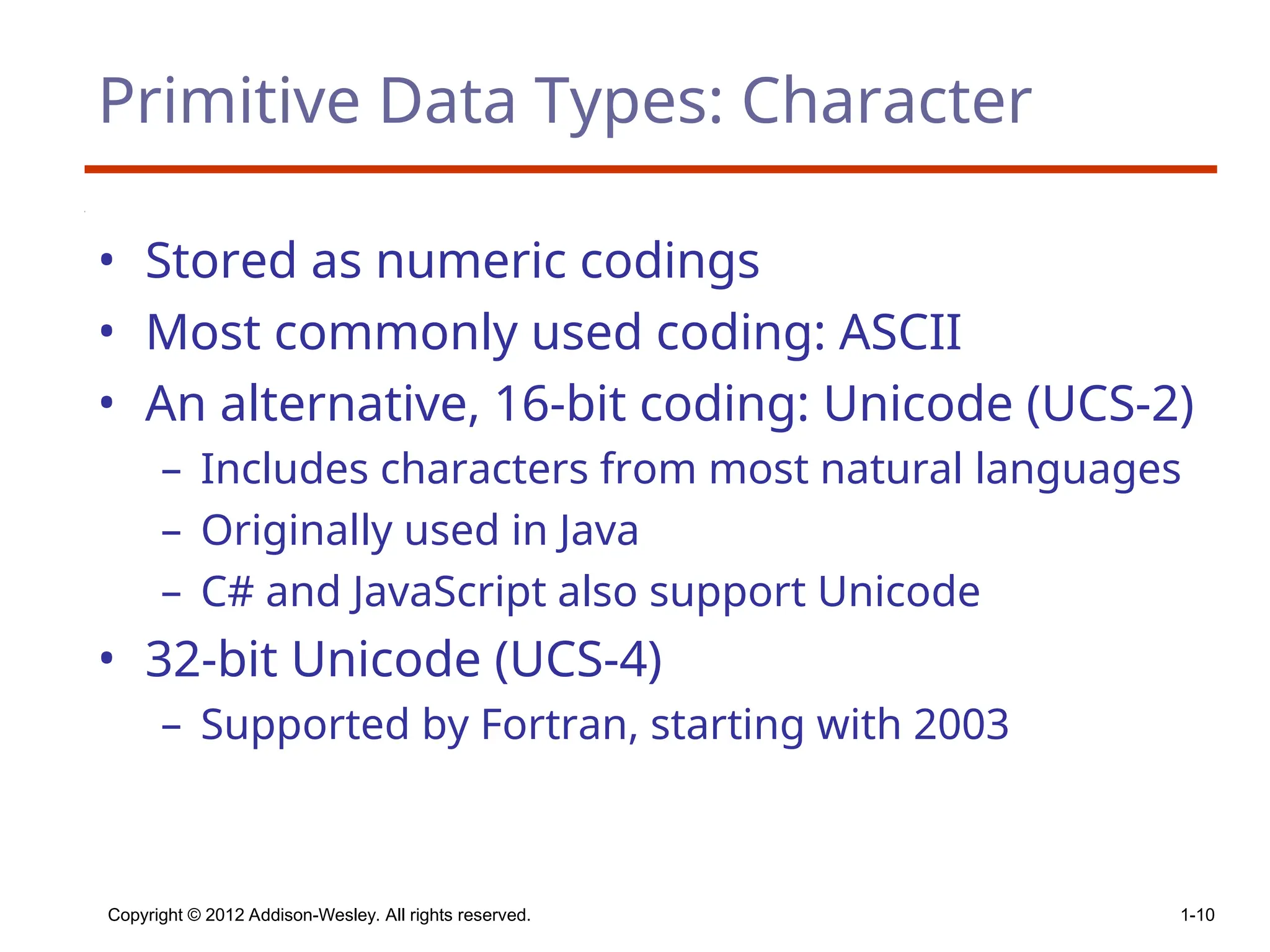
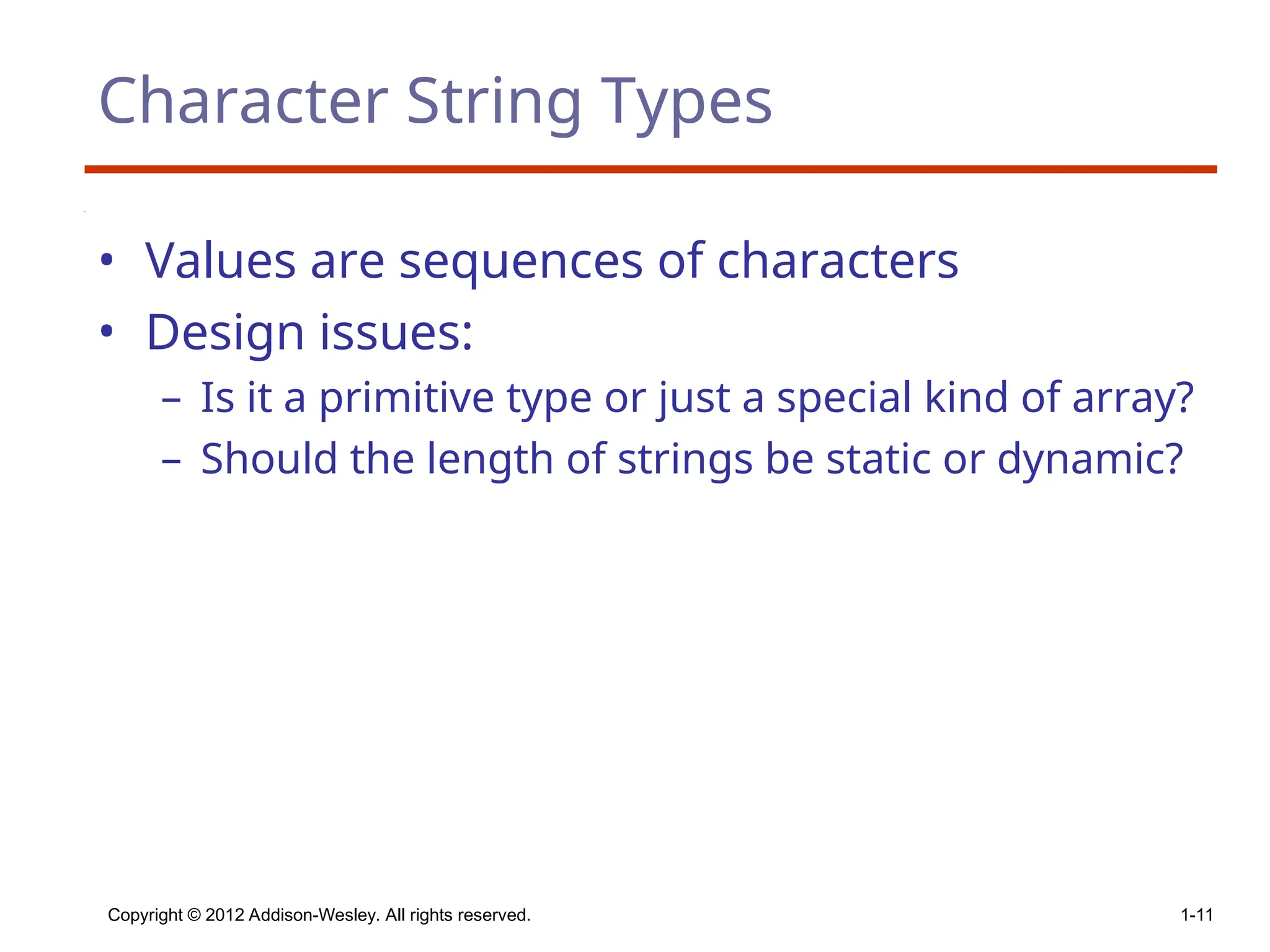
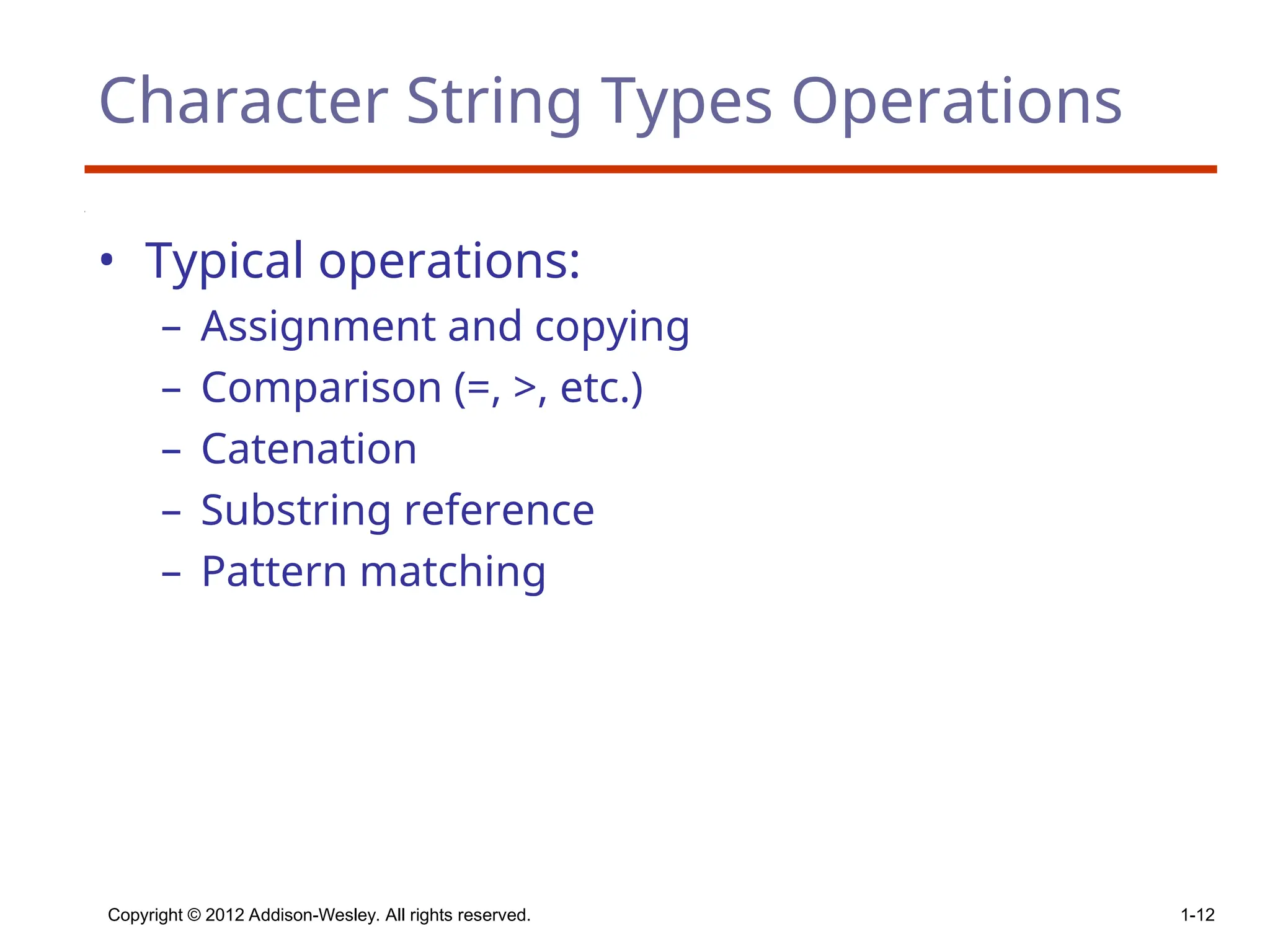
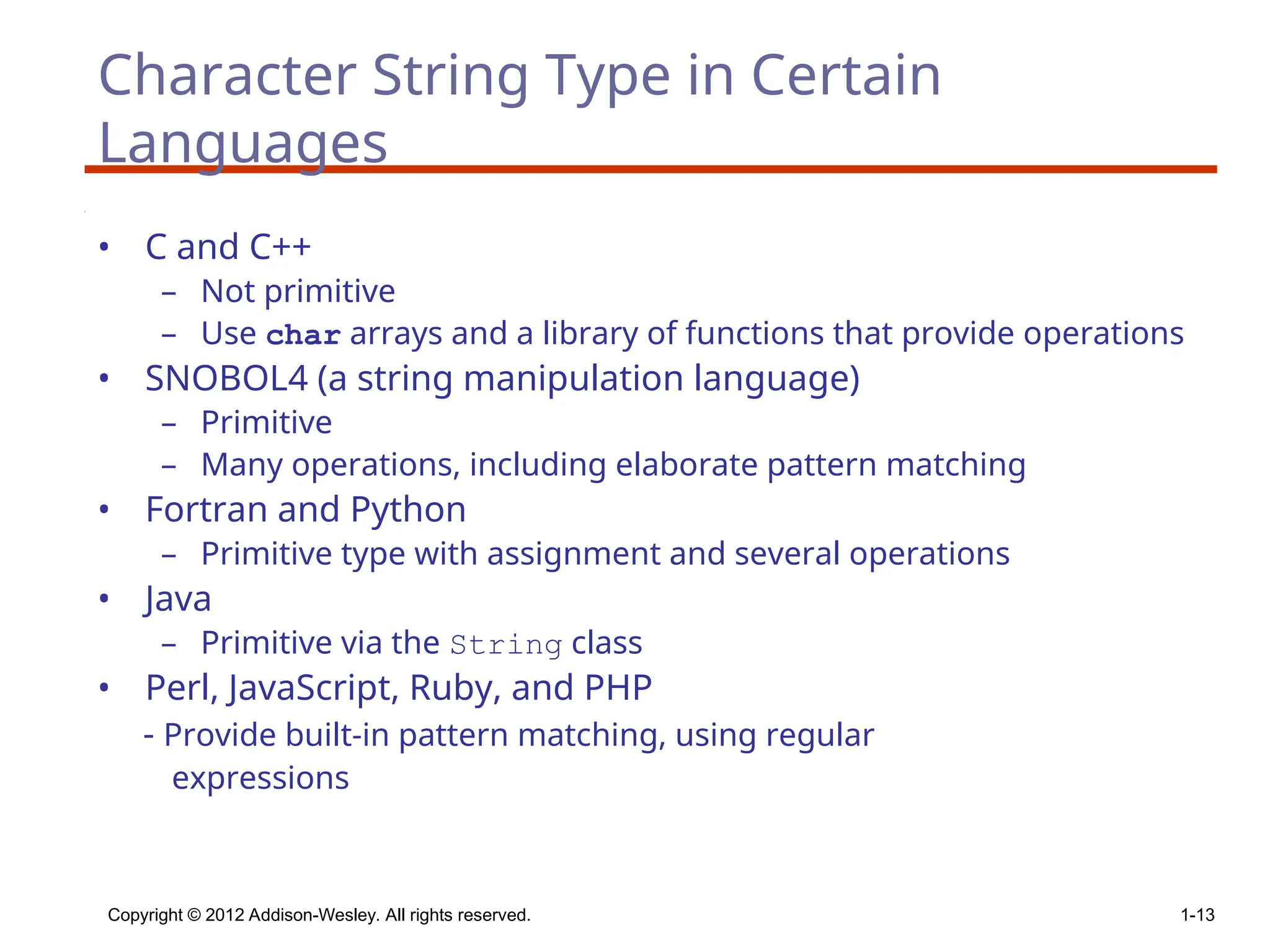
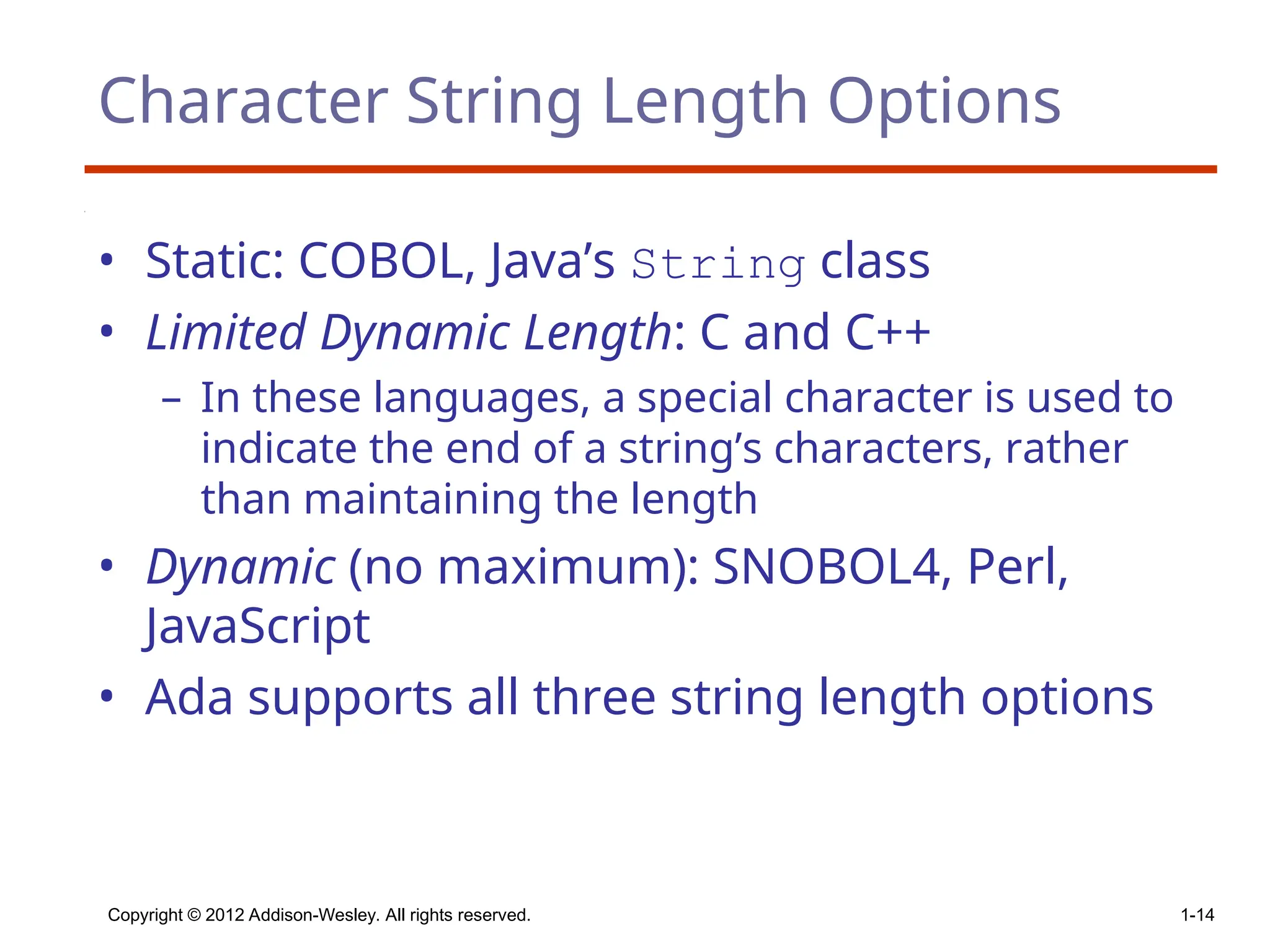
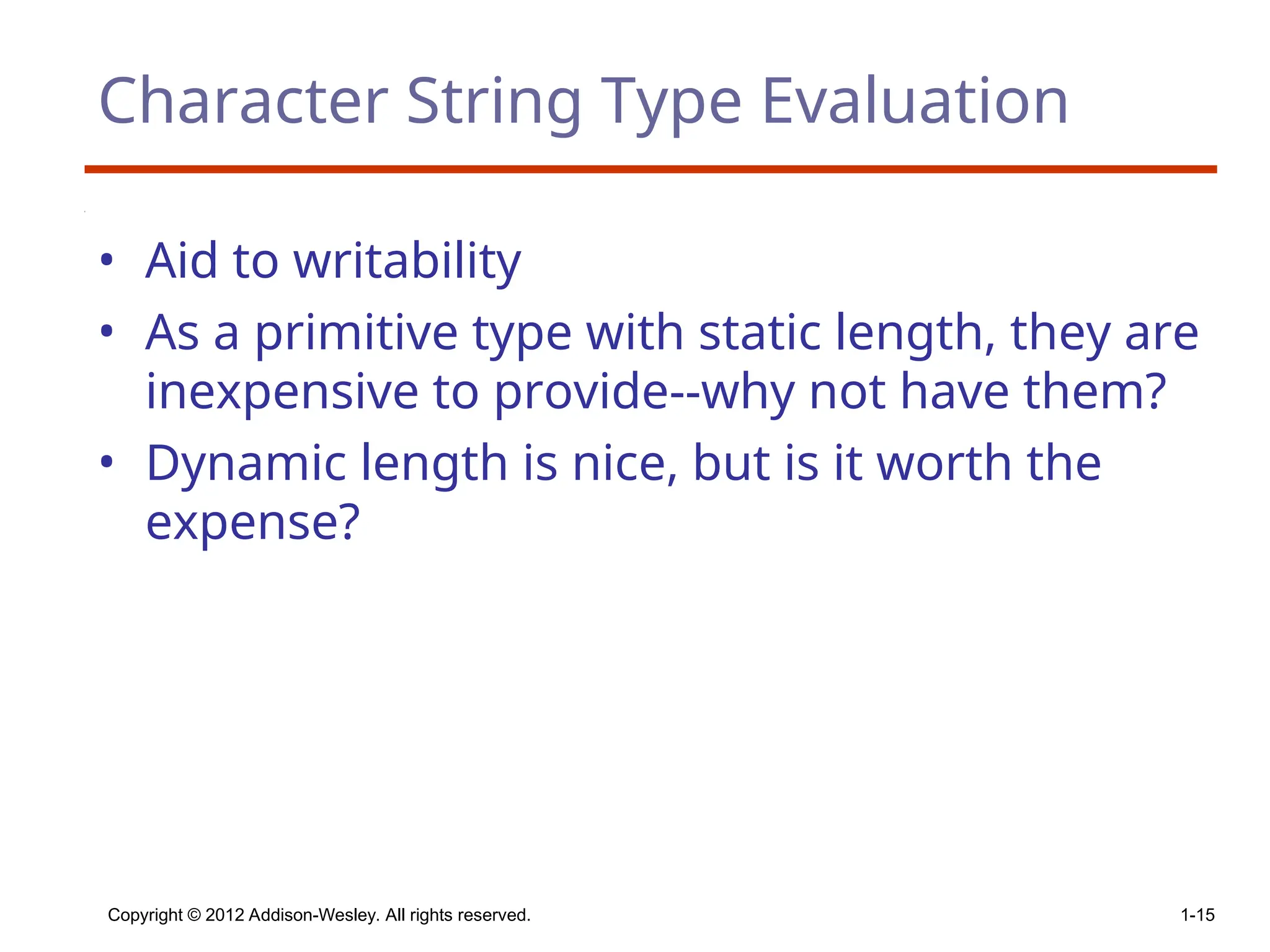
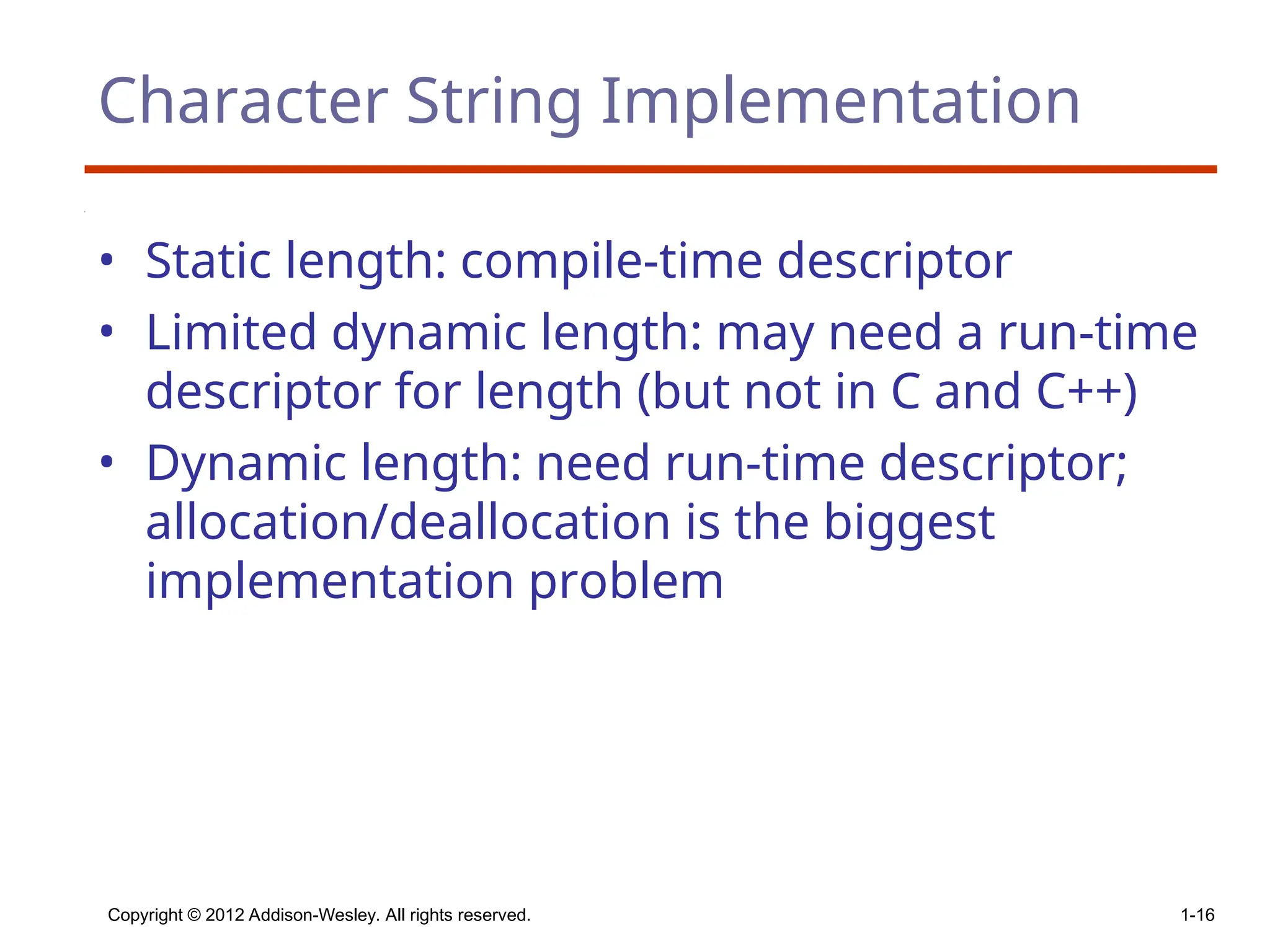
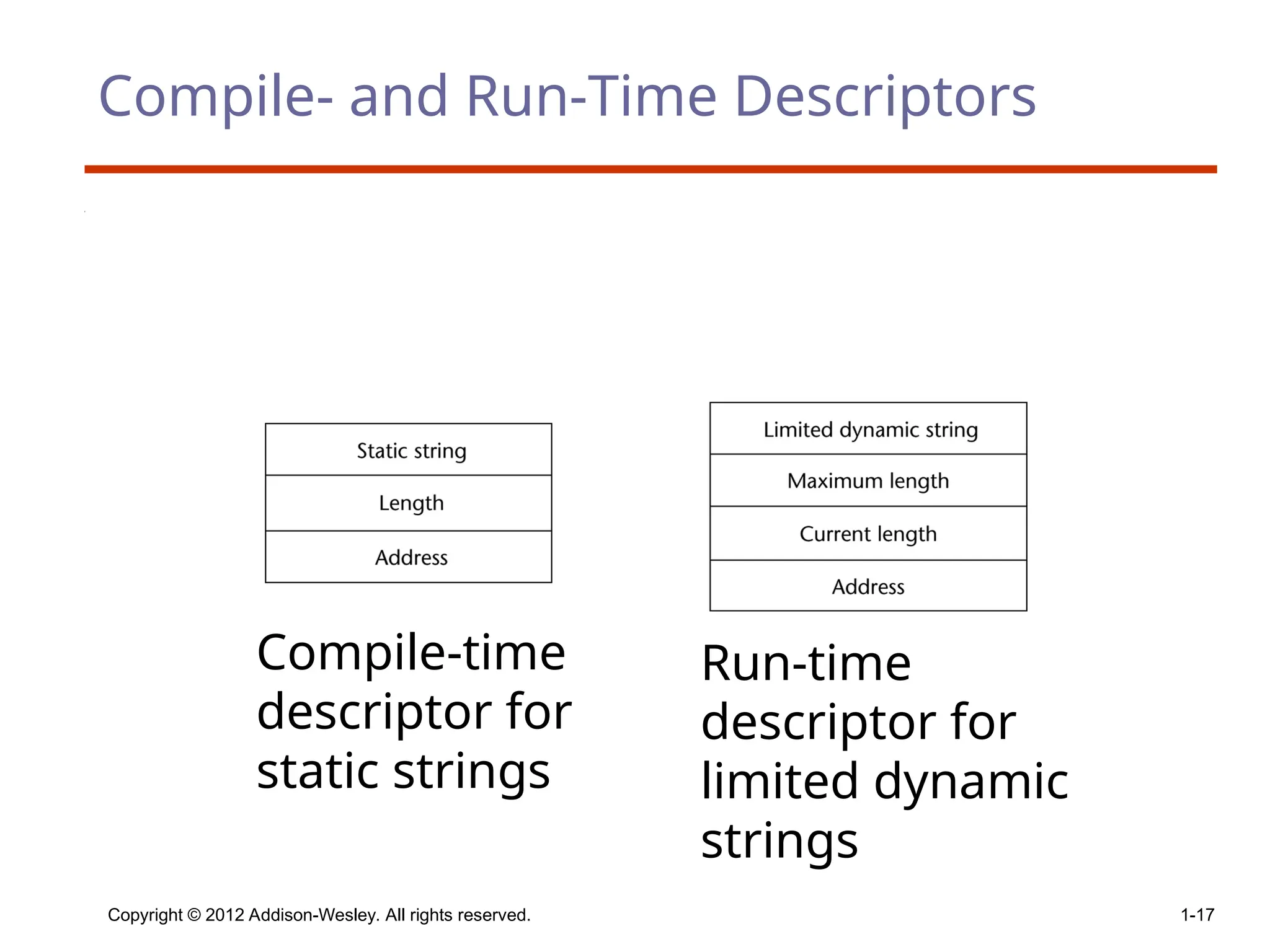
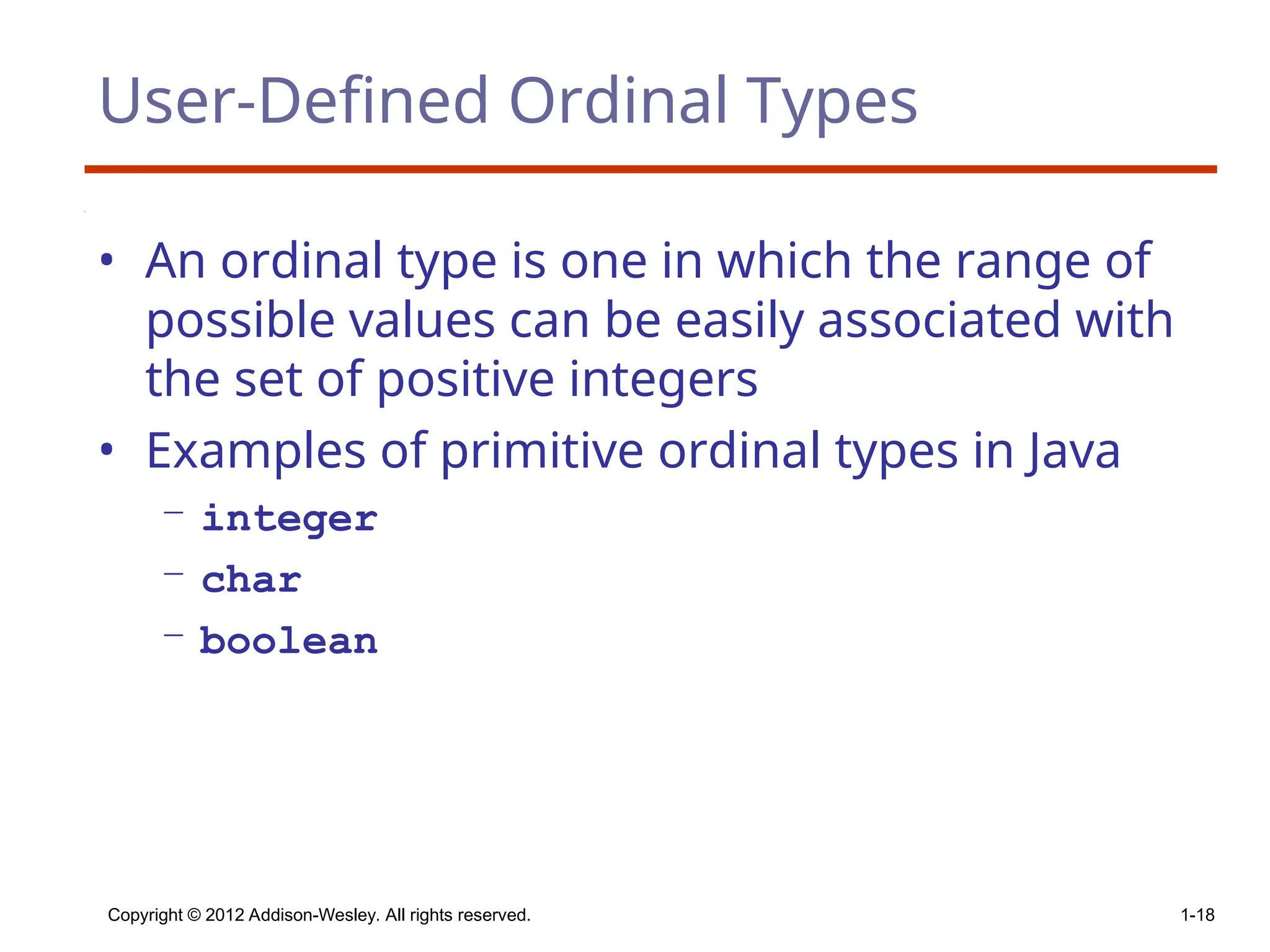
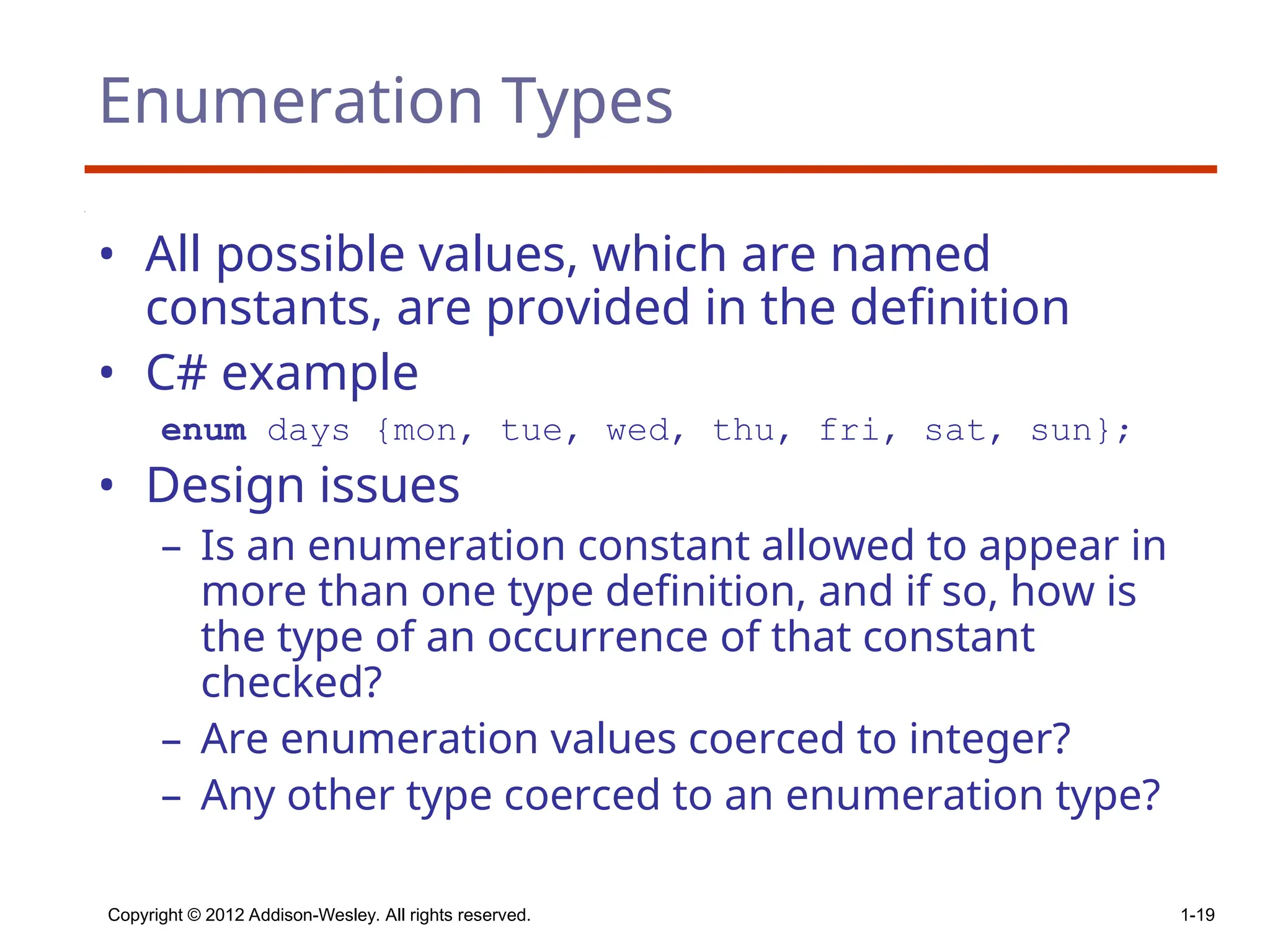
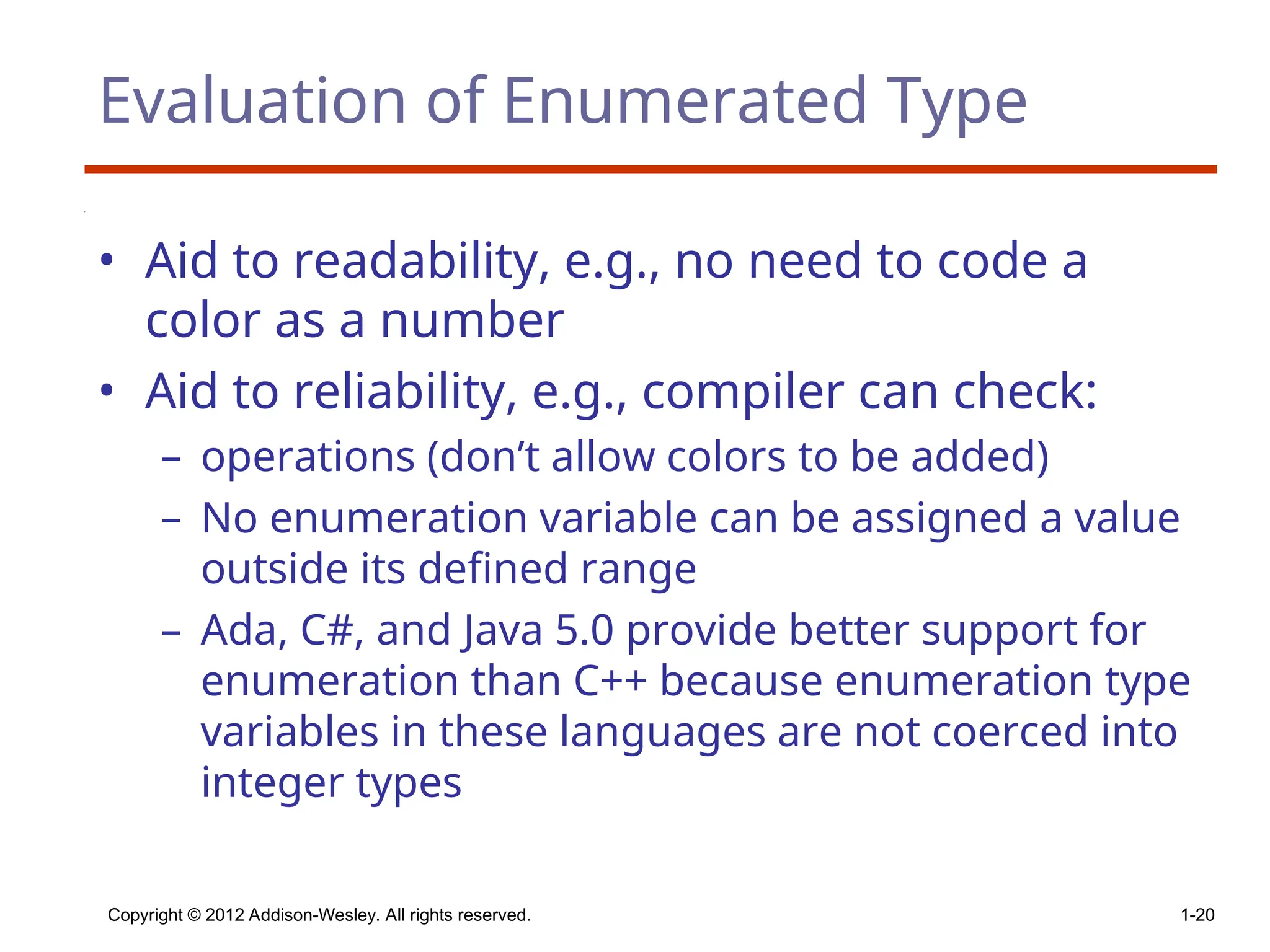
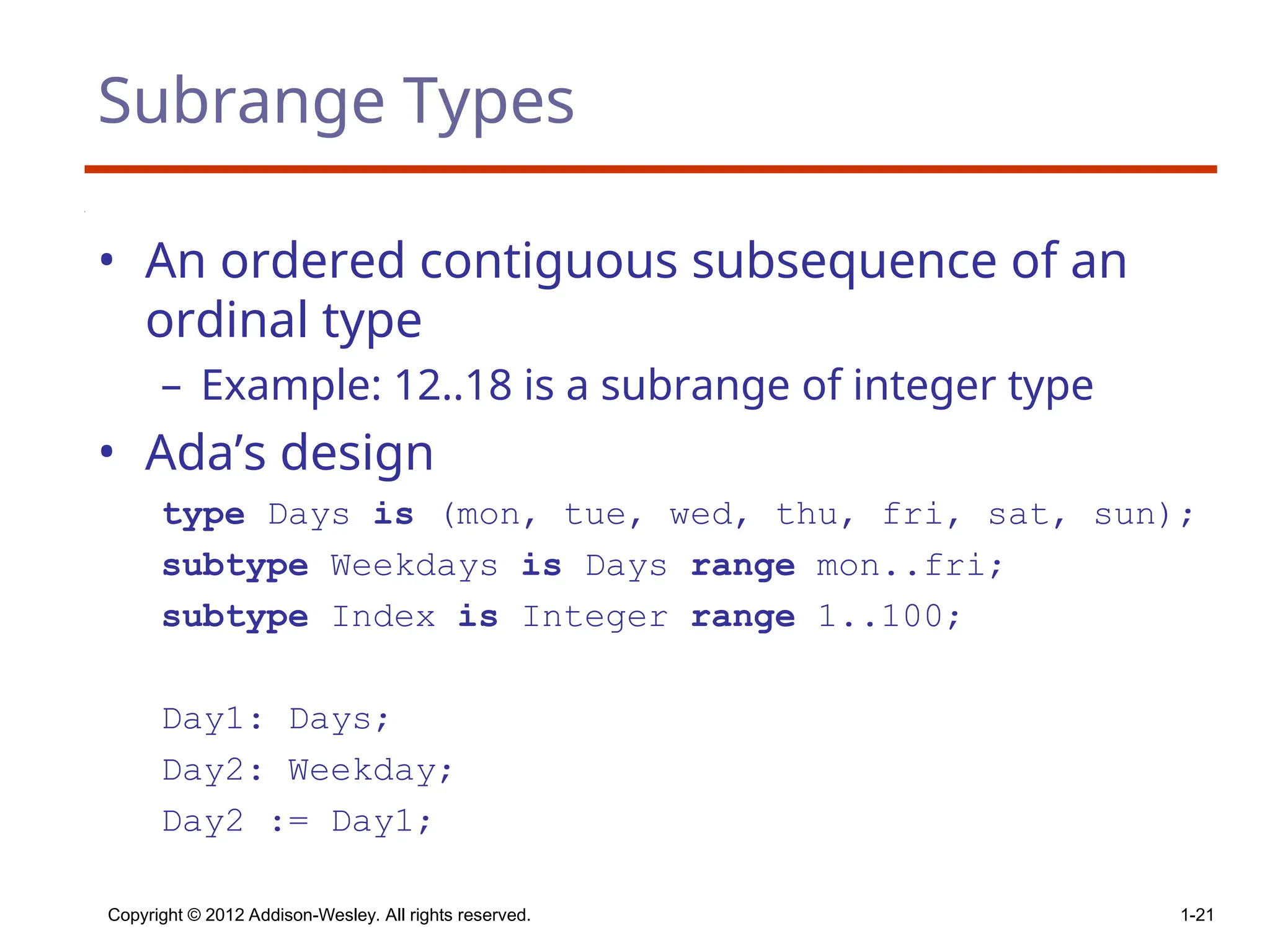
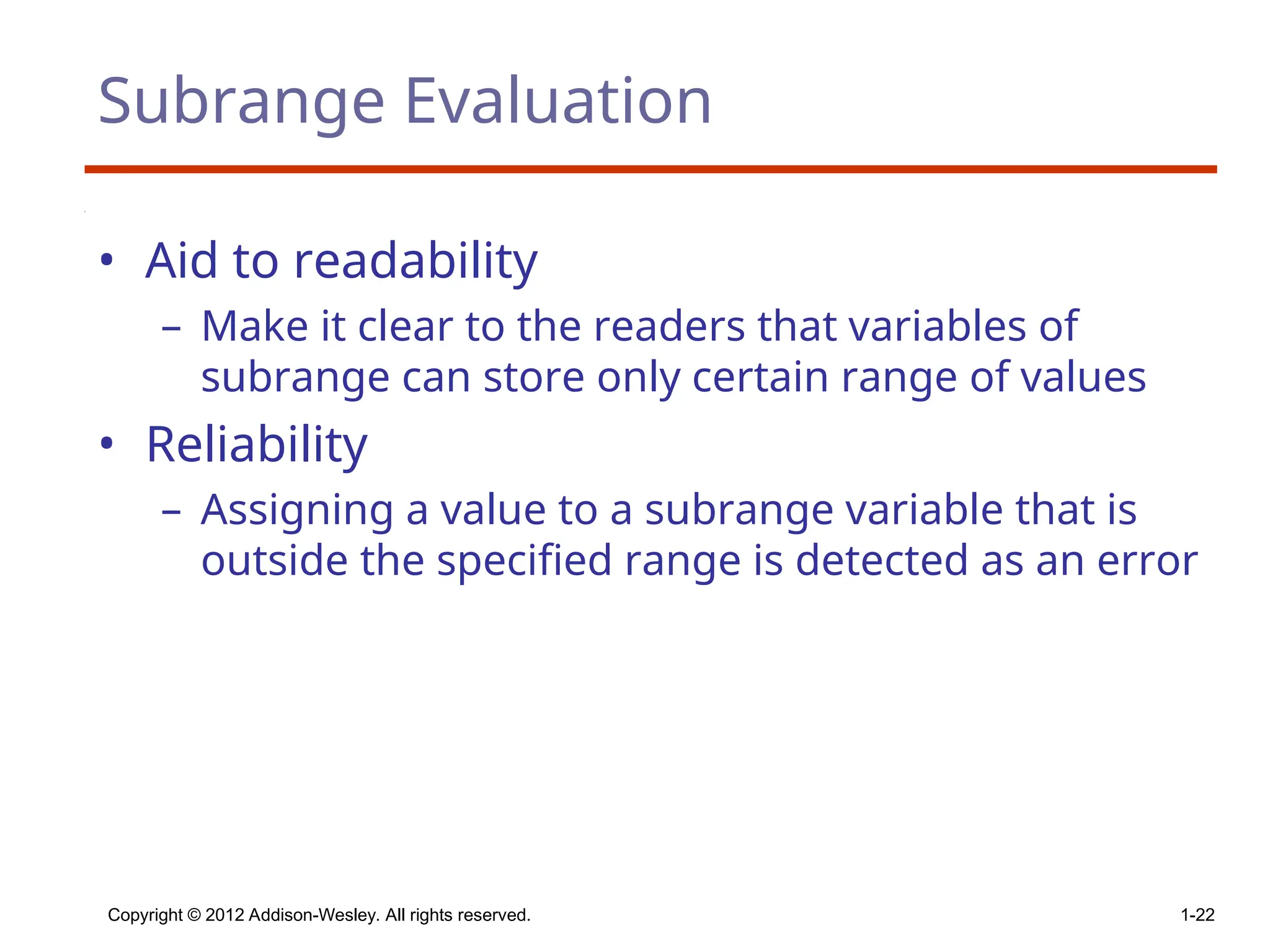
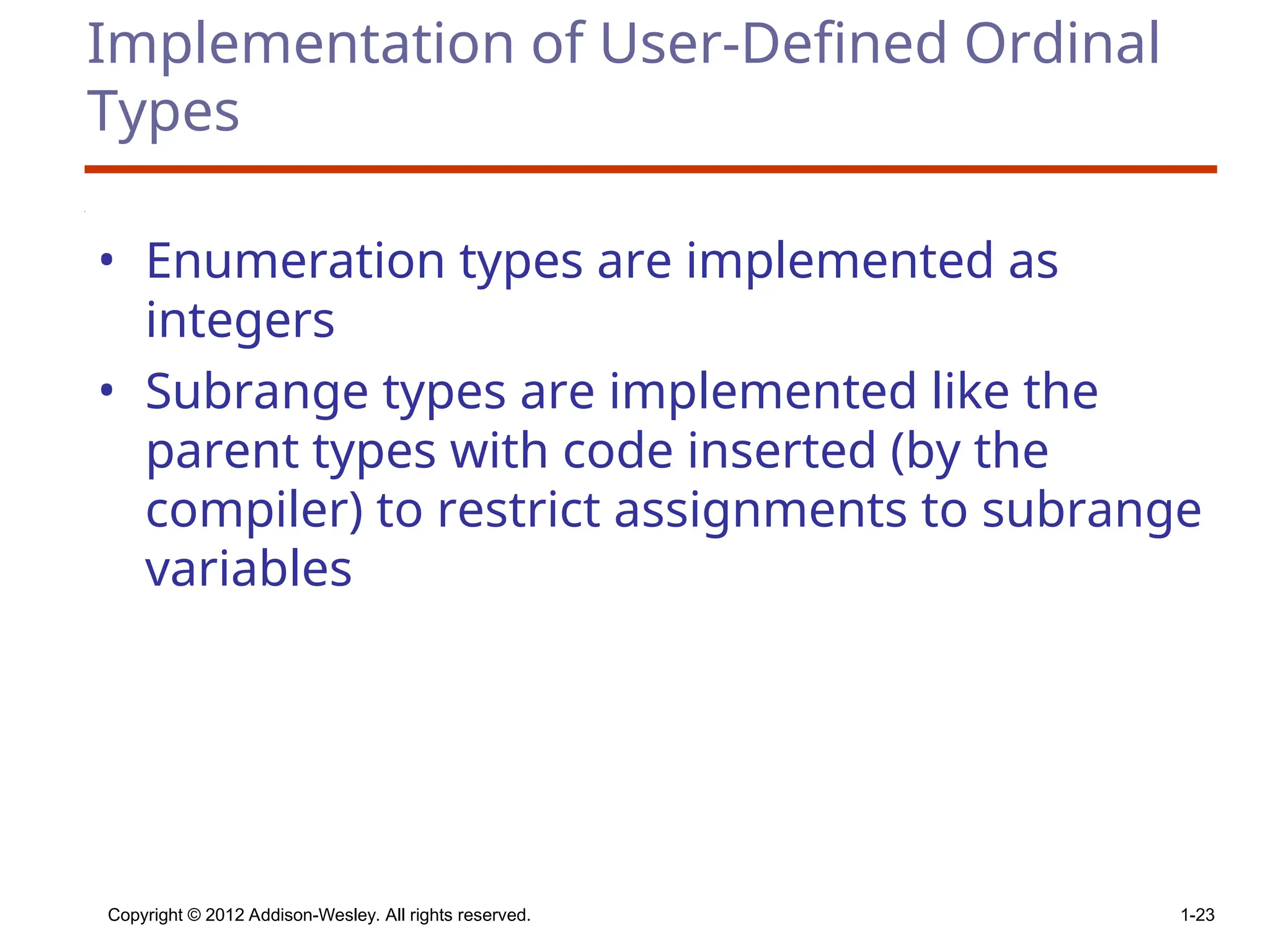
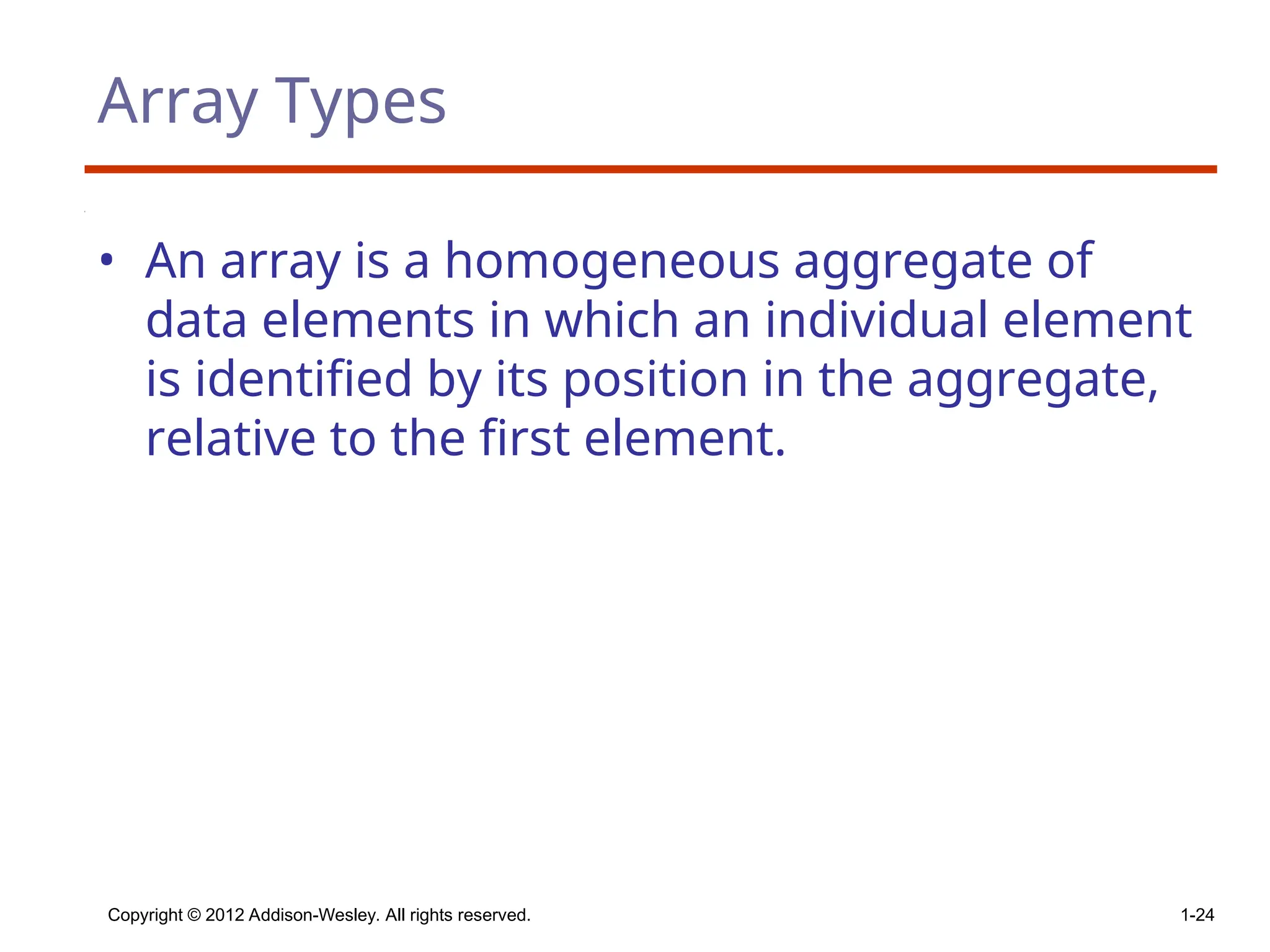
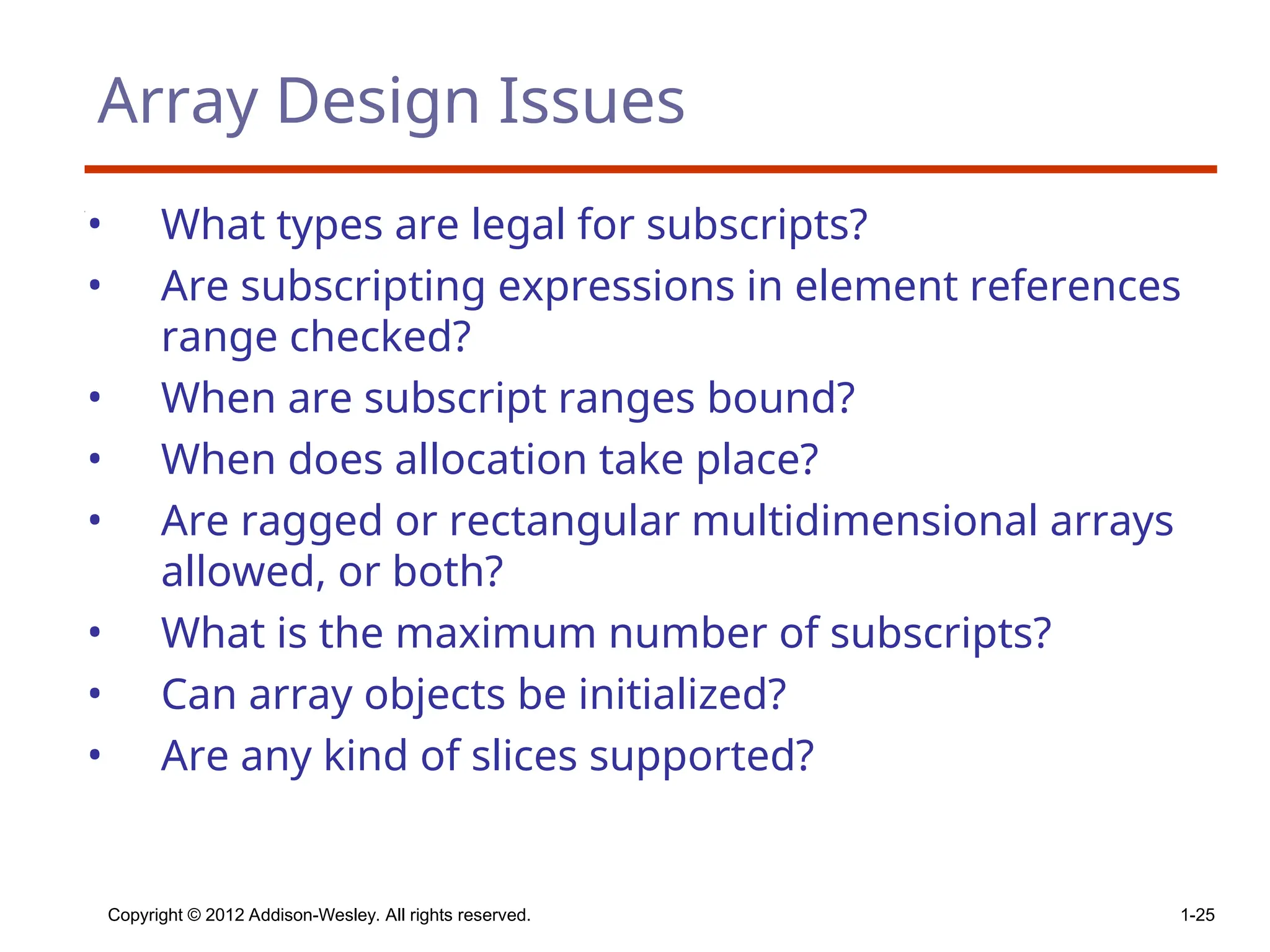
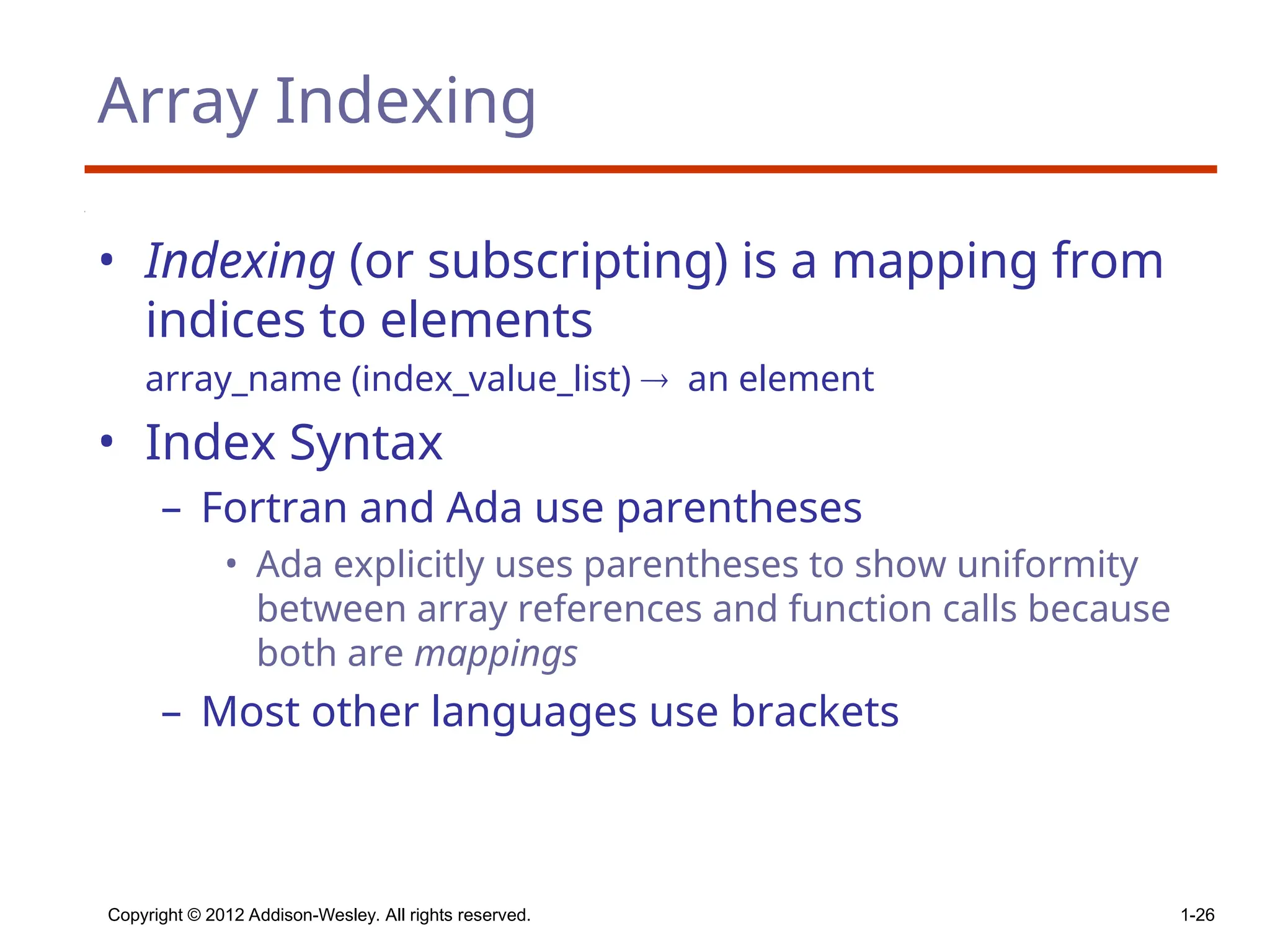
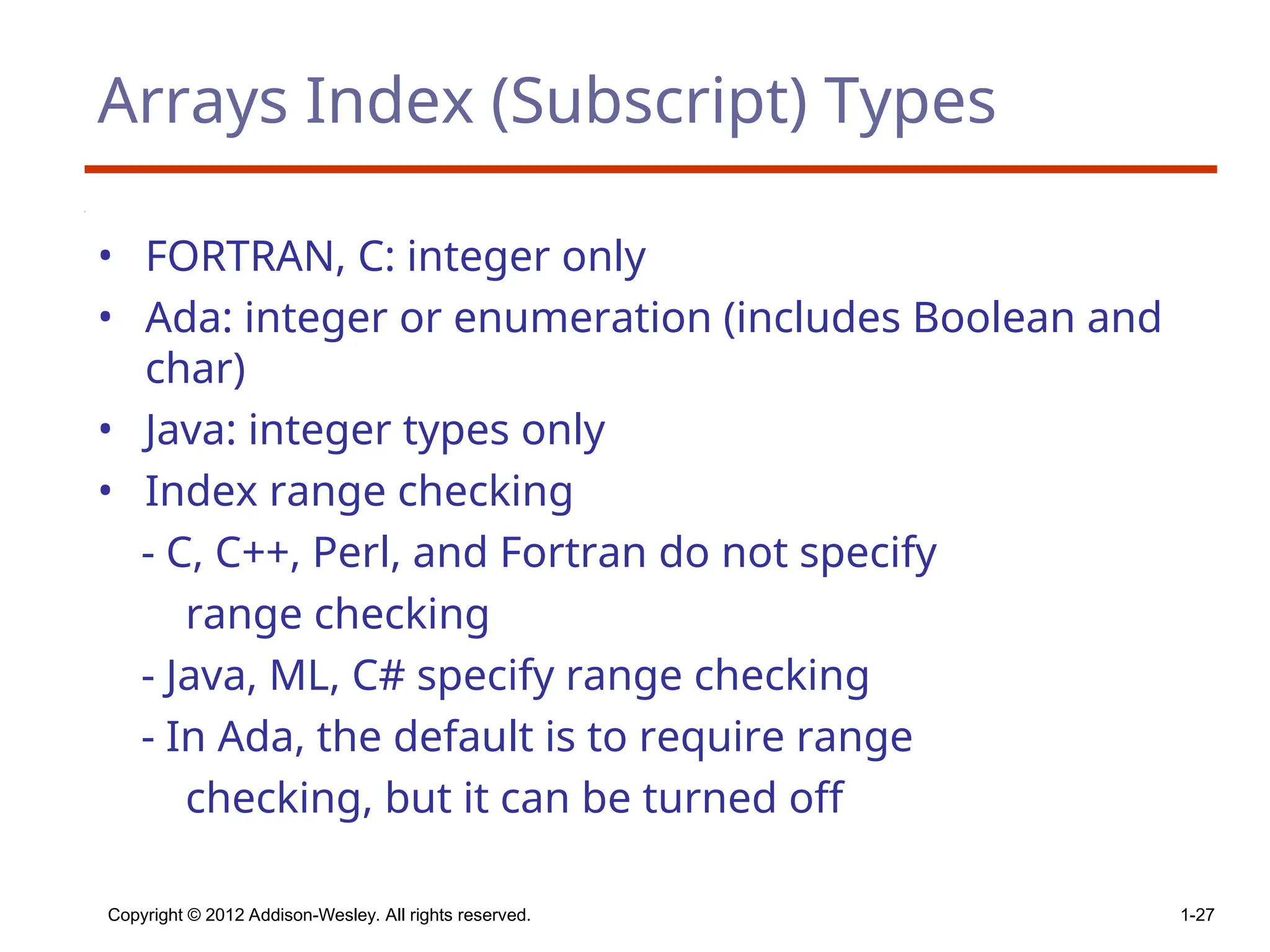
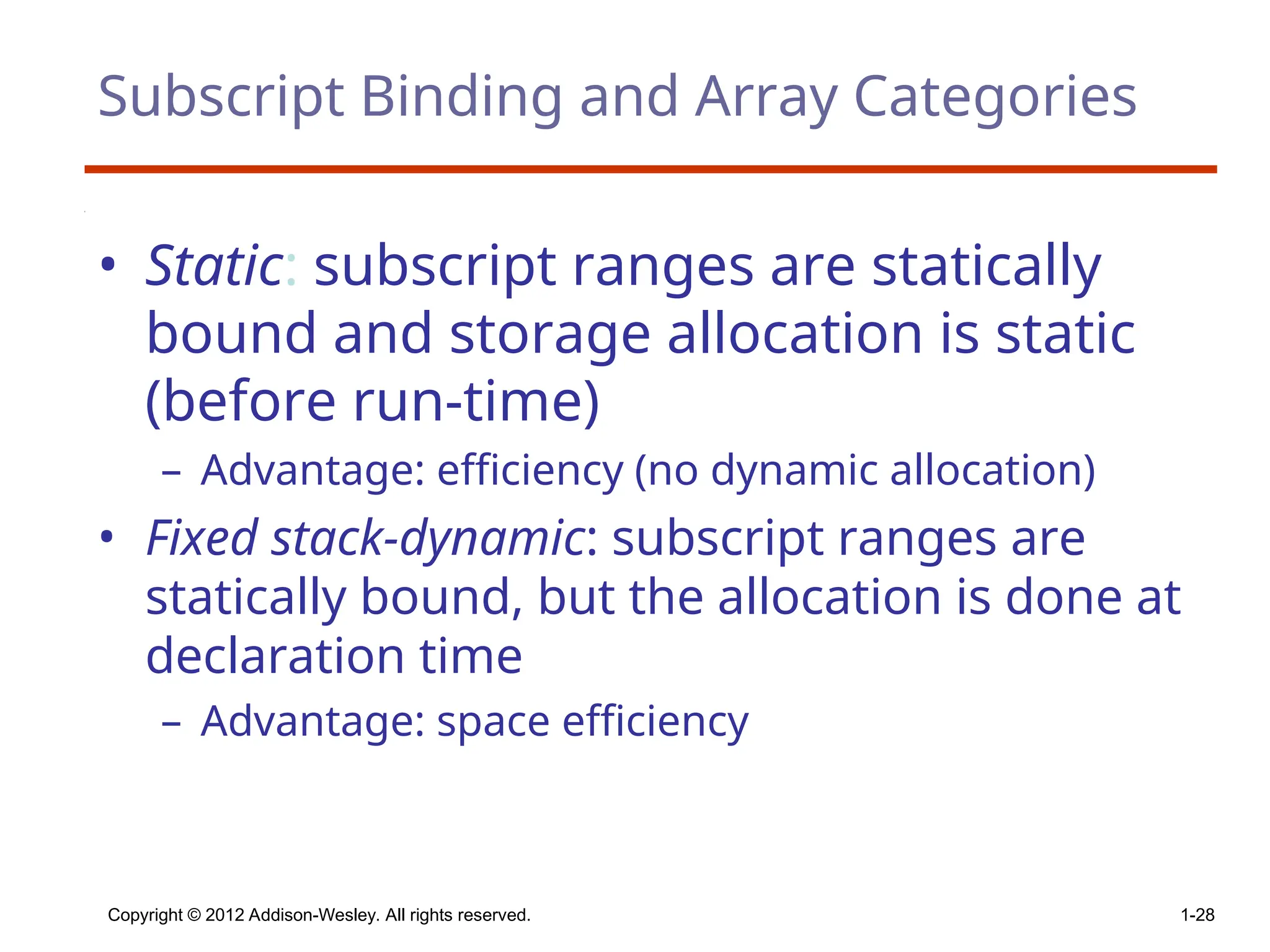
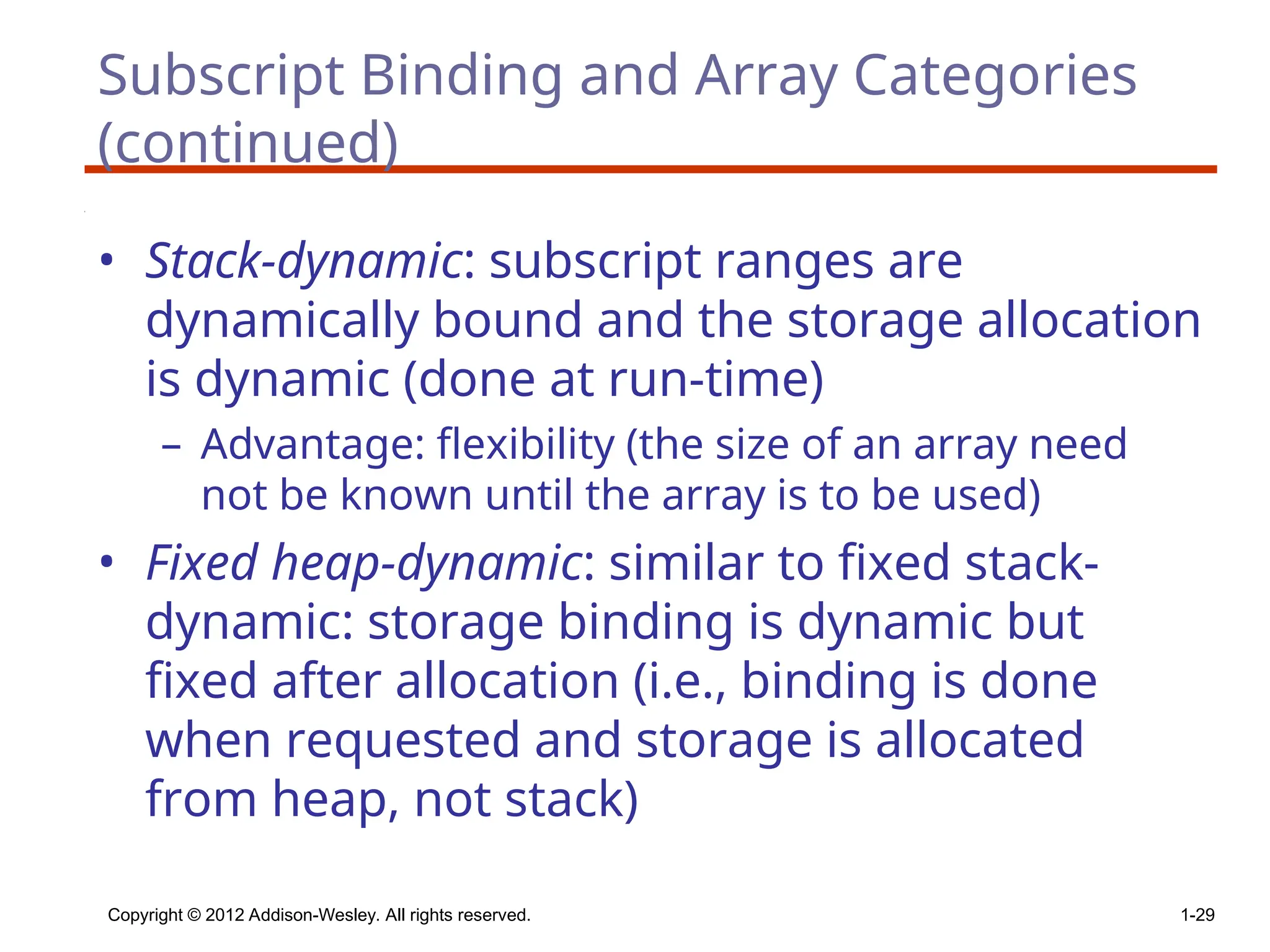
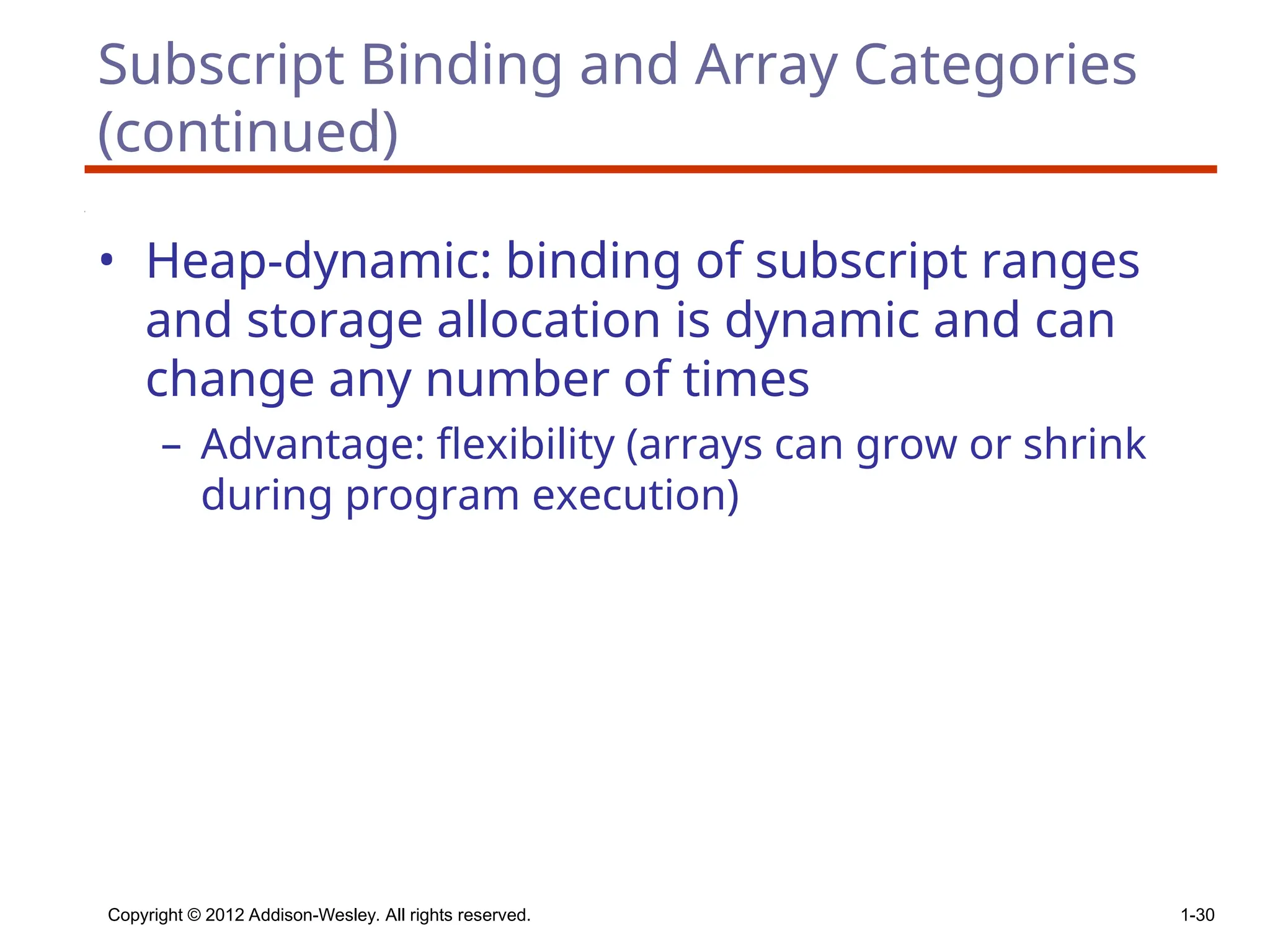
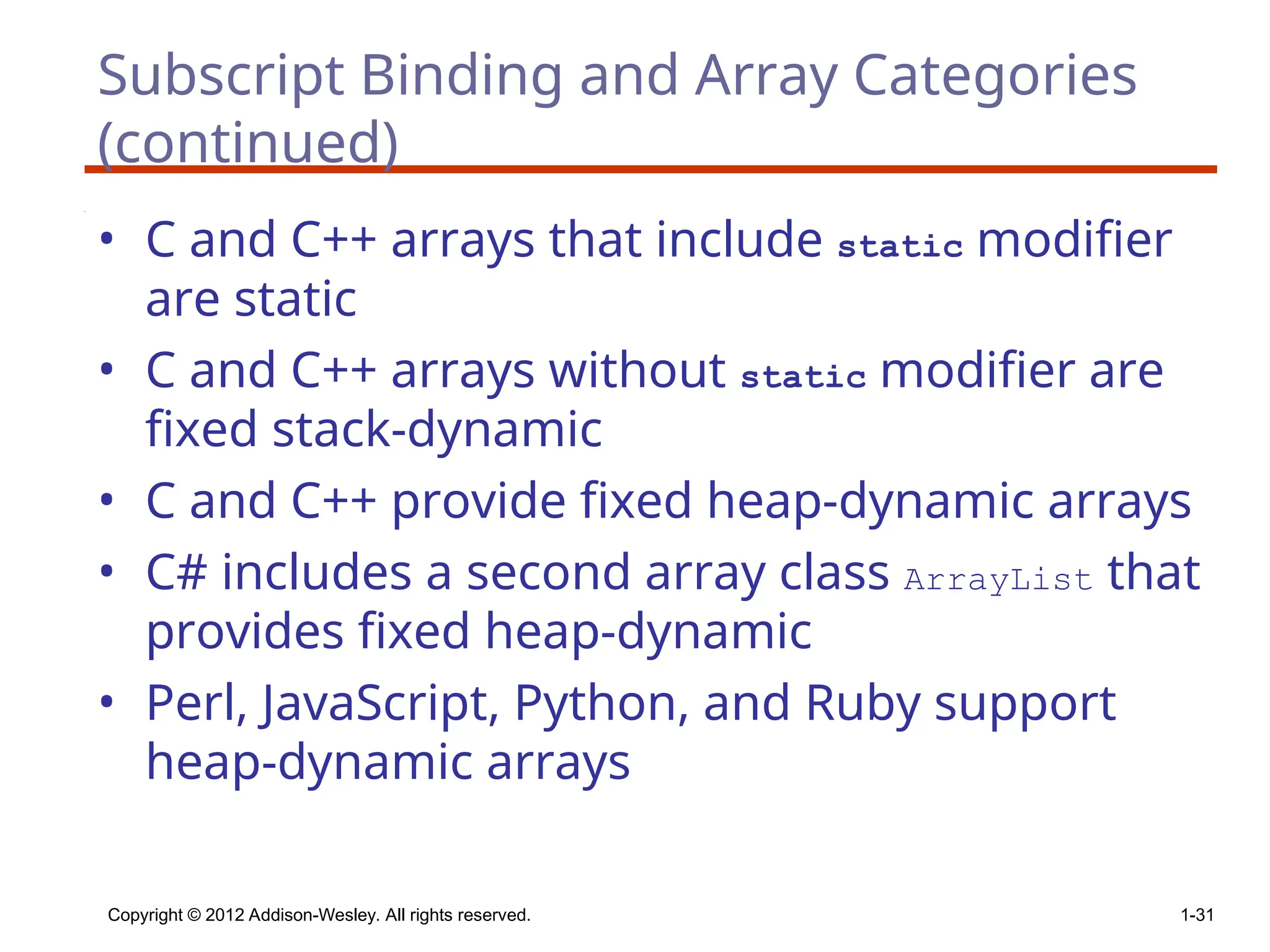
![Copyright © 2012 Addison-Wesley. All rights reserved. 1-32 Array Initialization • Some language allow initialization at the time of storage allocation – C, C++, Java, C# example int list [] = {4, 5, 7, 83} – Character strings in C and C++ char name [] = ″freddie″; – Arrays of strings in C and C++ char *names [] = {″Bob″, ″Jake″, ″Joe″]; – Java initialization of String objects String[] names = {″Bob″, ″Jake″, ″Joe″};](https://image.slidesharecdn.com/pl10ch6datatypes-250217025822-ba0cdf5c/75/pl10ch6_datatypesprinciplesof-programing-ppt-32-2048.jpg)
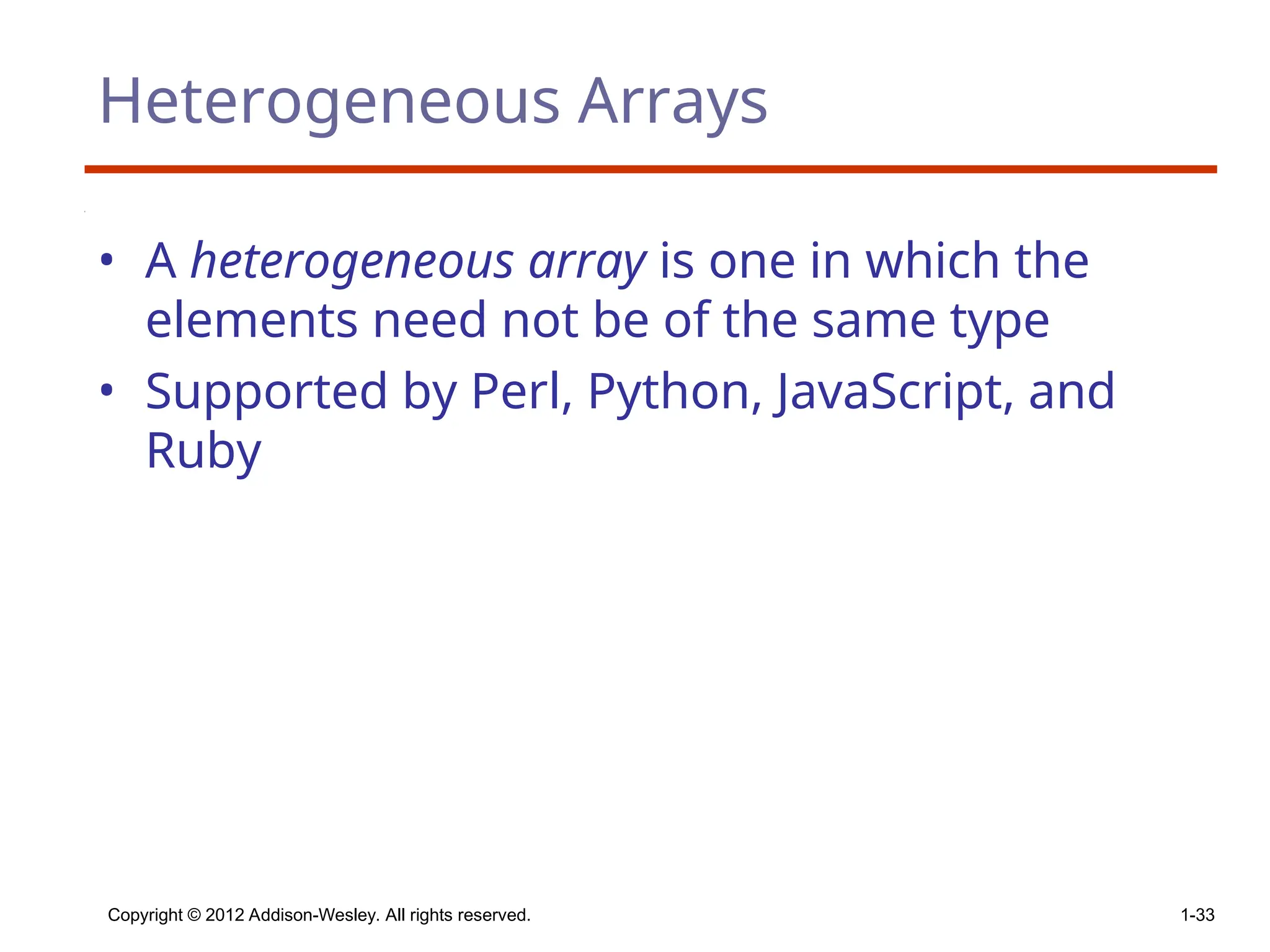
![Array Initialization • C-based languages – int list [] = {1, 3, 5, 7} – char *names [] = {″Mike″, ″Fred″, ″Mary Lou″}; • Ada – List : array (1..5) of Integer := (1 => 17, 3 => 34, others => 0); • Python – List comprehensions list = [x ** 2 for x in range(12) if x % 3 == 0] puts [0, 9, 36, 81] in list Copyright © 2012 Addison-Wesley. All rights reserved. 1-34](https://image.slidesharecdn.com/pl10ch6datatypes-250217025822-ba0cdf5c/75/pl10ch6_datatypesprinciplesof-programing-ppt-34-2048.jpg)
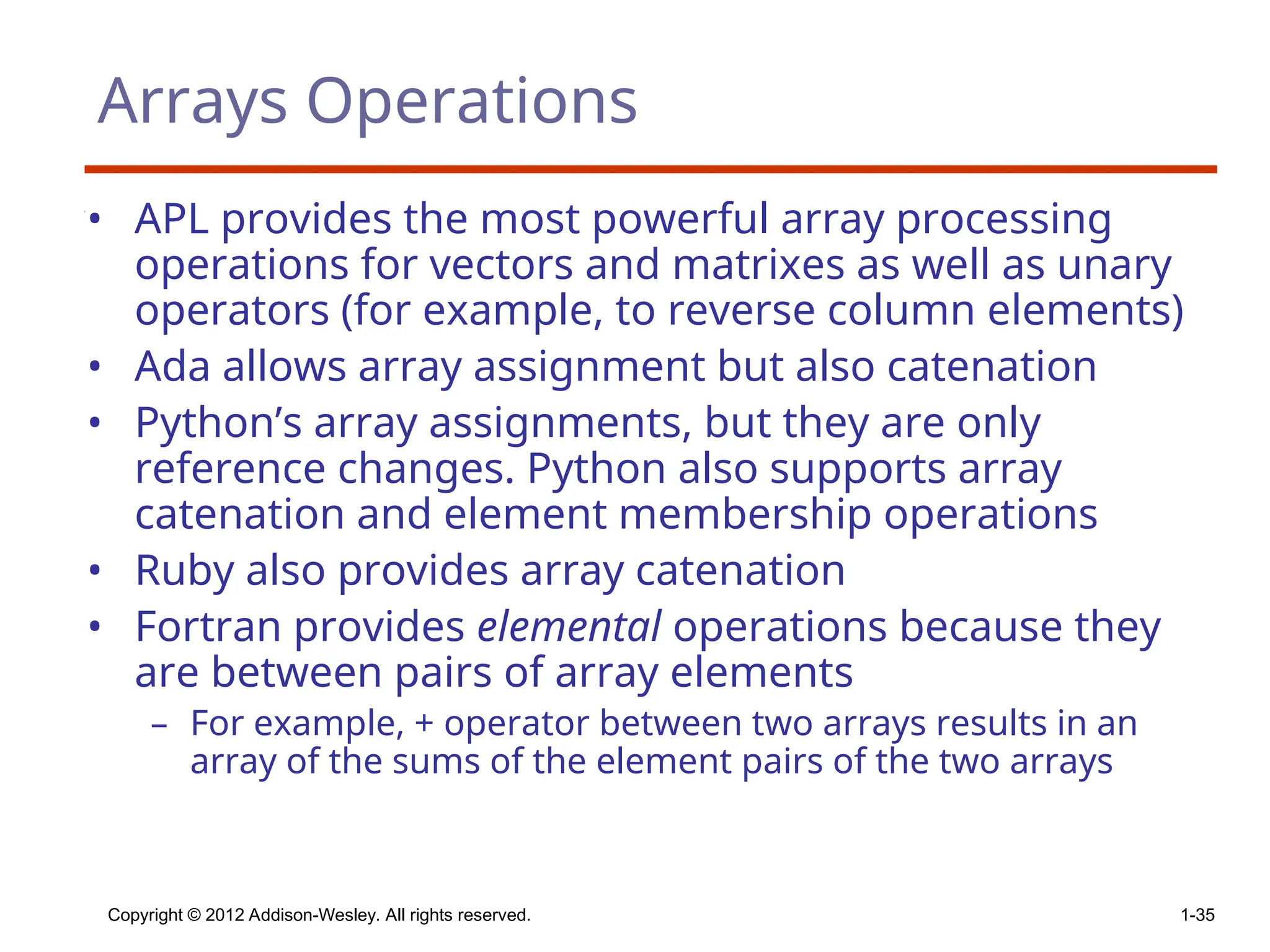
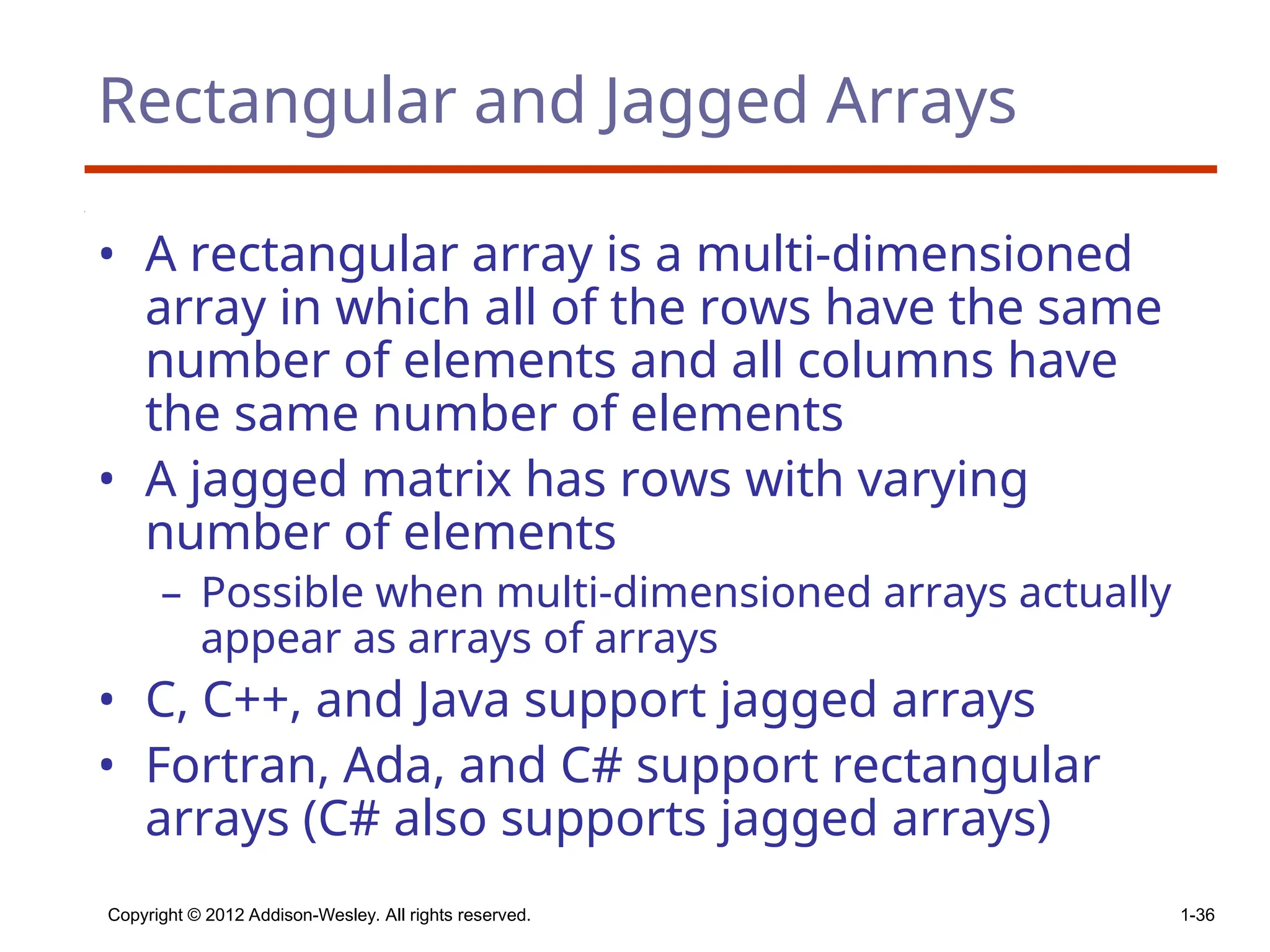
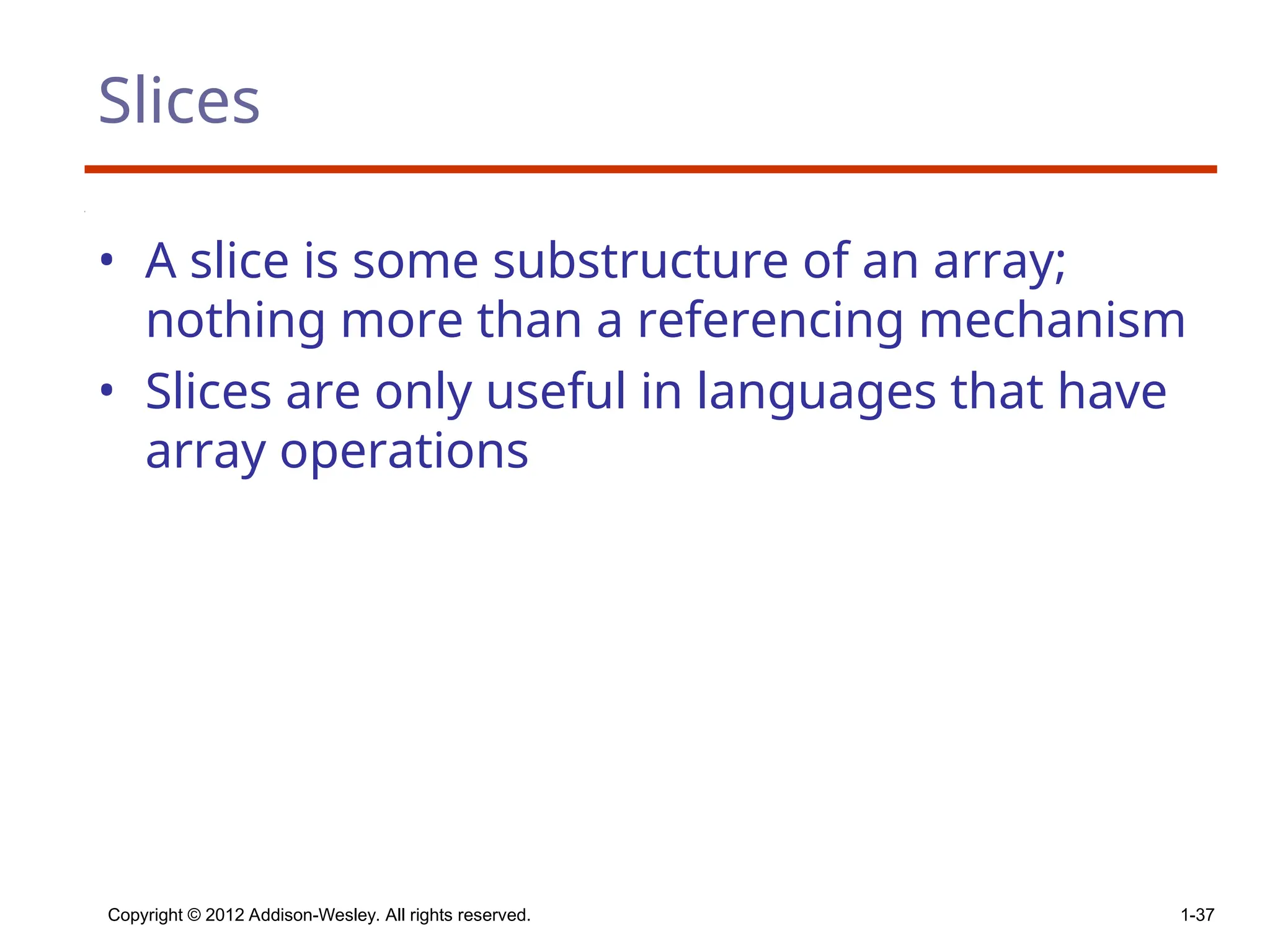
![Copyright © 2012 Addison-Wesley. All rights reserved. 1-38 Slice Examples • Python vector = [2, 4, 6, 8, 10, 12, 14, 16] mat = [[1, 2, 3], [4, 5, 6], [7, 8, 9]] vector (3:6) is a three-element array mat[0][0:2] is the first and second element of the first row of mat • Ruby supports slices with the slice method list.slice(2, 2) returns the third and fourth elements of list](https://image.slidesharecdn.com/pl10ch6datatypes-250217025822-ba0cdf5c/75/pl10ch6_datatypesprinciplesof-programing-ppt-38-2048.jpg)
![Copyright © 2012 Addison-Wesley. All rights reserved. 1-39 Implementation of Arrays • Access function maps subscript expressions to an address in the array • Access function for single-dimensioned arrays: address(list[k]) = address (list[lower_bound]) + ((k-lower_bound) * element_size)](https://image.slidesharecdn.com/pl10ch6datatypes-250217025822-ba0cdf5c/75/pl10ch6_datatypesprinciplesof-programing-ppt-39-2048.jpg)
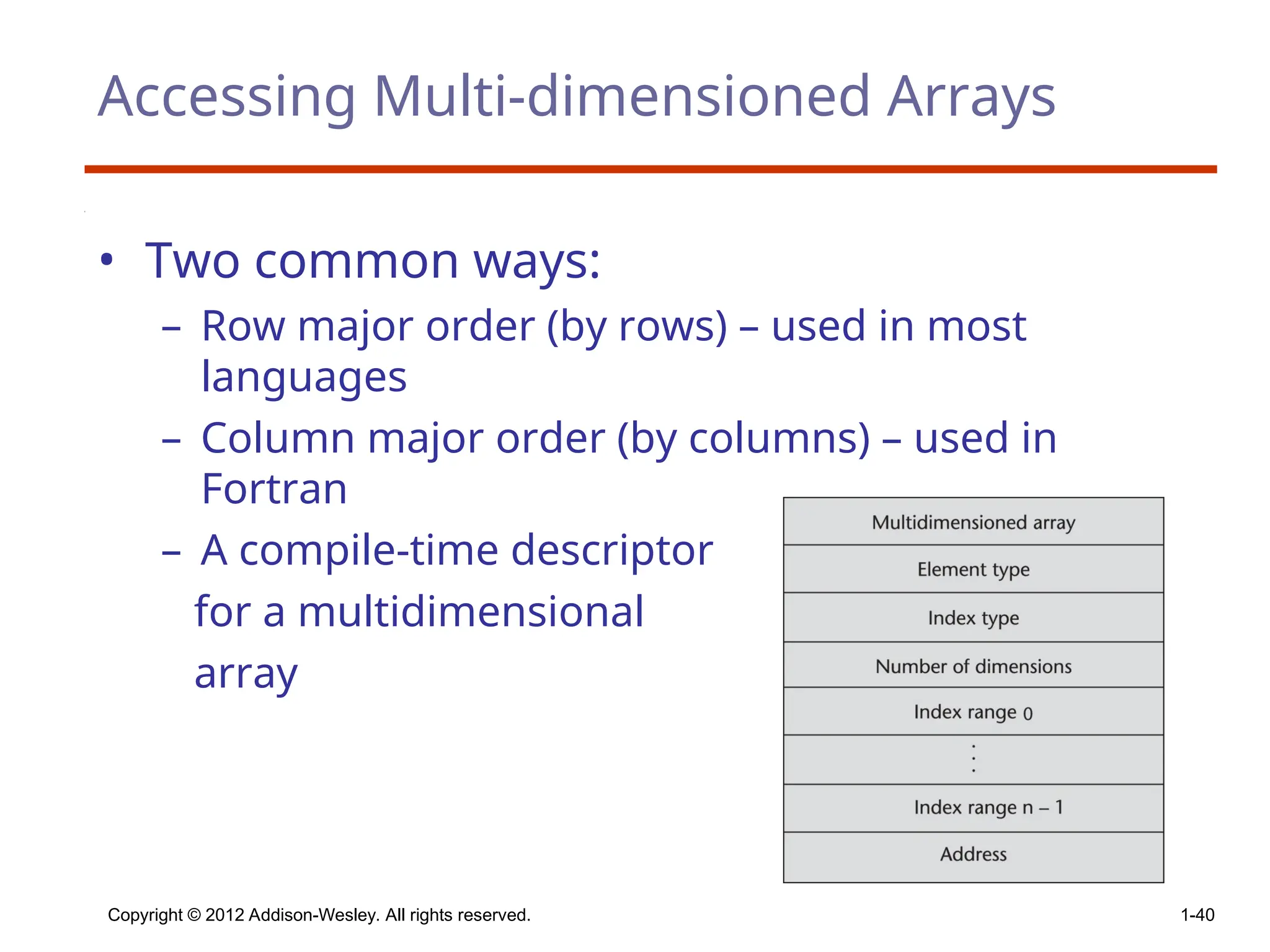
![Copyright © 2012 Addison-Wesley. All rights reserved. 1-41 Locating an Element in a Multi- dimensioned Array •General format Location (a[I,j]) = address of a [row_lb,col_lb] + (((I - row_lb) * n) + (j - col_lb)) * element_size](https://image.slidesharecdn.com/pl10ch6datatypes-250217025822-ba0cdf5c/75/pl10ch6_datatypesprinciplesof-programing-ppt-41-2048.jpg)
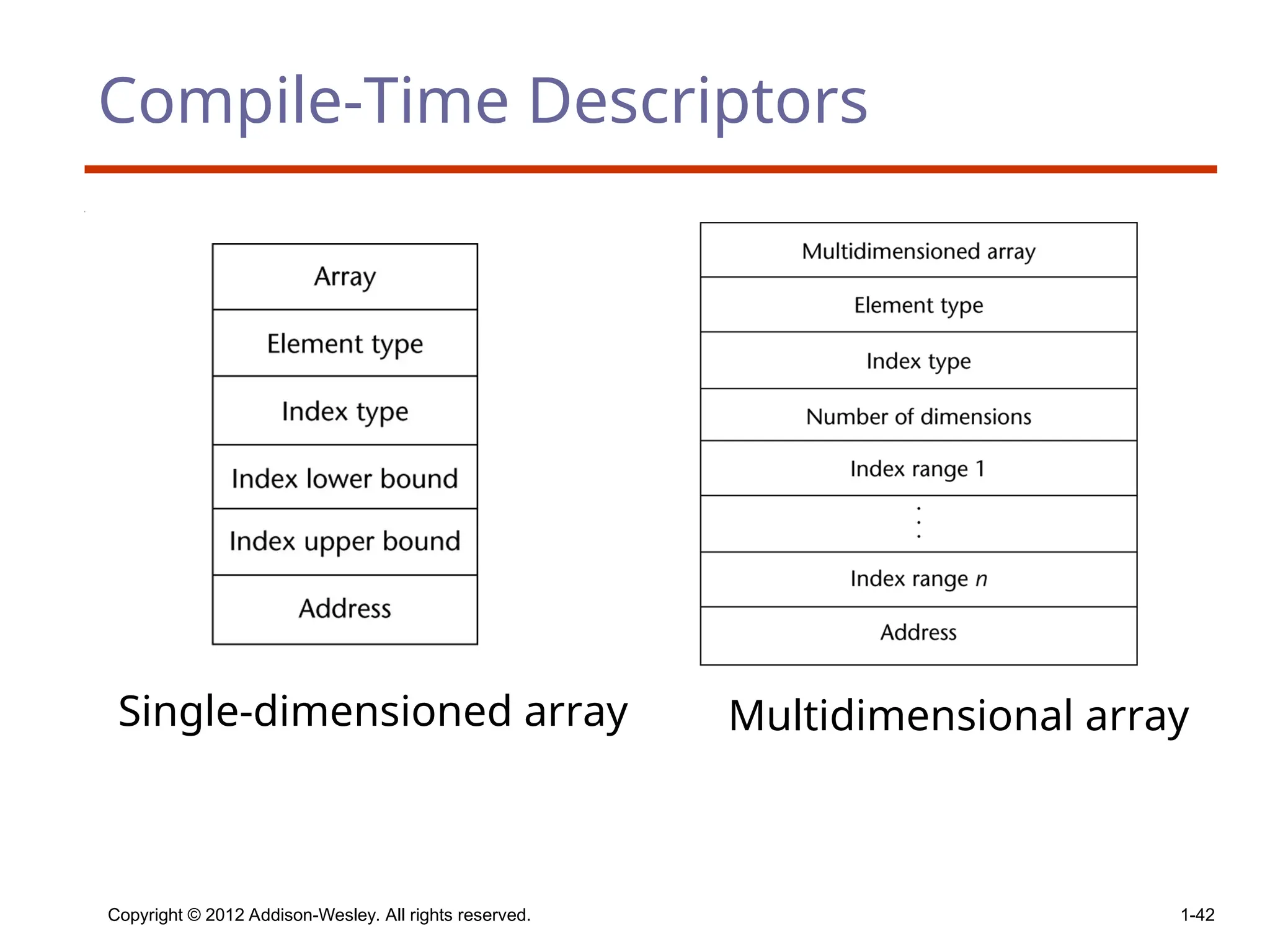
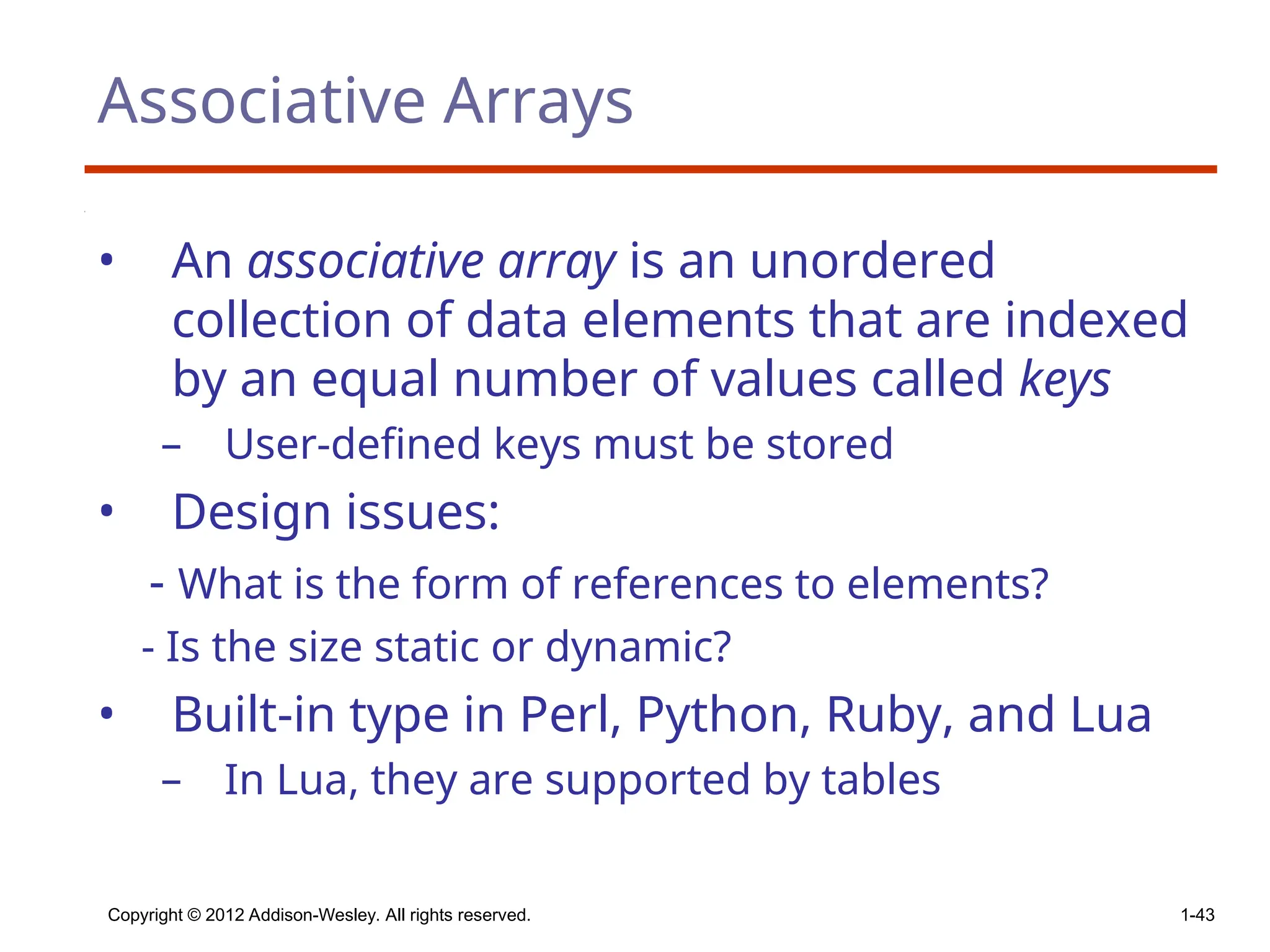
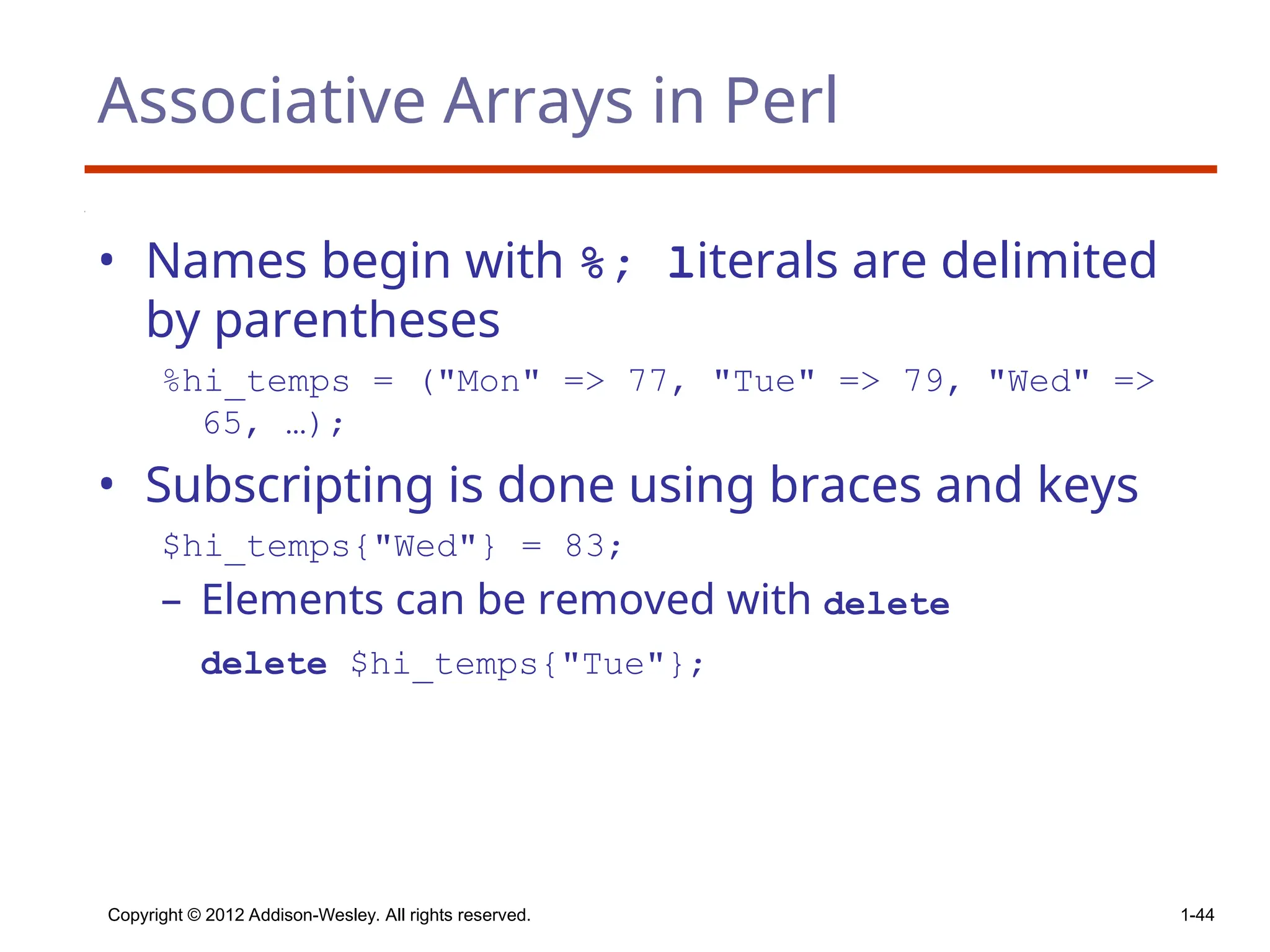
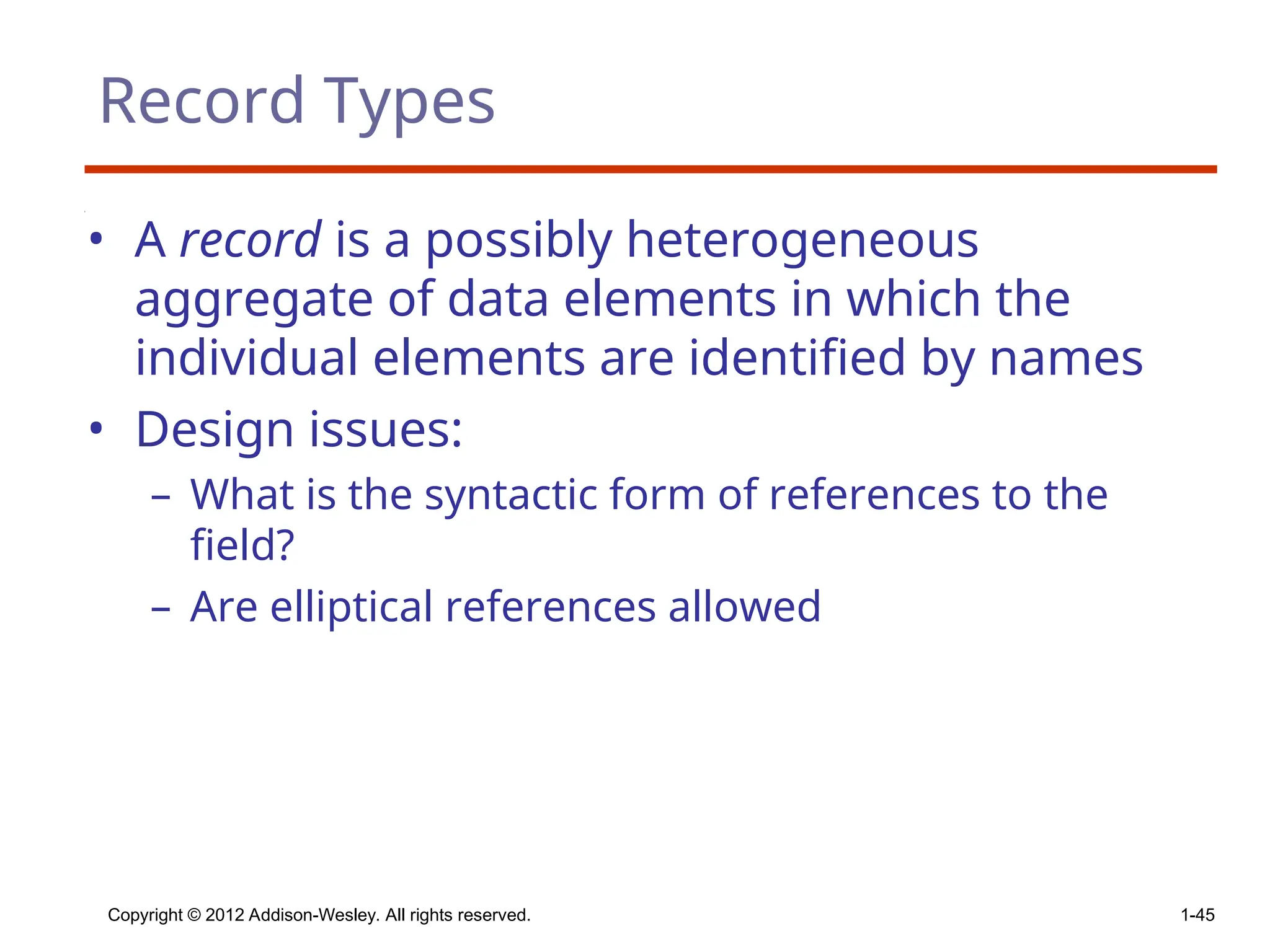
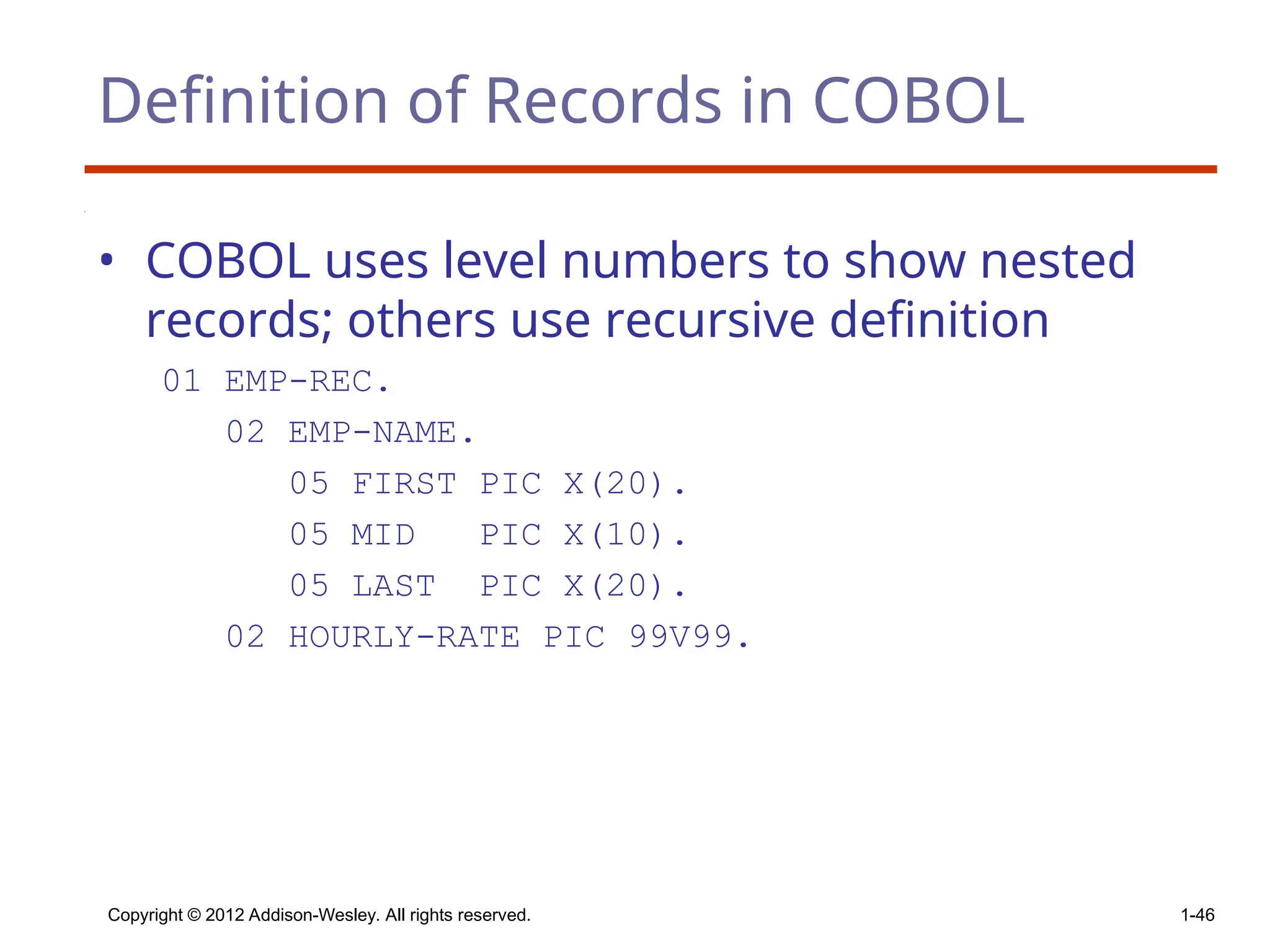
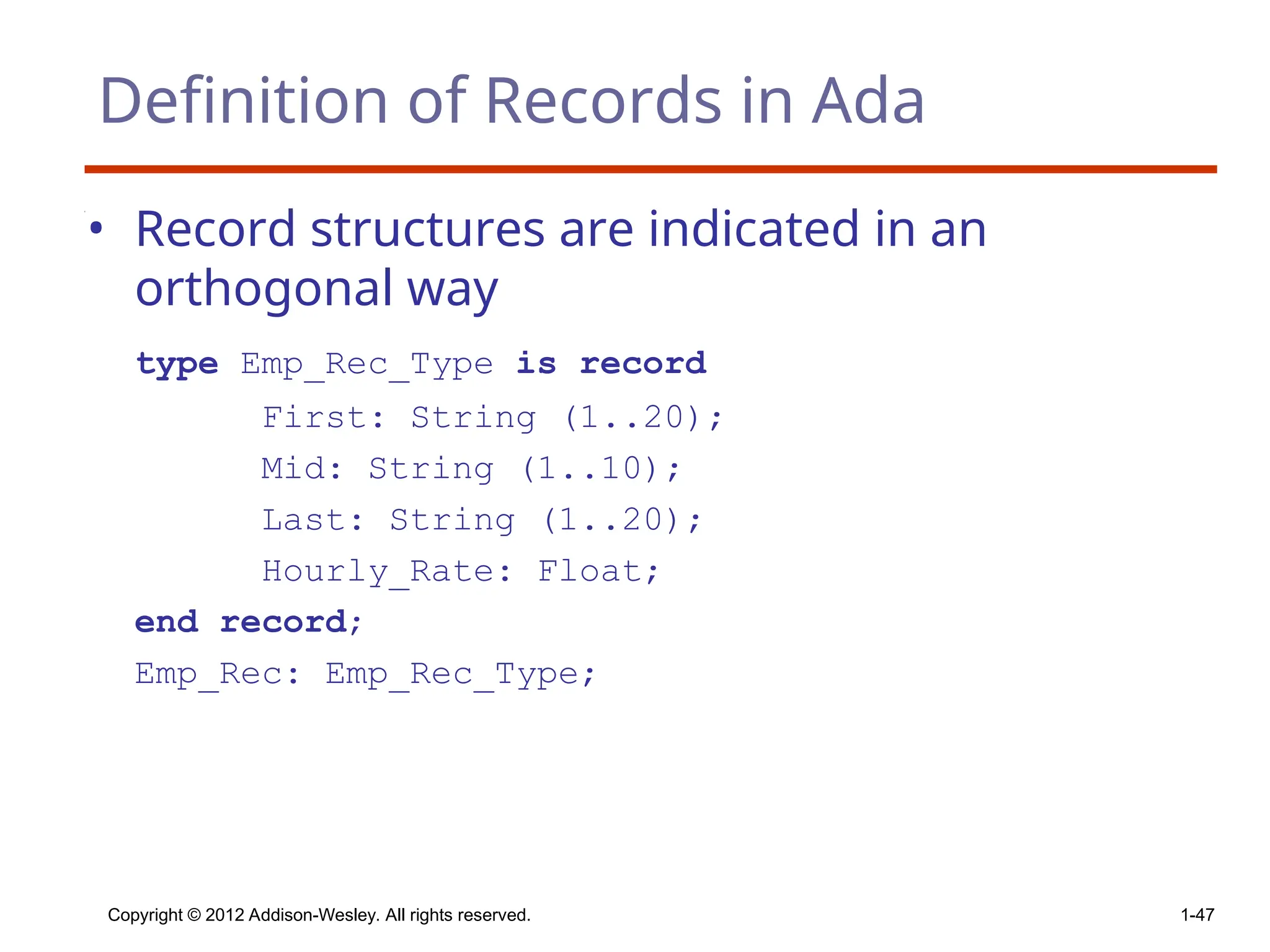
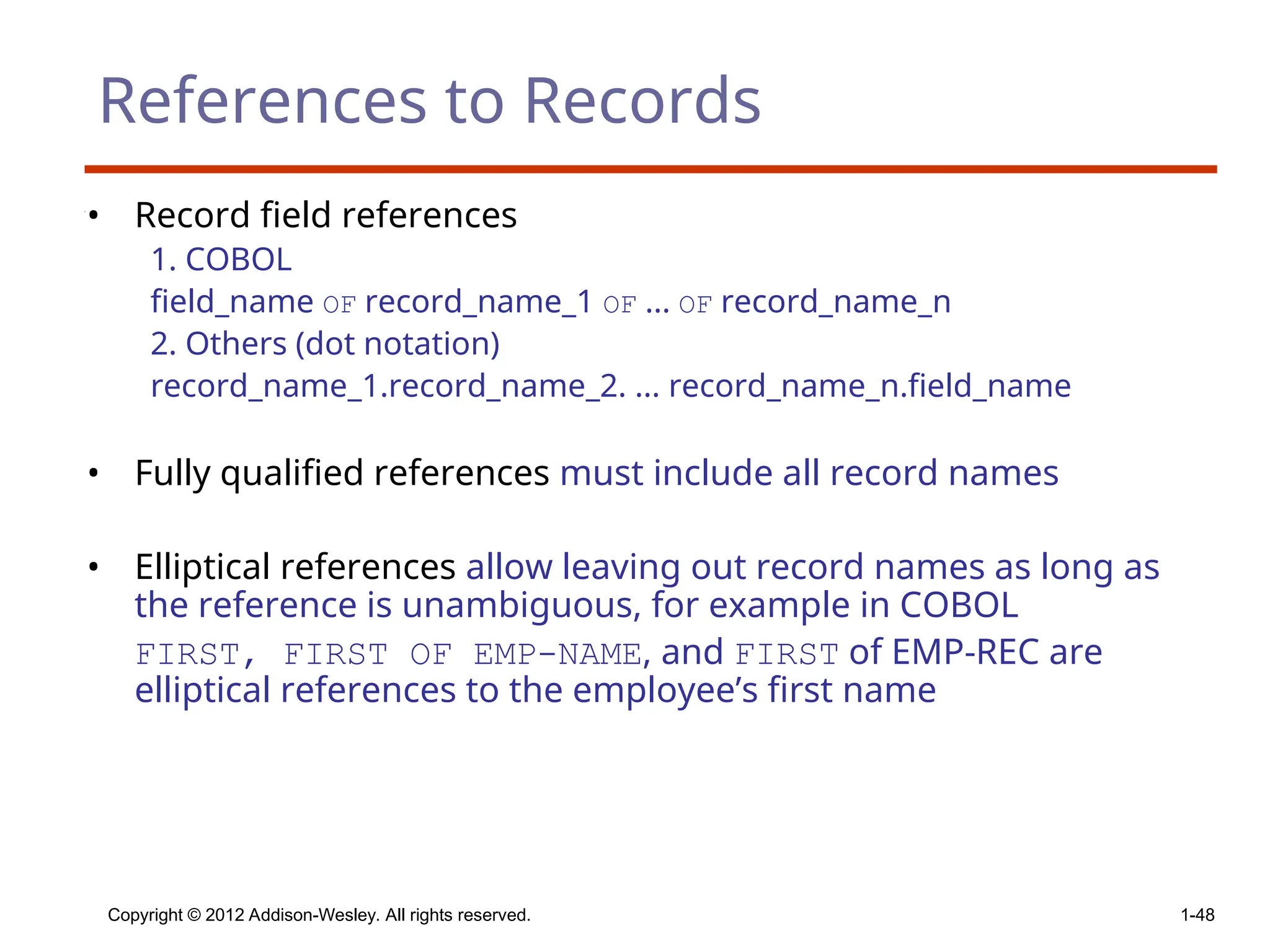
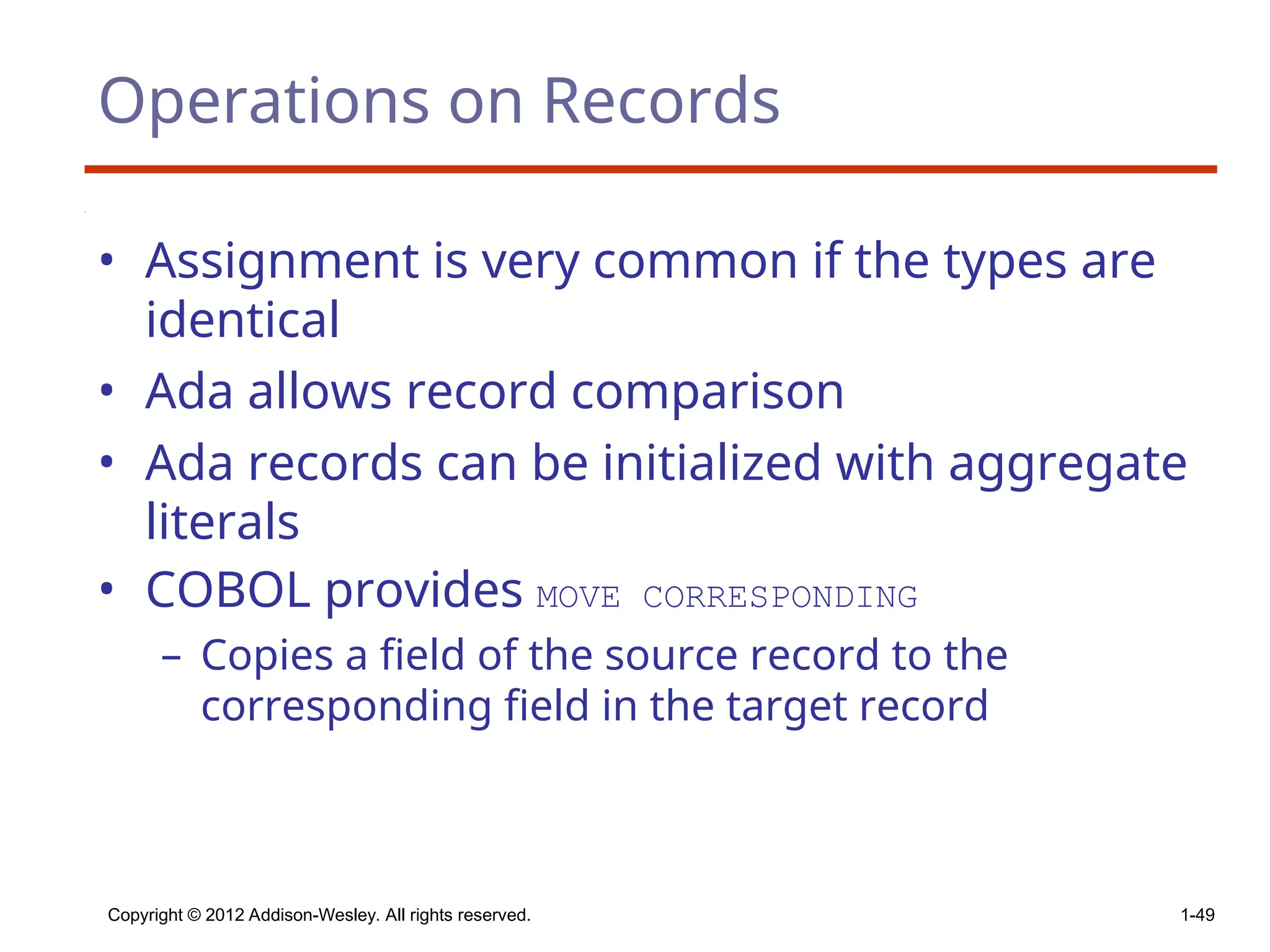
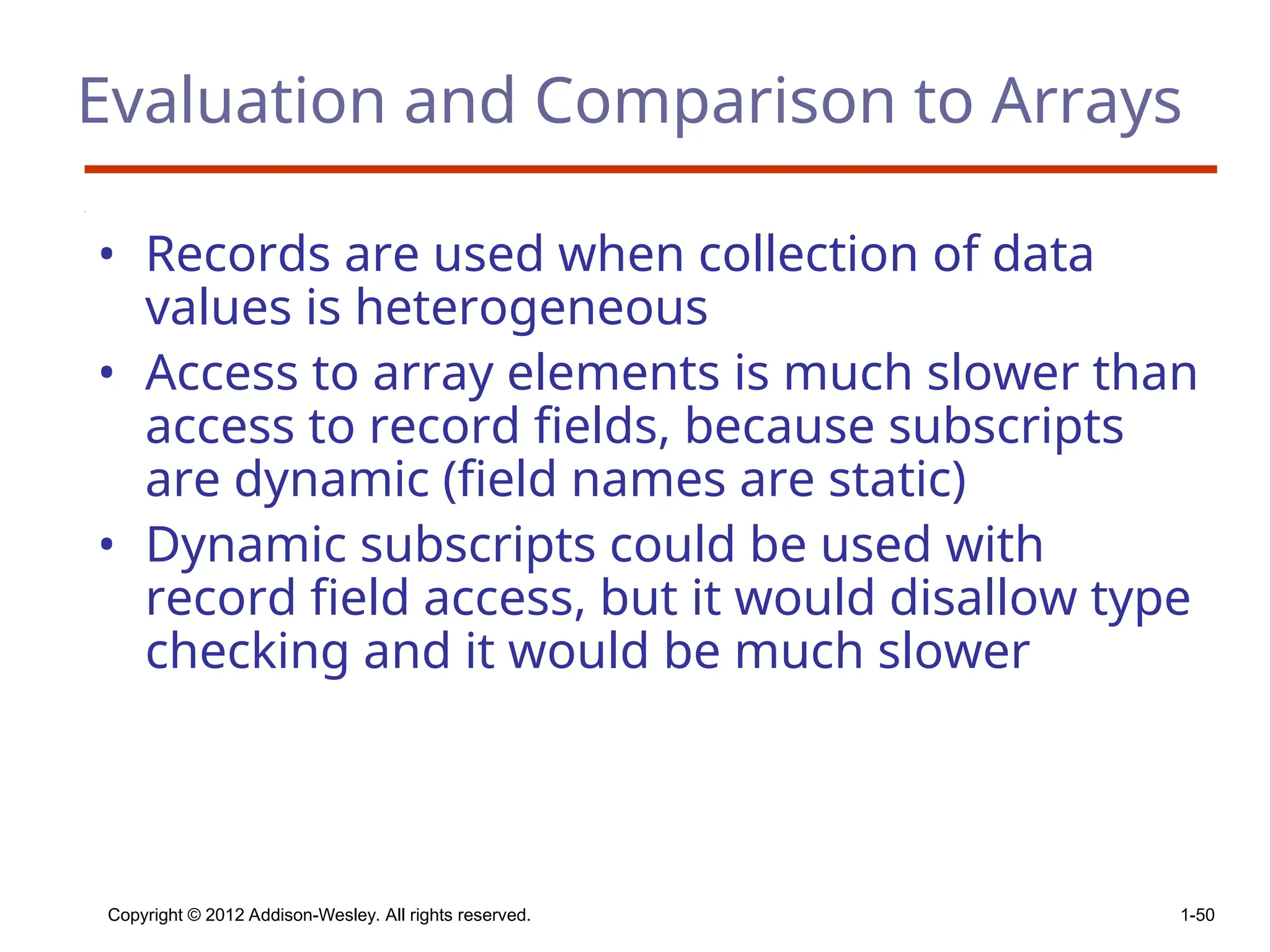
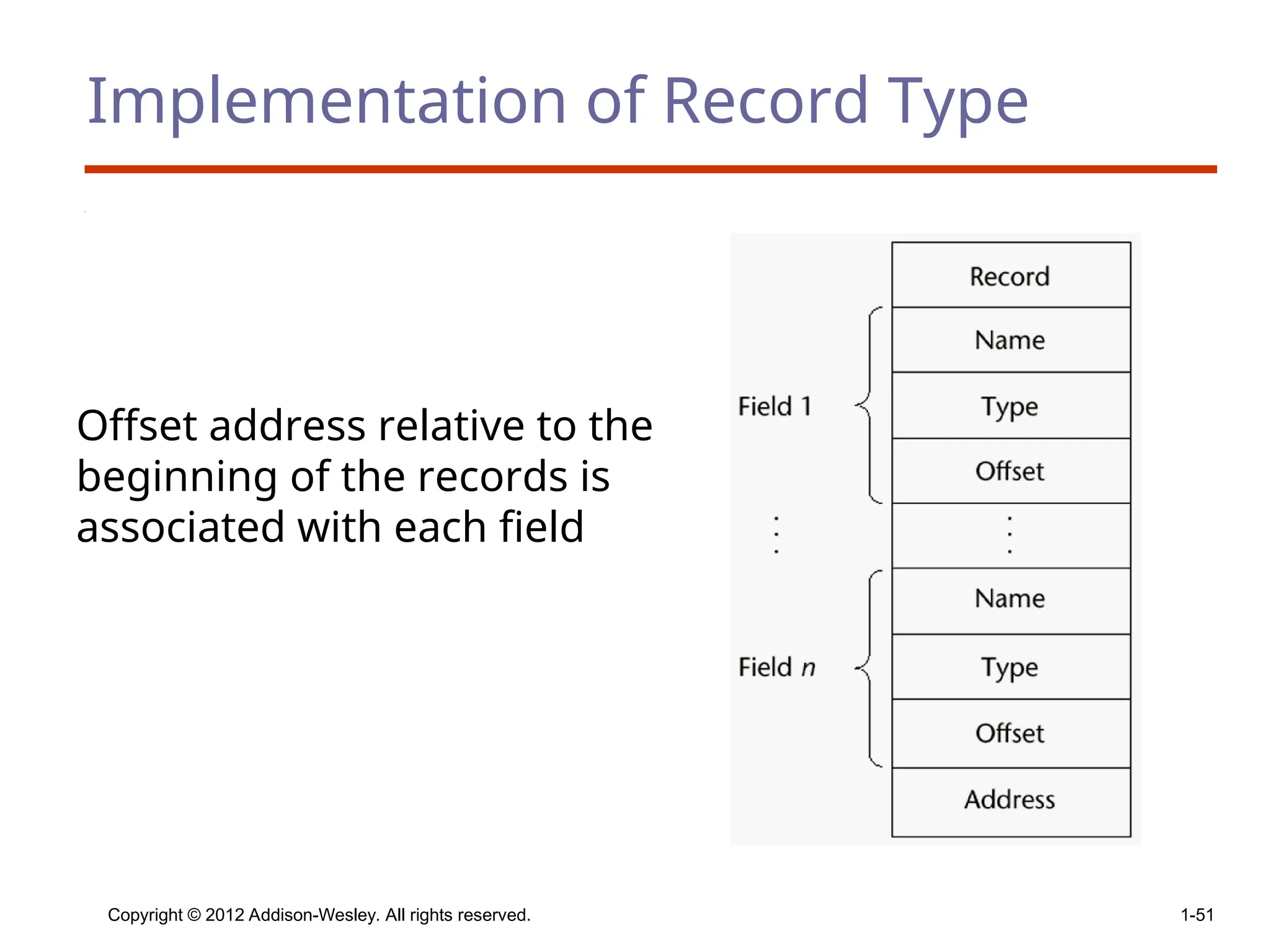
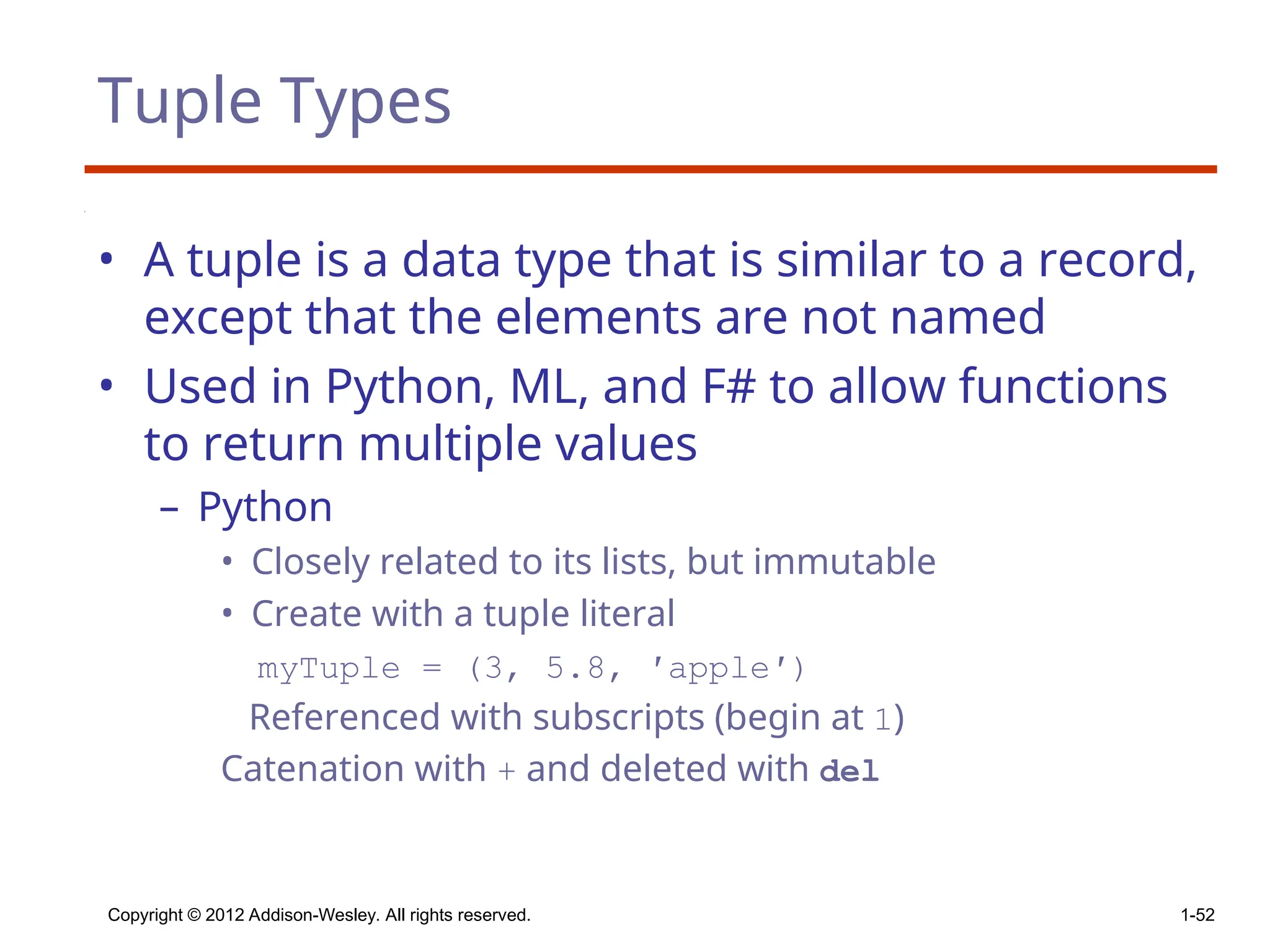
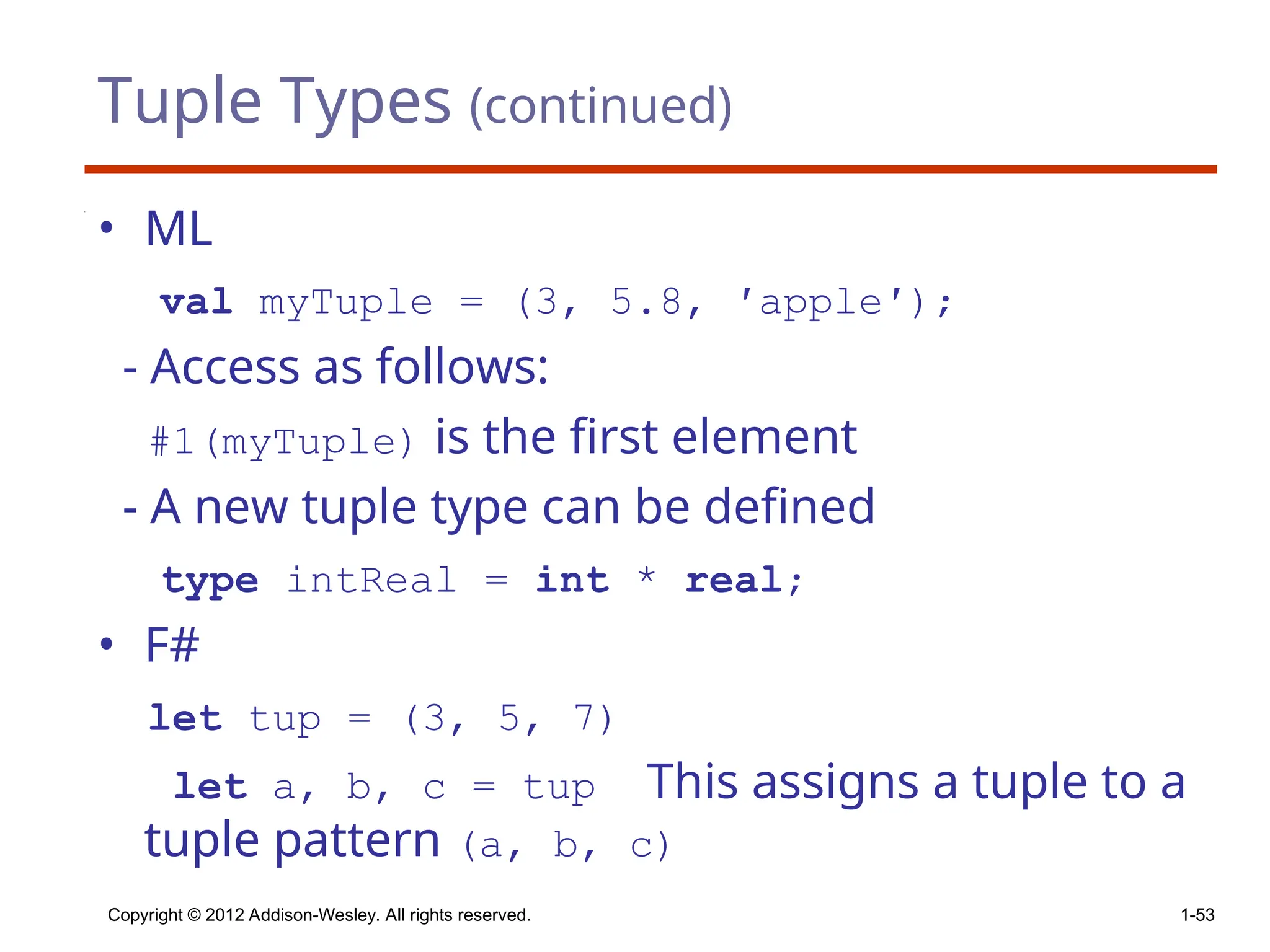
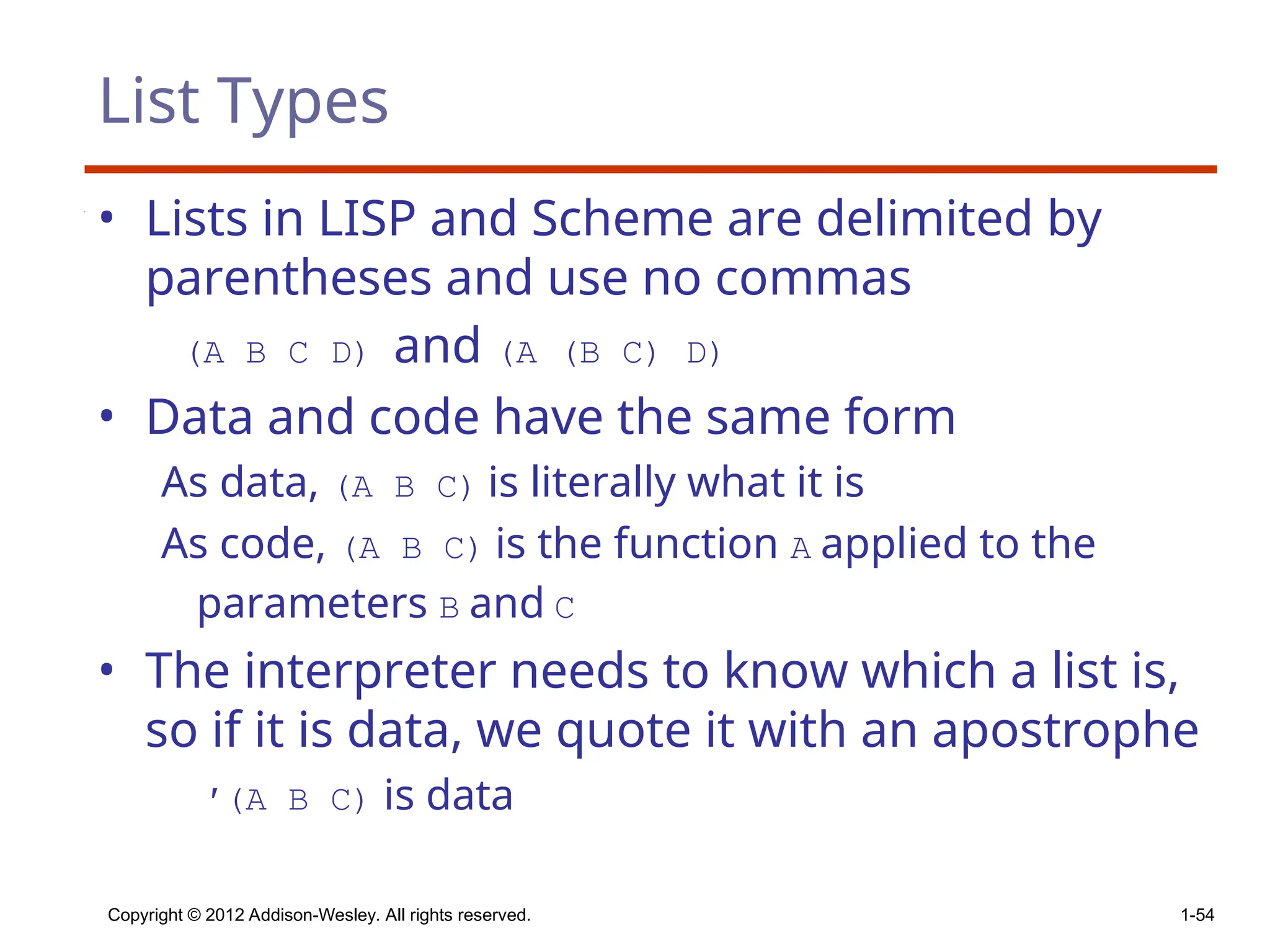
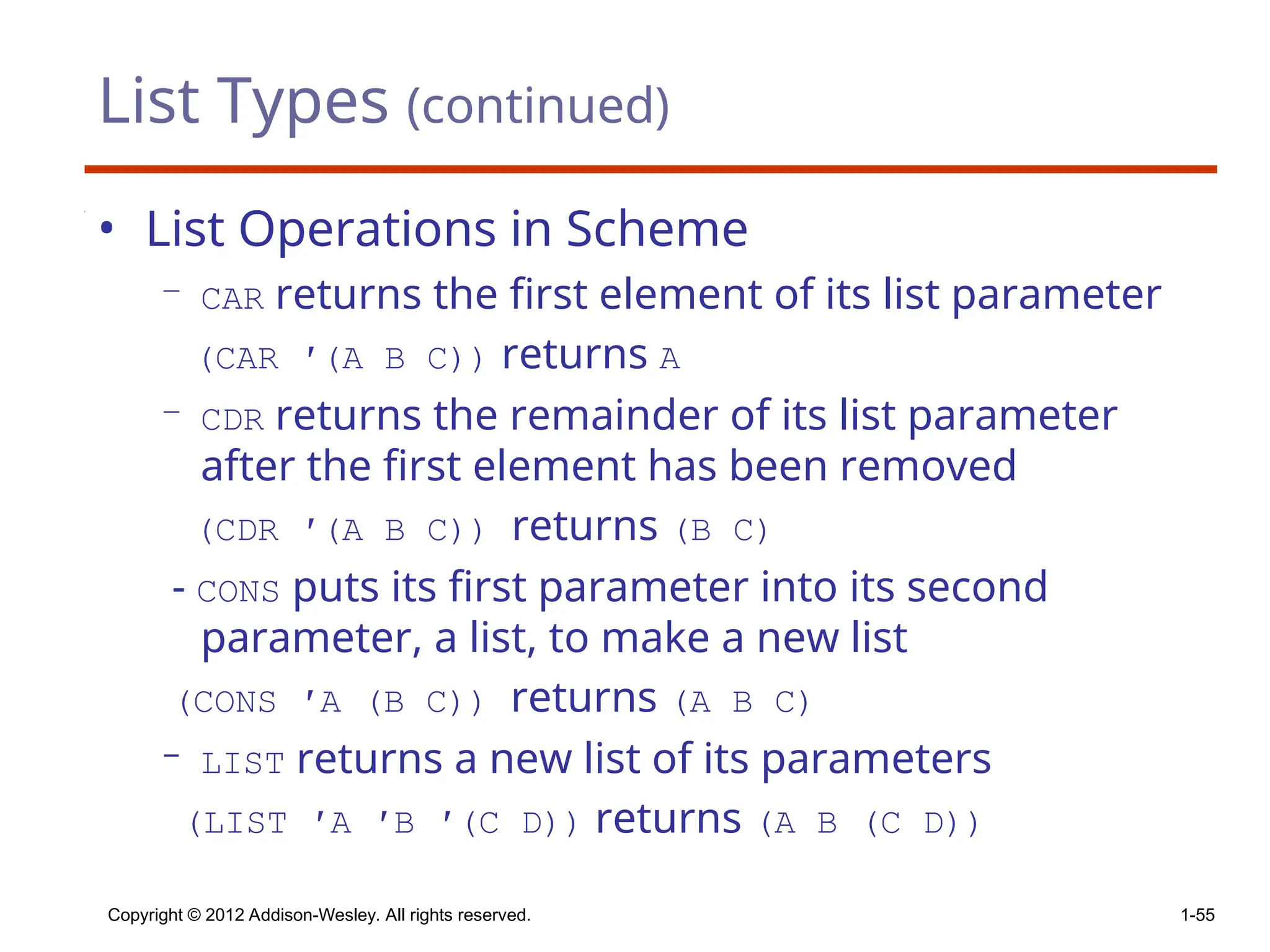
![List Types (continued) • List Operations in ML – Lists are written in brackets and the elements are separated by commas – List elements must be of the same type – The Scheme CONS function is a binary operator in ML, :: 3 :: [5, 7, 9] evaluates to [3, 5, 7, 9] – The Scheme CAR and CDR functions are named hd and tl, respectively Copyright © 2012 Addison-Wesley. All rights reserved. 1-56](https://image.slidesharecdn.com/pl10ch6datatypes-250217025822-ba0cdf5c/75/pl10ch6_datatypesprinciplesof-programing-ppt-56-2048.jpg)
![List Types (continued) • F# Lists – Like those of ML, except elements are separated by semicolons and hd and tl are methods of the List class • Python Lists – The list data type also serves as Python’s arrays – Unlike Scheme, Common LISP, ML, and F#, Python’s lists are mutable – Elements can be of any type – Create a list with an assignment myList = [3, 5.8, "grape"] Copyright © 2012 Addison-Wesley. All rights reserved. 1-57](https://image.slidesharecdn.com/pl10ch6datatypes-250217025822-ba0cdf5c/75/pl10ch6_datatypesprinciplesof-programing-ppt-57-2048.jpg)
![List Types (continued) • Python Lists (continued) – List elements are referenced with subscripting, with indices beginning at zero x = myList[1] Sets x to 5.8 – List elements can be deleted with del del myList[1] – List Comprehensions – derived from set notation [x * x for x in range(6) if x % 3 == 0] range(12) creates [0, 1, 2, 3, 4, 5, 6] Constructed list: [0, 9, 36] Copyright © 2012 Addison-Wesley. All rights reserved. 1-58](https://image.slidesharecdn.com/pl10ch6datatypes-250217025822-ba0cdf5c/75/pl10ch6_datatypesprinciplesof-programing-ppt-58-2048.jpg)
![List Types (continued) • Haskell’s List Comprehensions – The original [n * n | n <- [1..10]] • F#’s List Comprehensions let myArray = [|for i in 1 .. 5 -> [i * i) |] • Both C# and Java supports lists through their generic heap-dynamic collection classes, List and ArrayList, respectively Copyright © 2012 Addison-Wesley. All rights reserved. 1-59](https://image.slidesharecdn.com/pl10ch6datatypes-250217025822-ba0cdf5c/75/pl10ch6_datatypesprinciplesof-programing-ppt-59-2048.jpg)
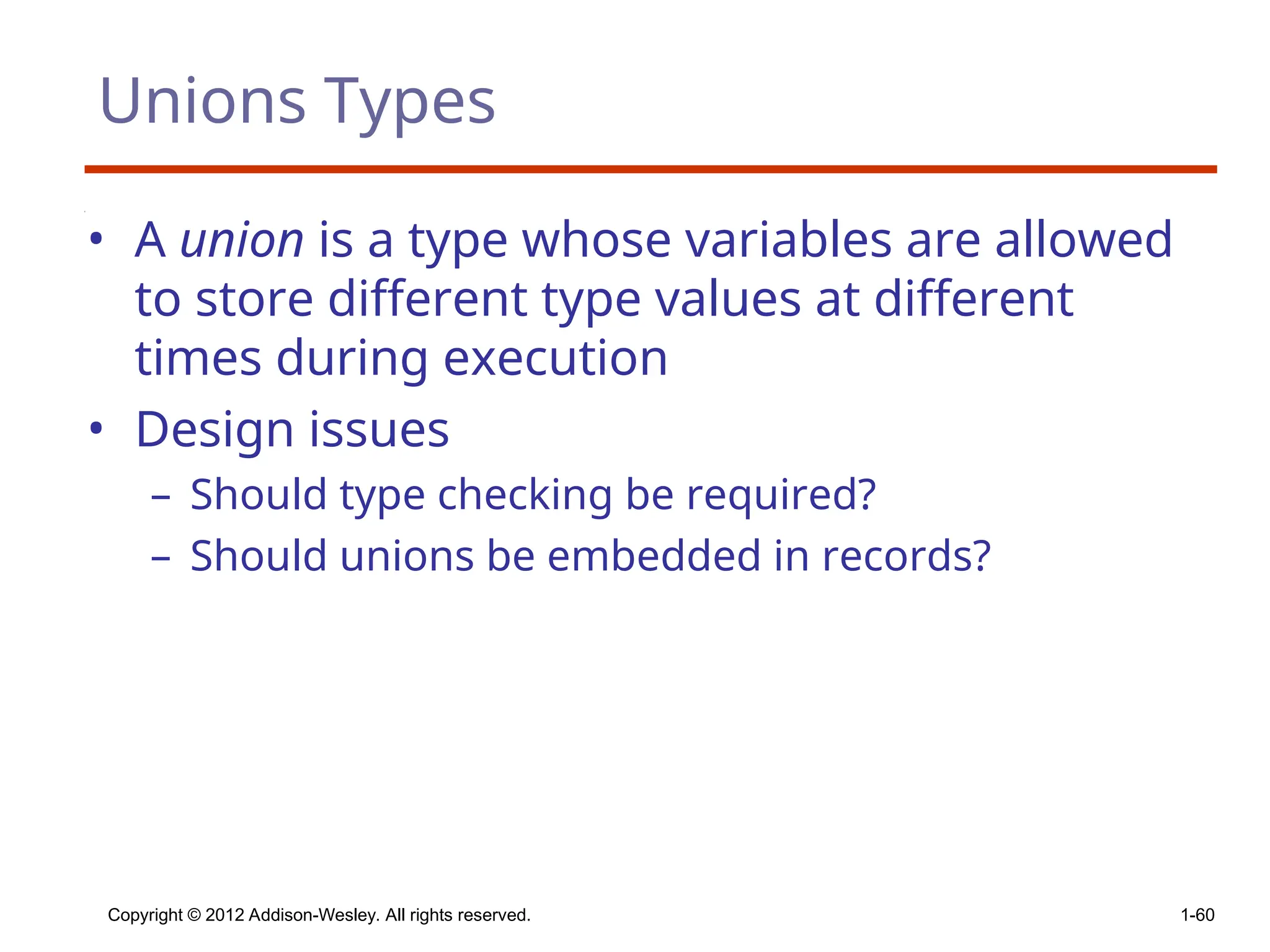
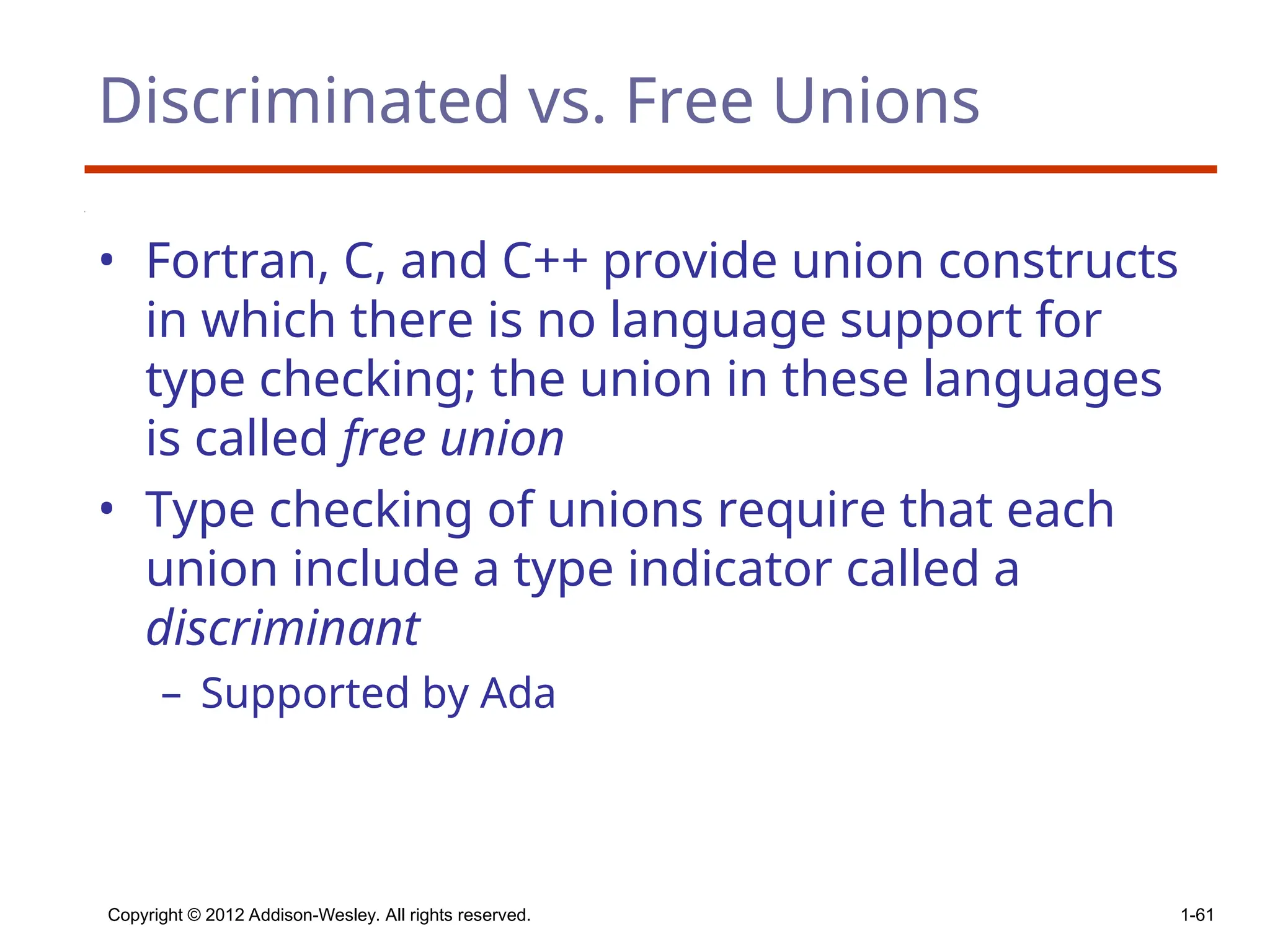
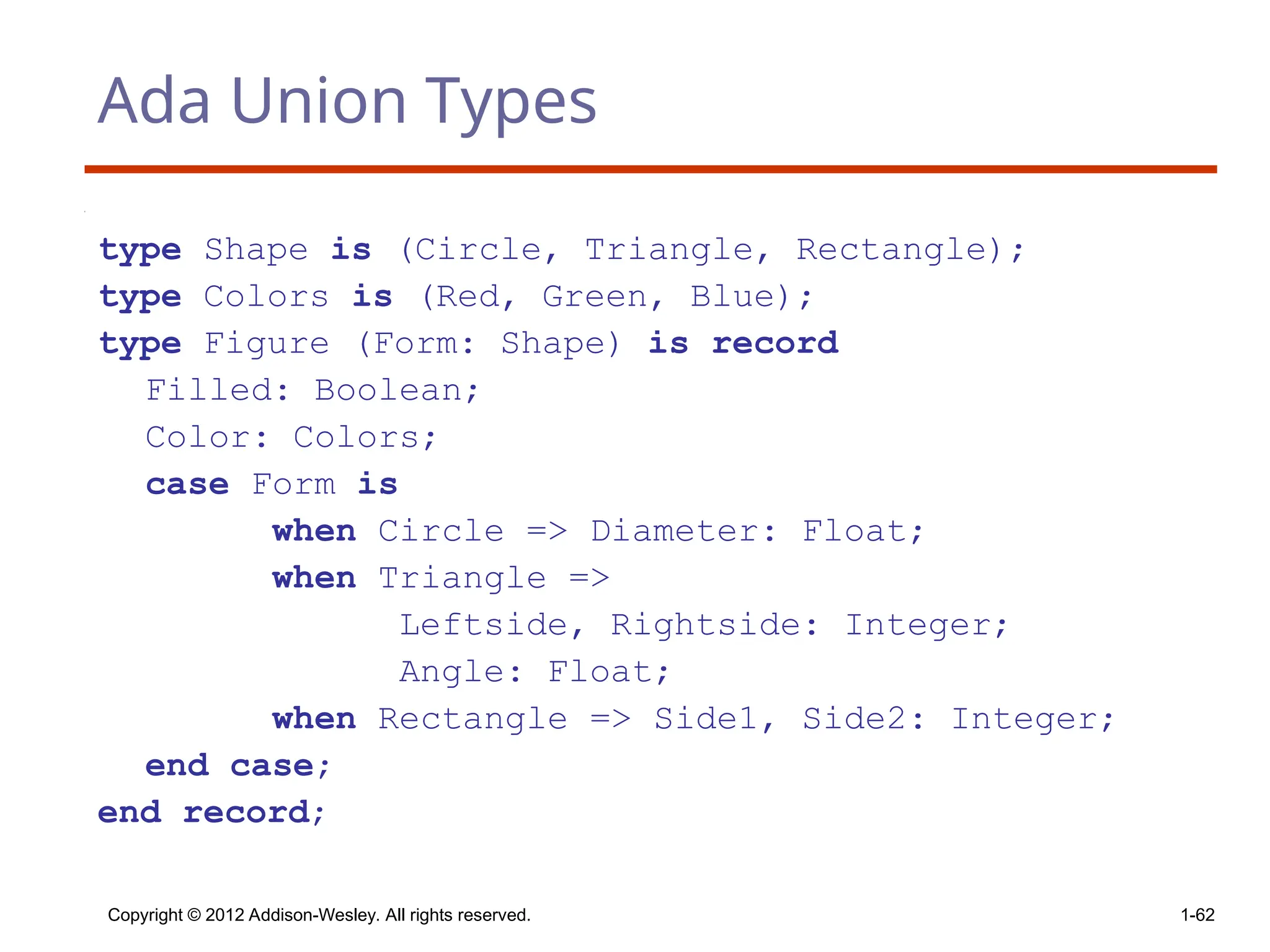
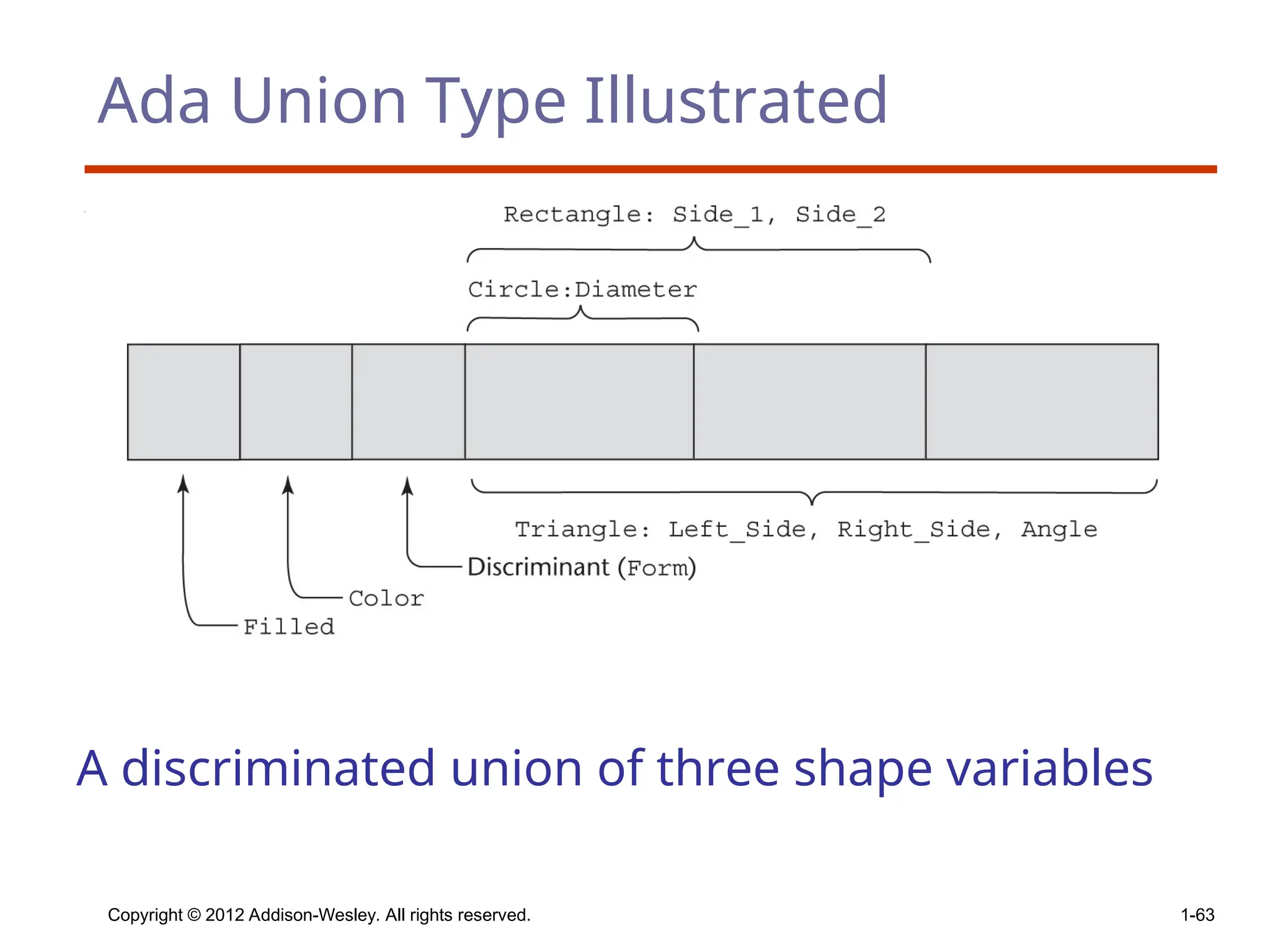
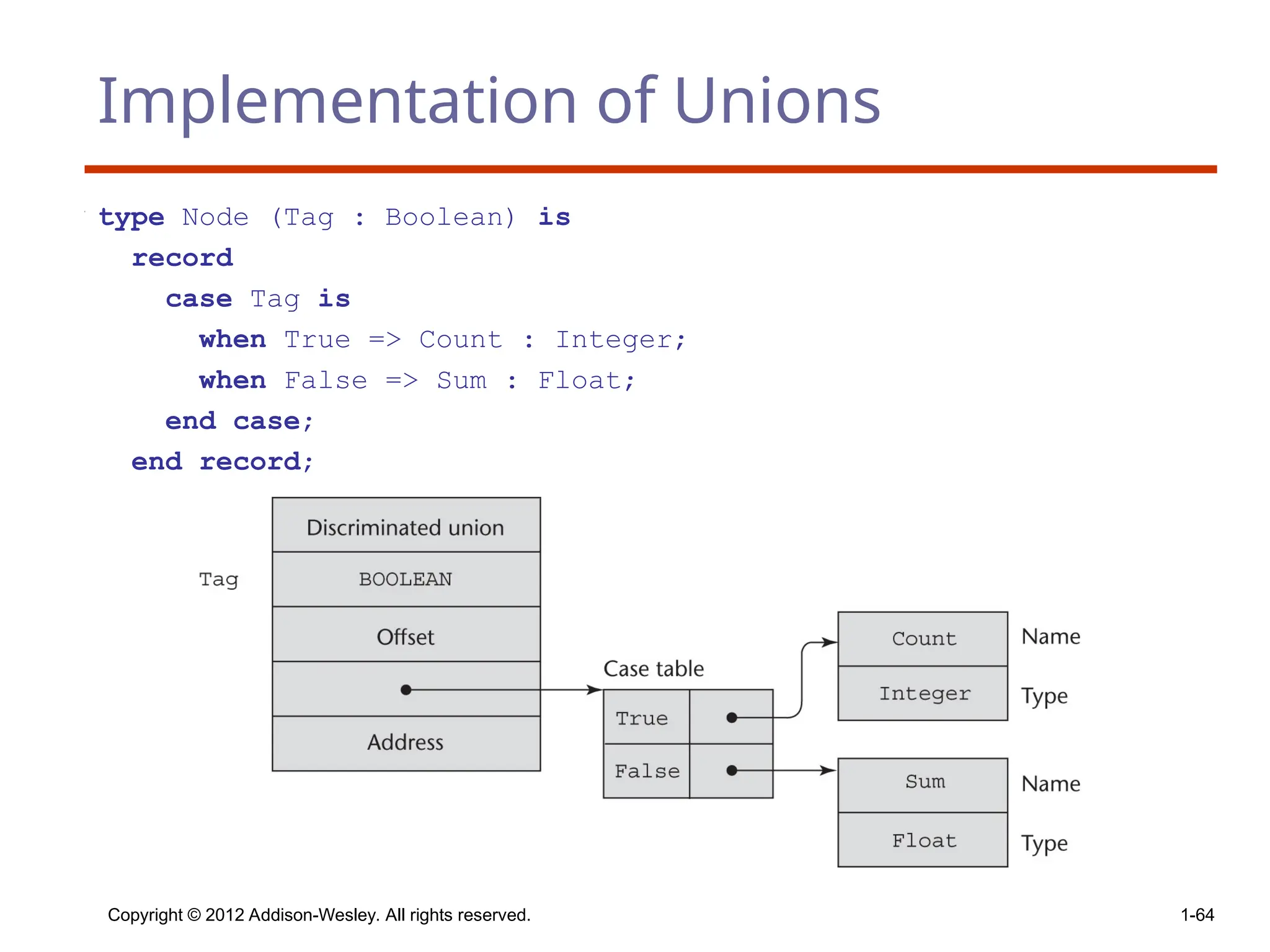
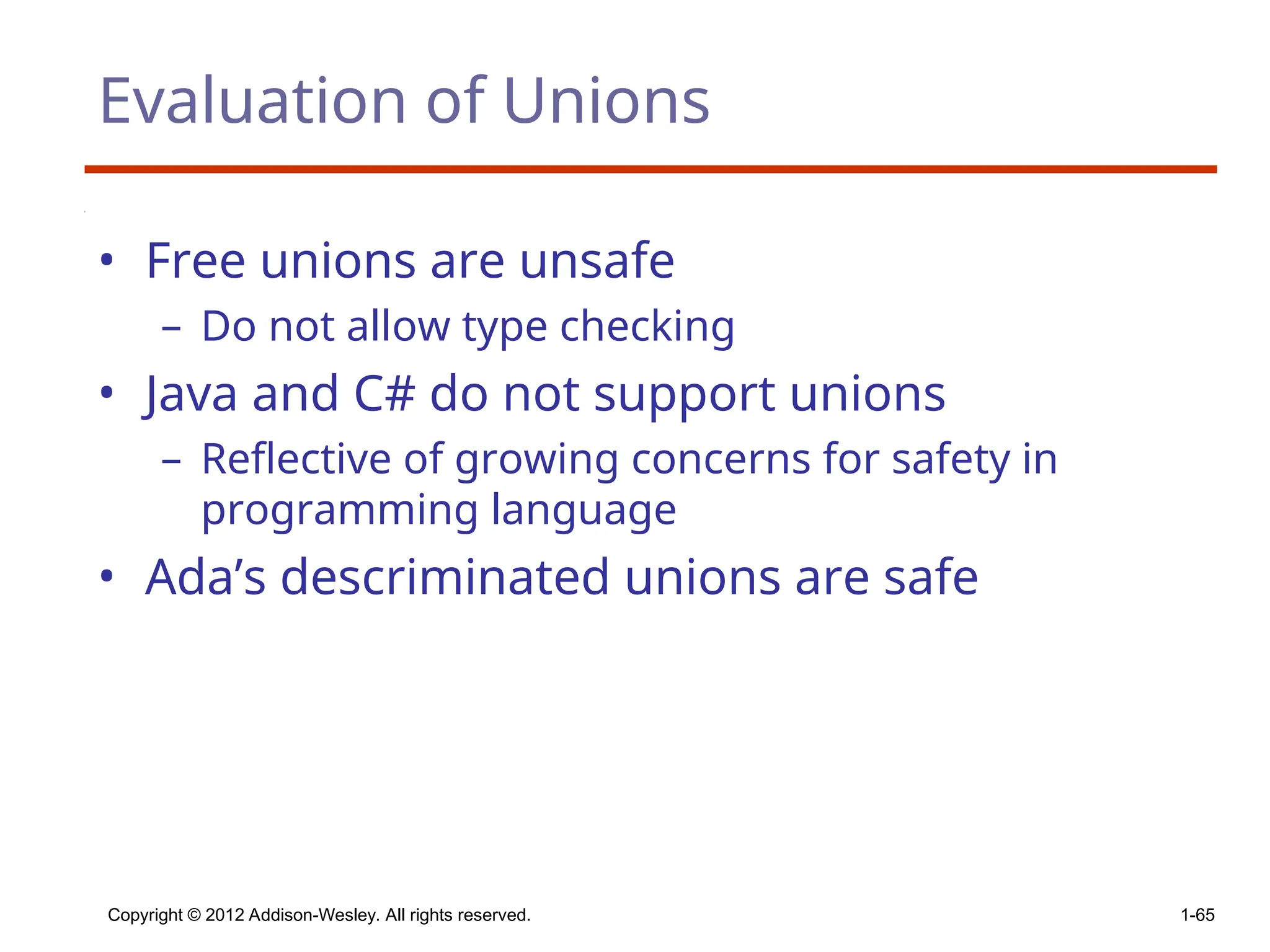
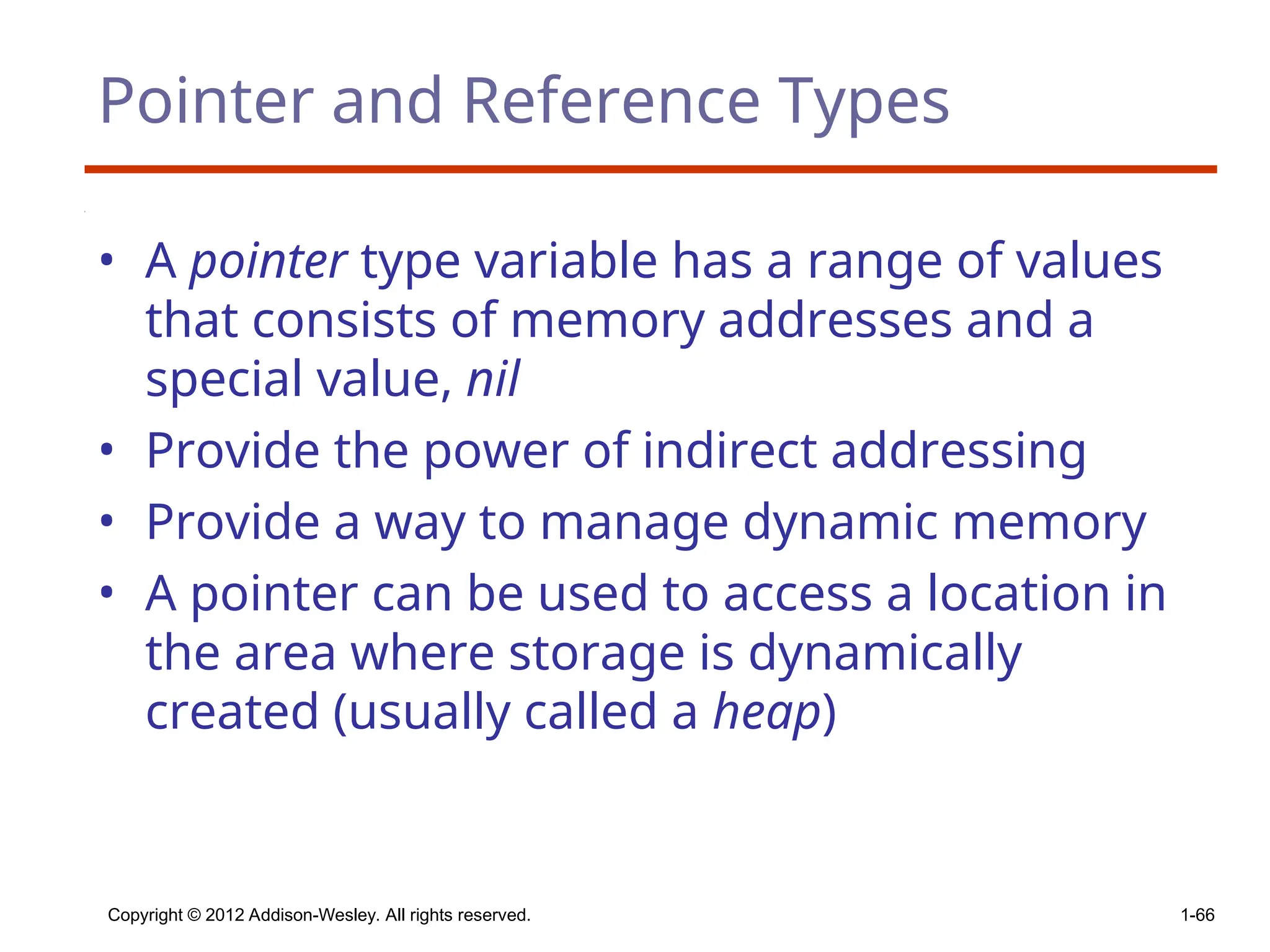
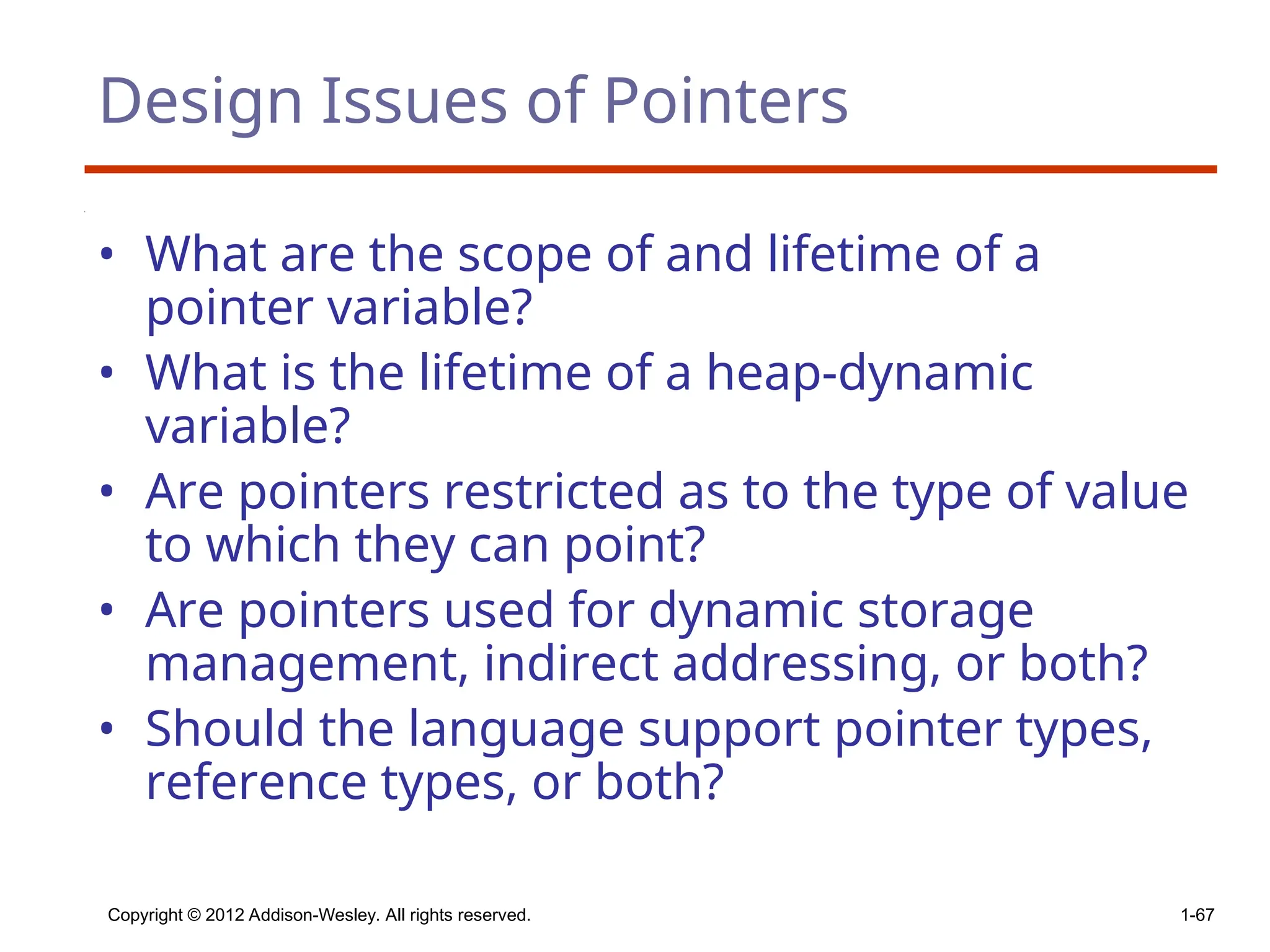
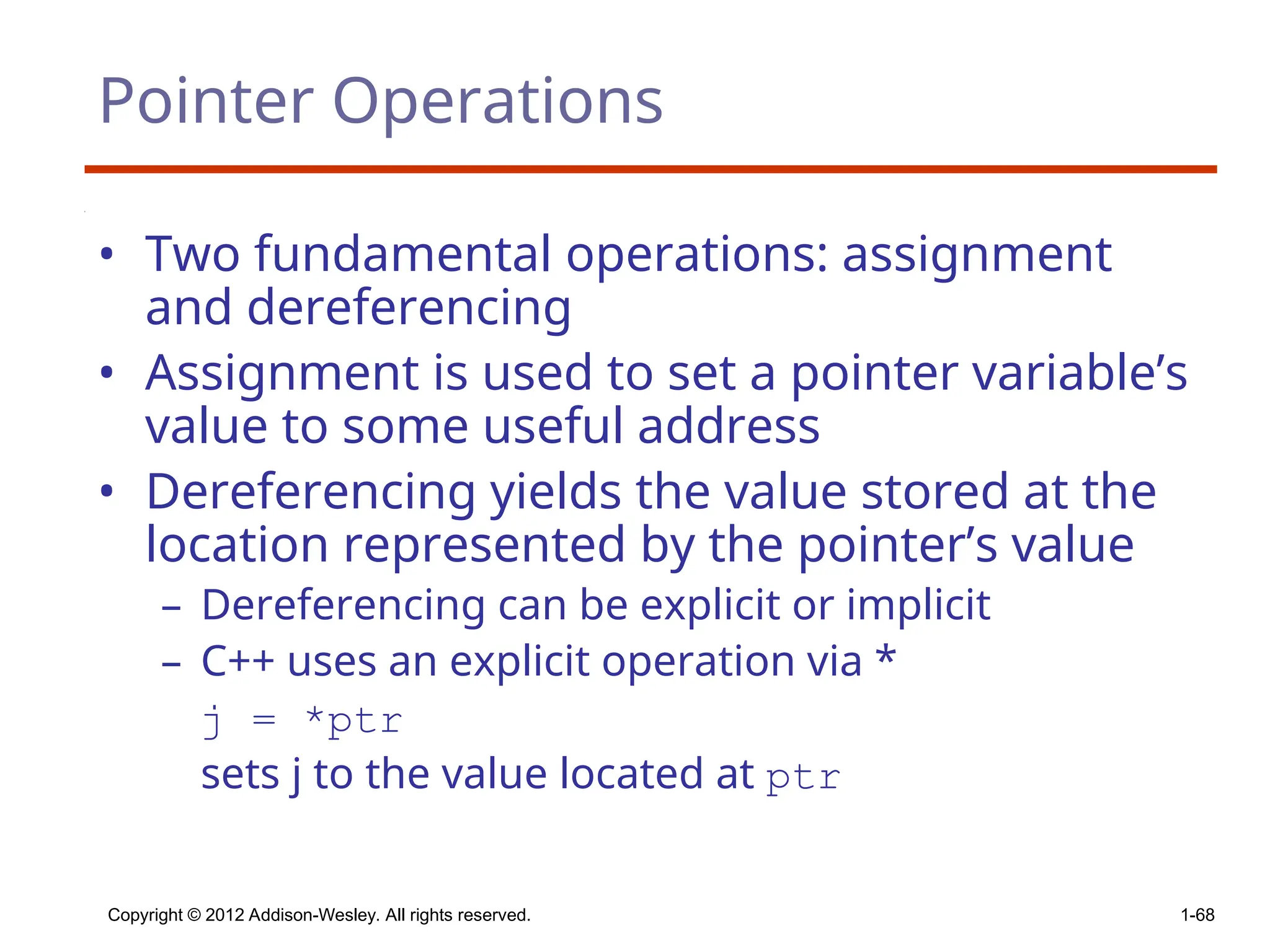
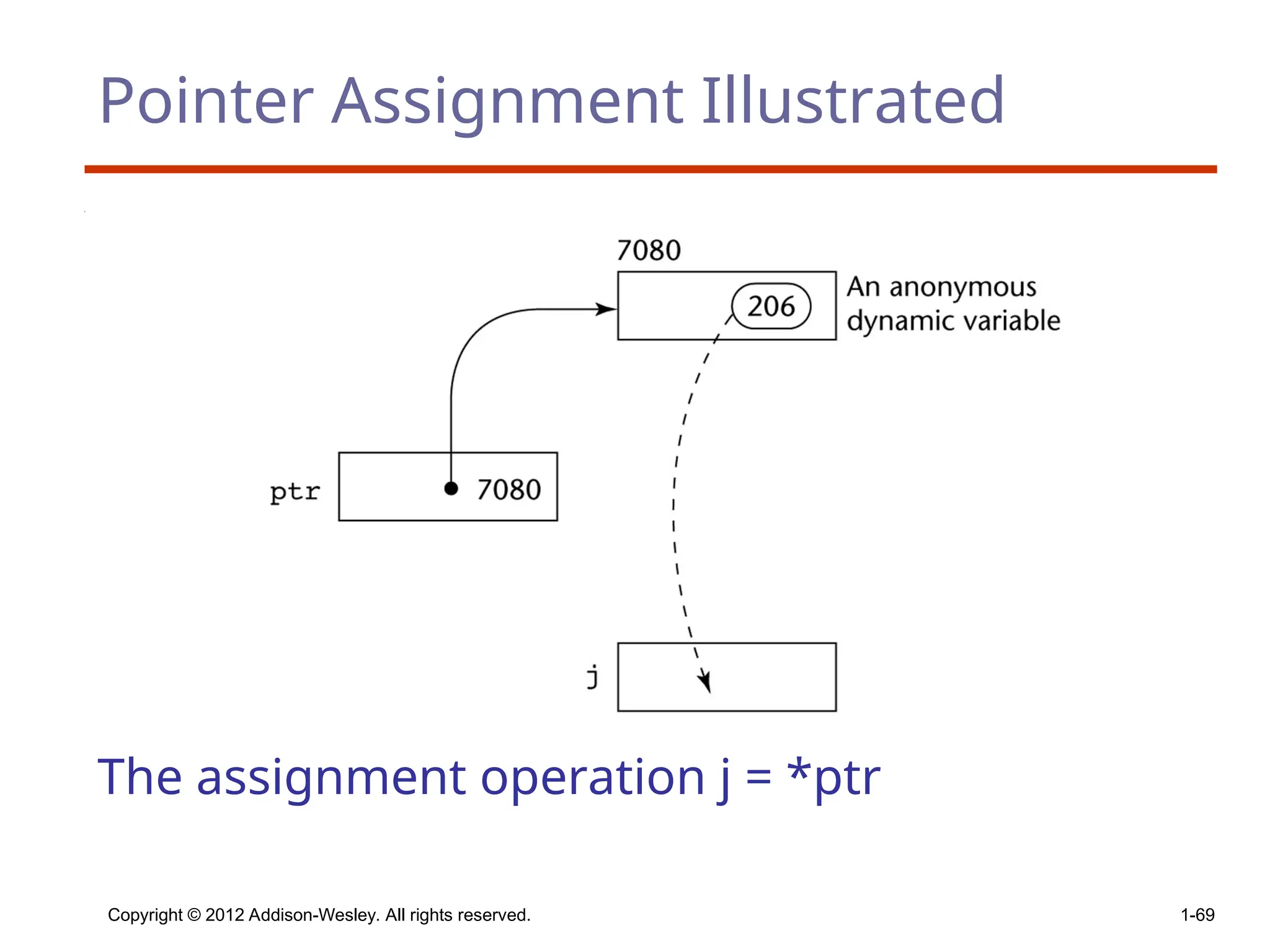
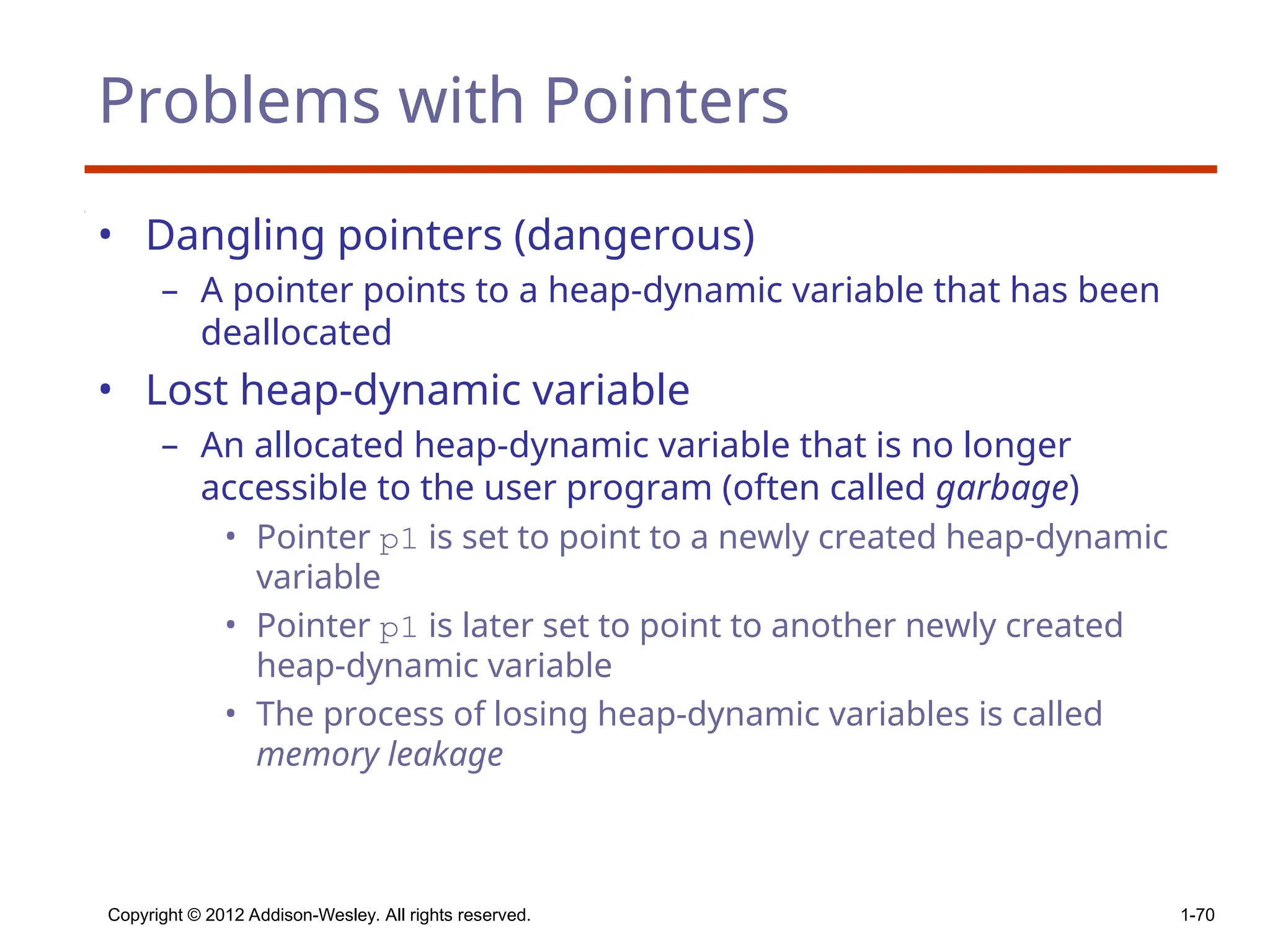
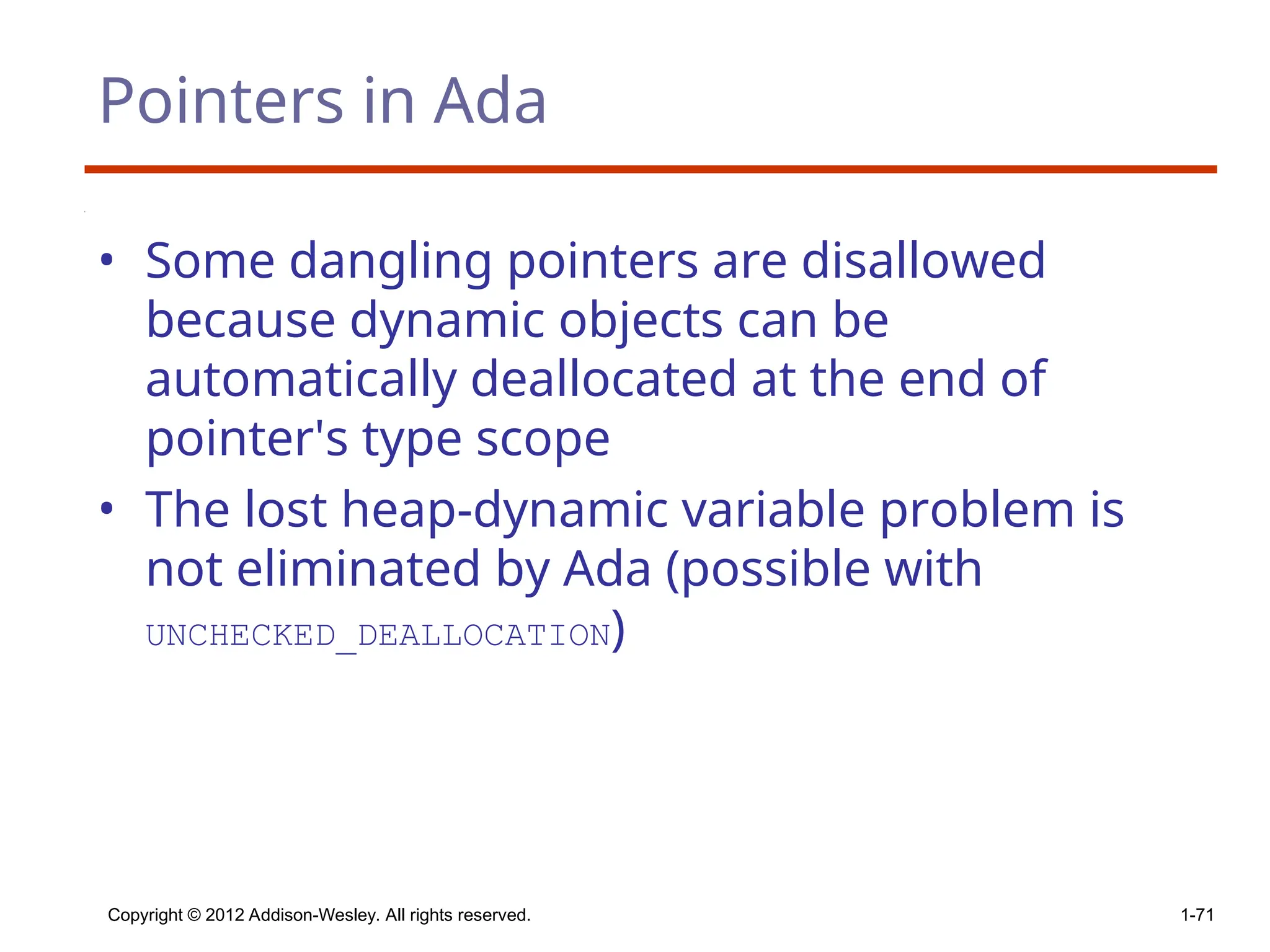
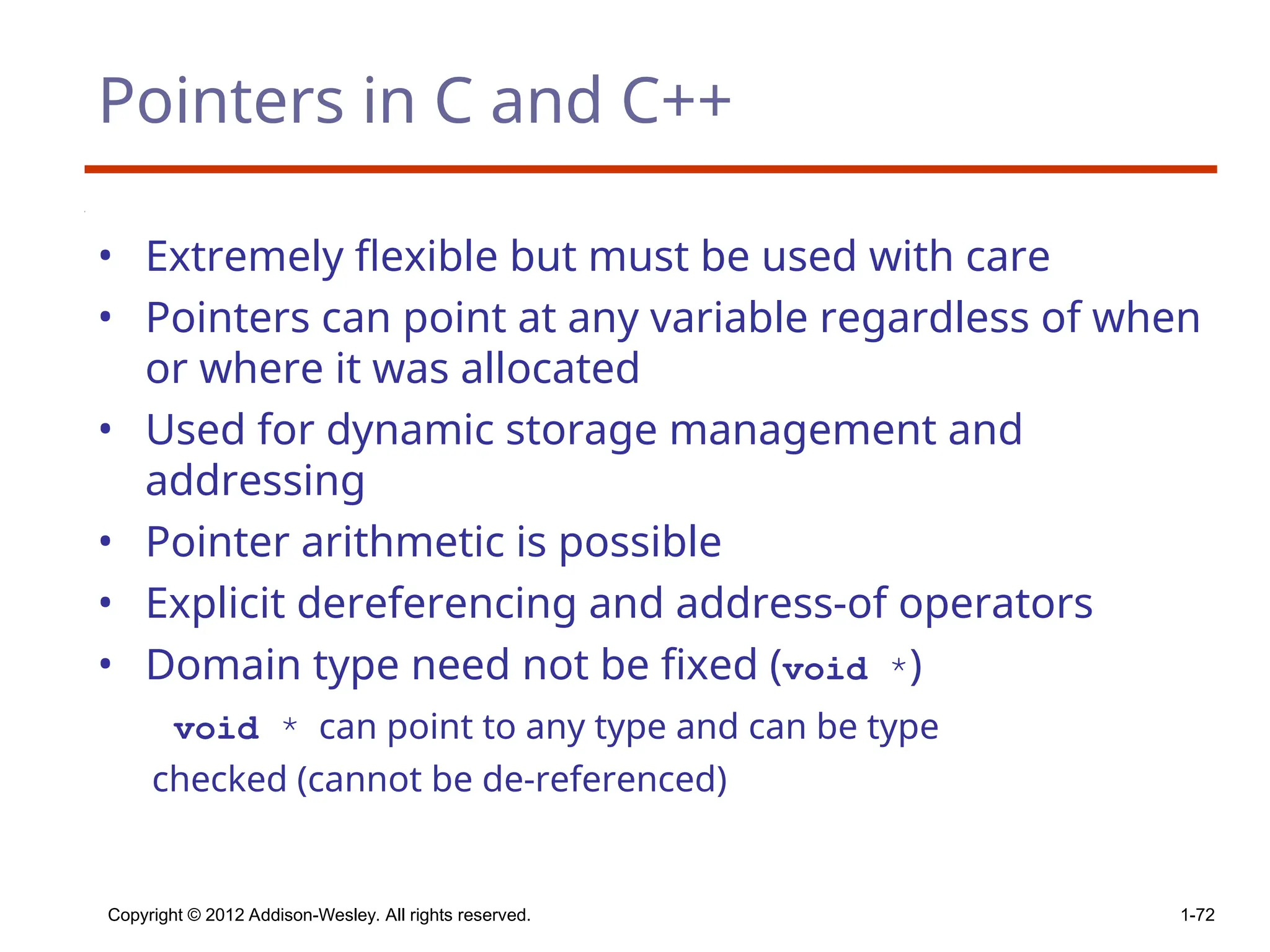
![Copyright © 2012 Addison-Wesley. All rights reserved. 1-73 Pointer Arithmetic in C and C++ float stuff[100]; float *p; p = stuff; *(p+5) is equivalent to stuff[5] and p[5] *(p+i) is equivalent to stuff[i] and p[i]](https://image.slidesharecdn.com/pl10ch6datatypes-250217025822-ba0cdf5c/75/pl10ch6_datatypesprinciplesof-programing-ppt-73-2048.jpg)
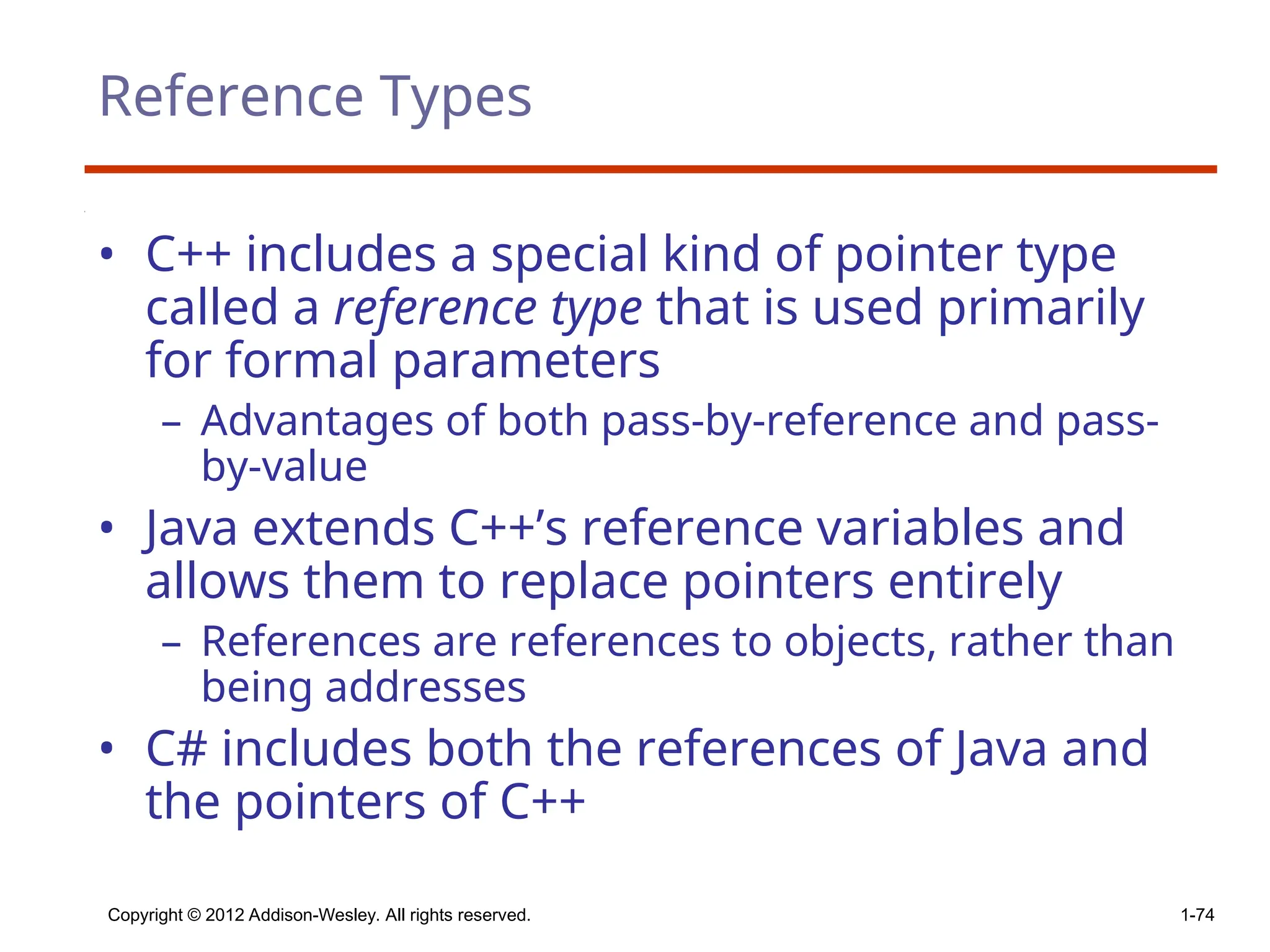
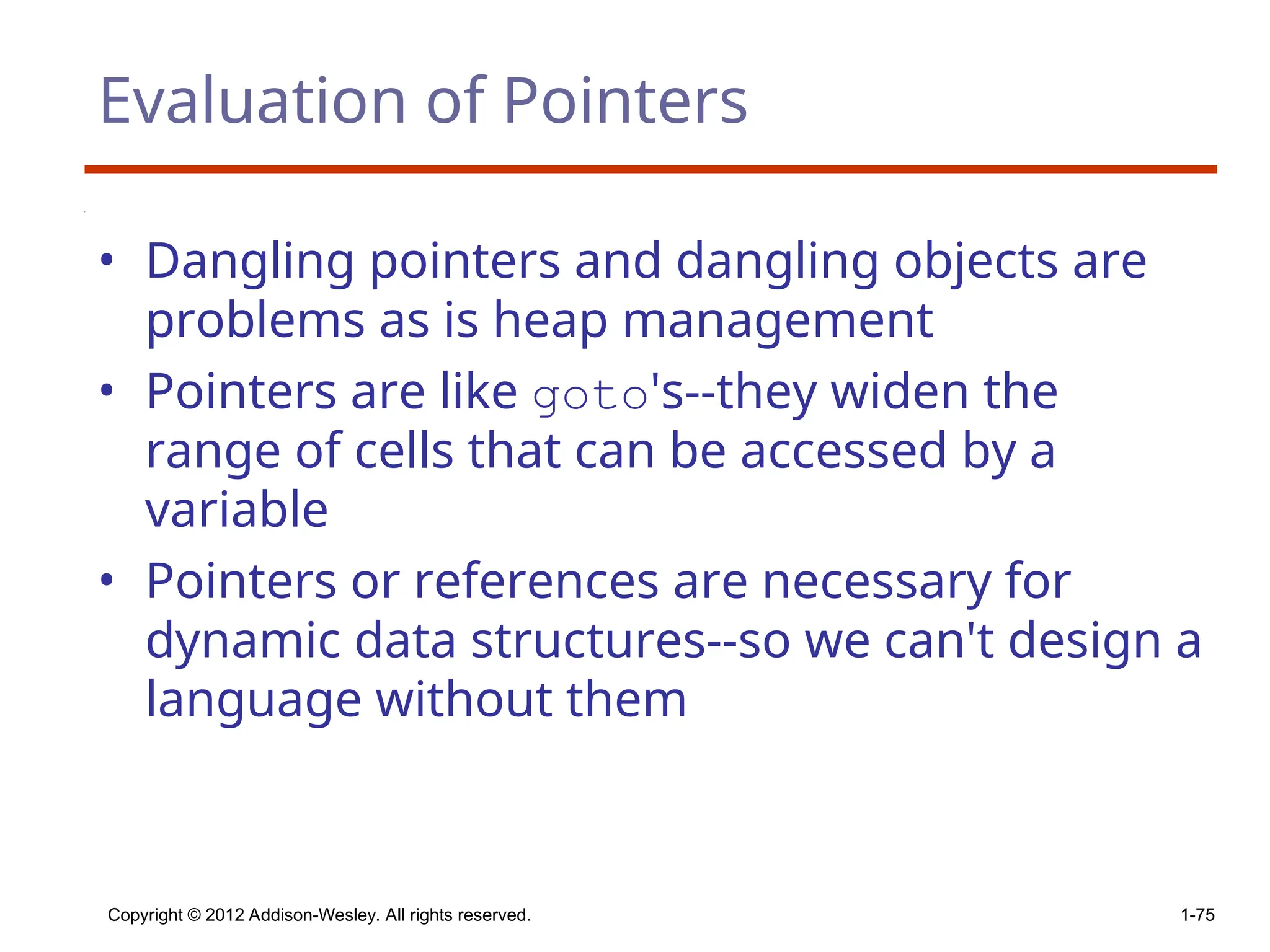
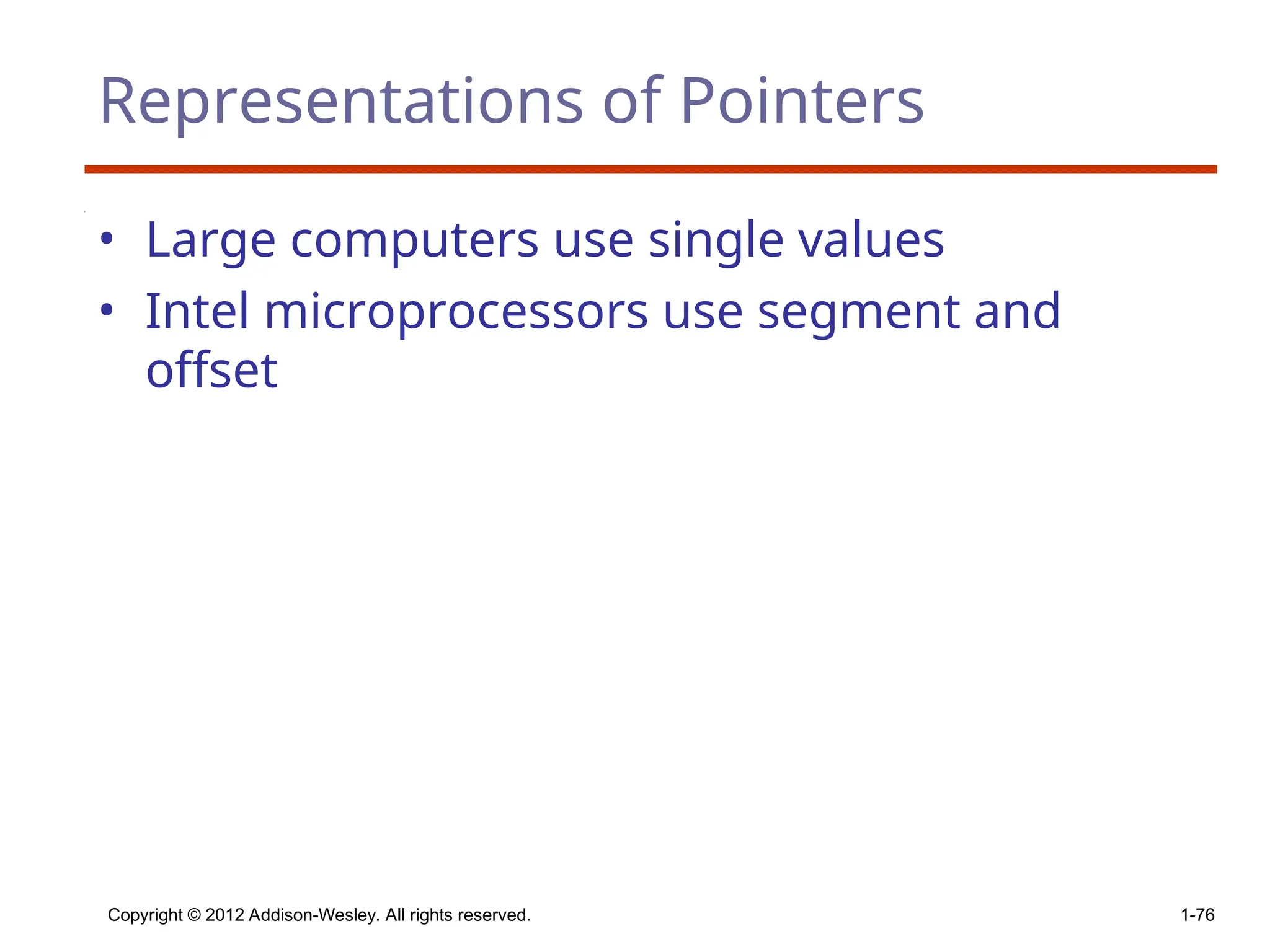
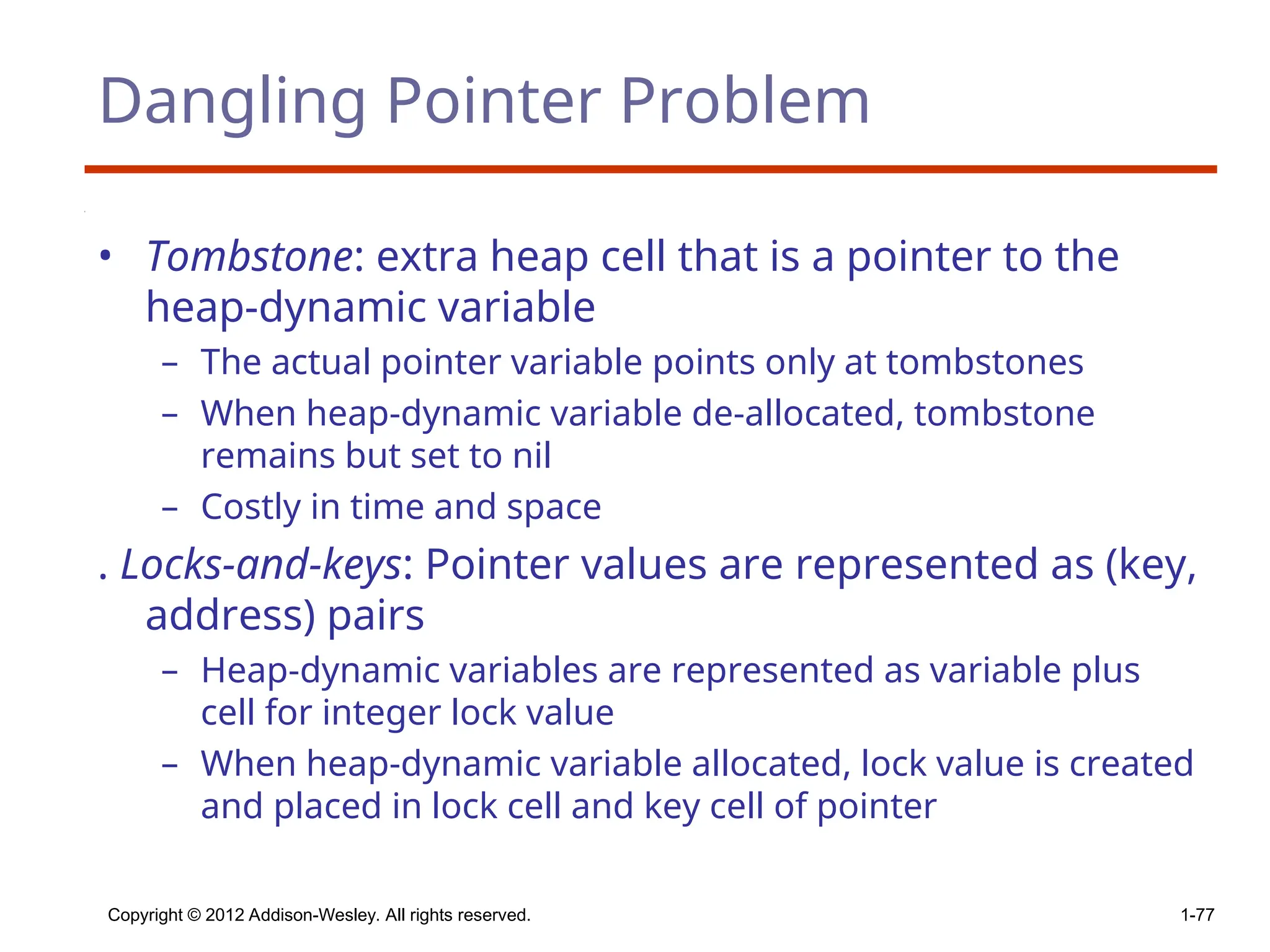
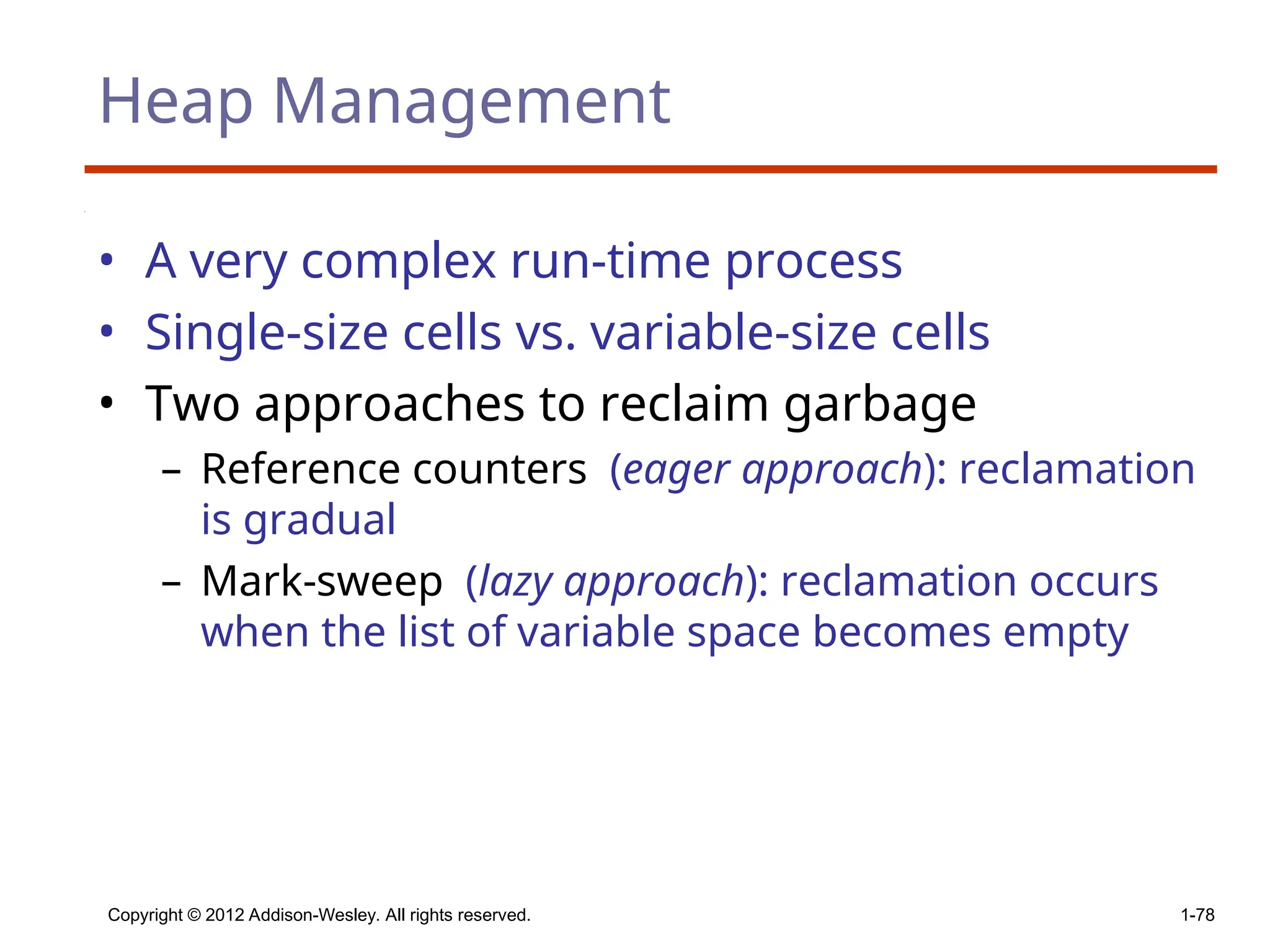
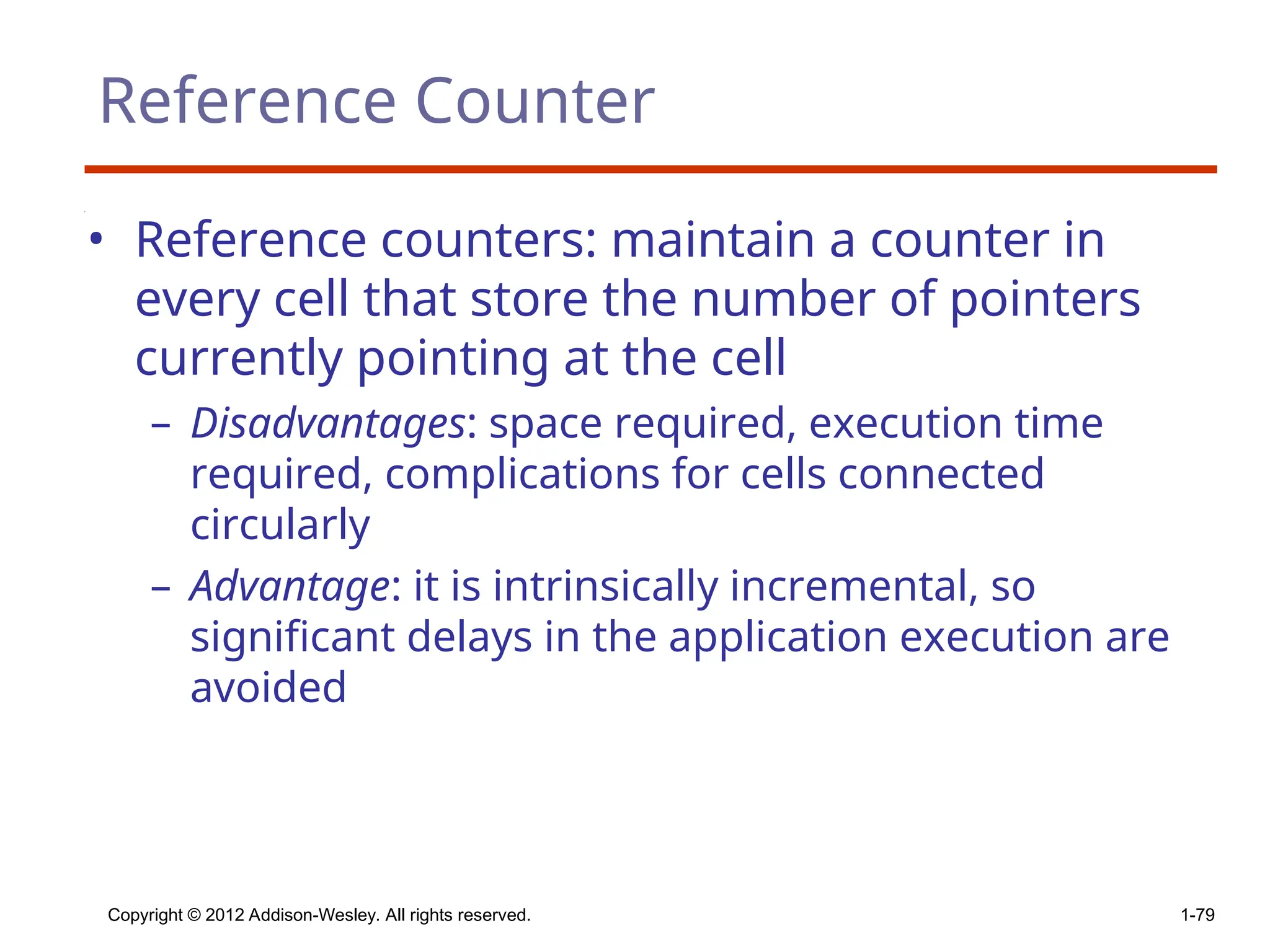
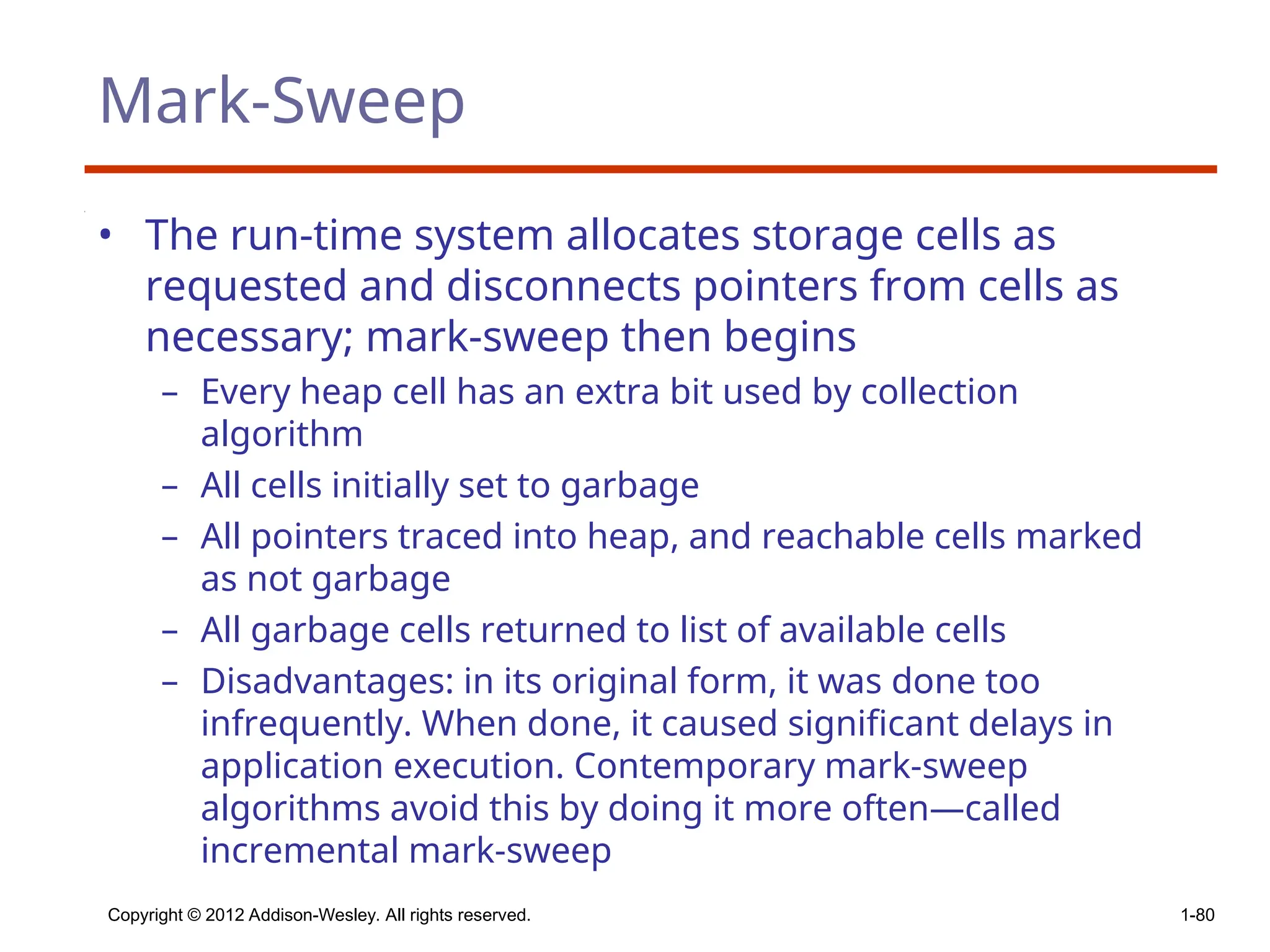
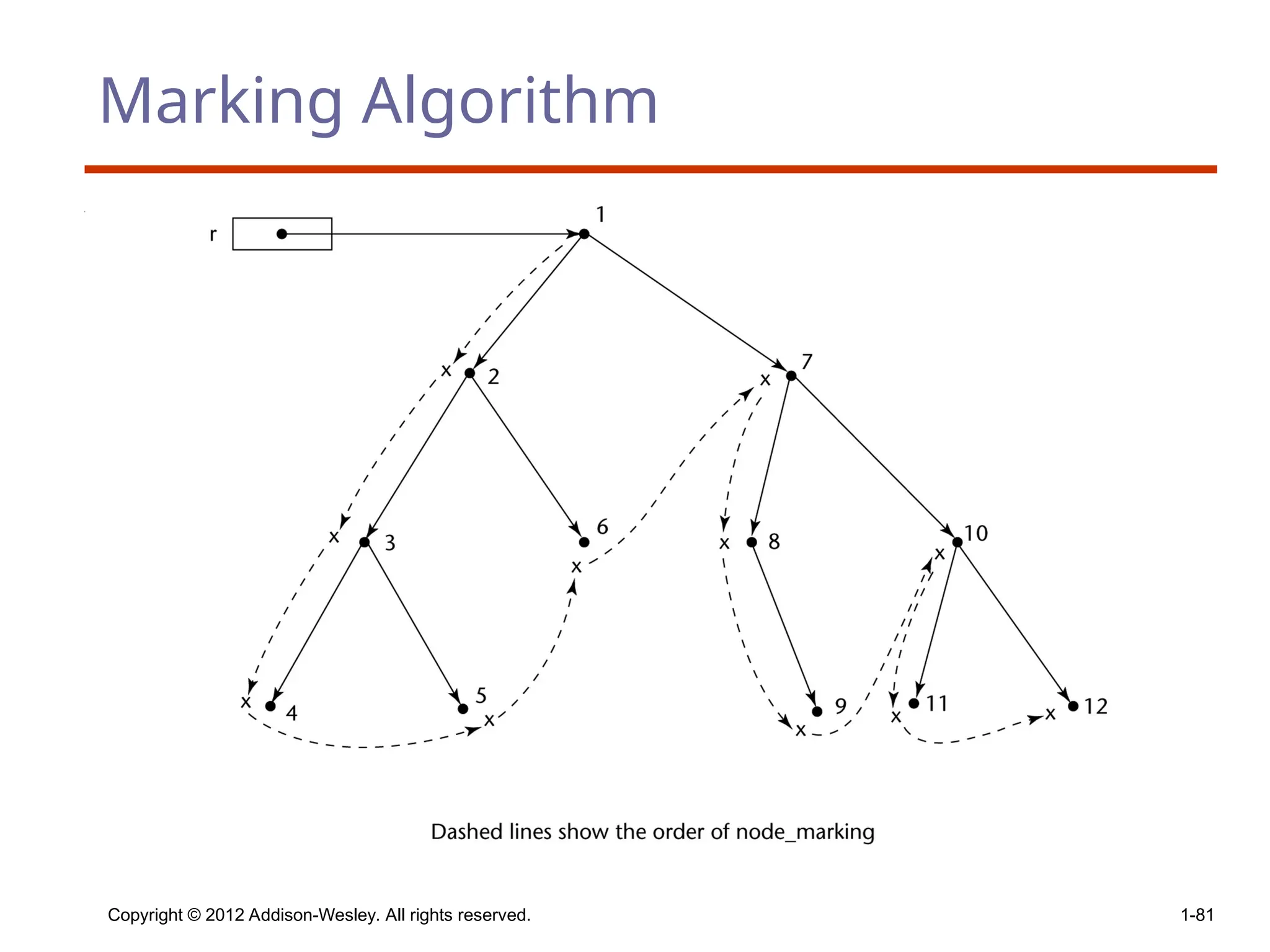
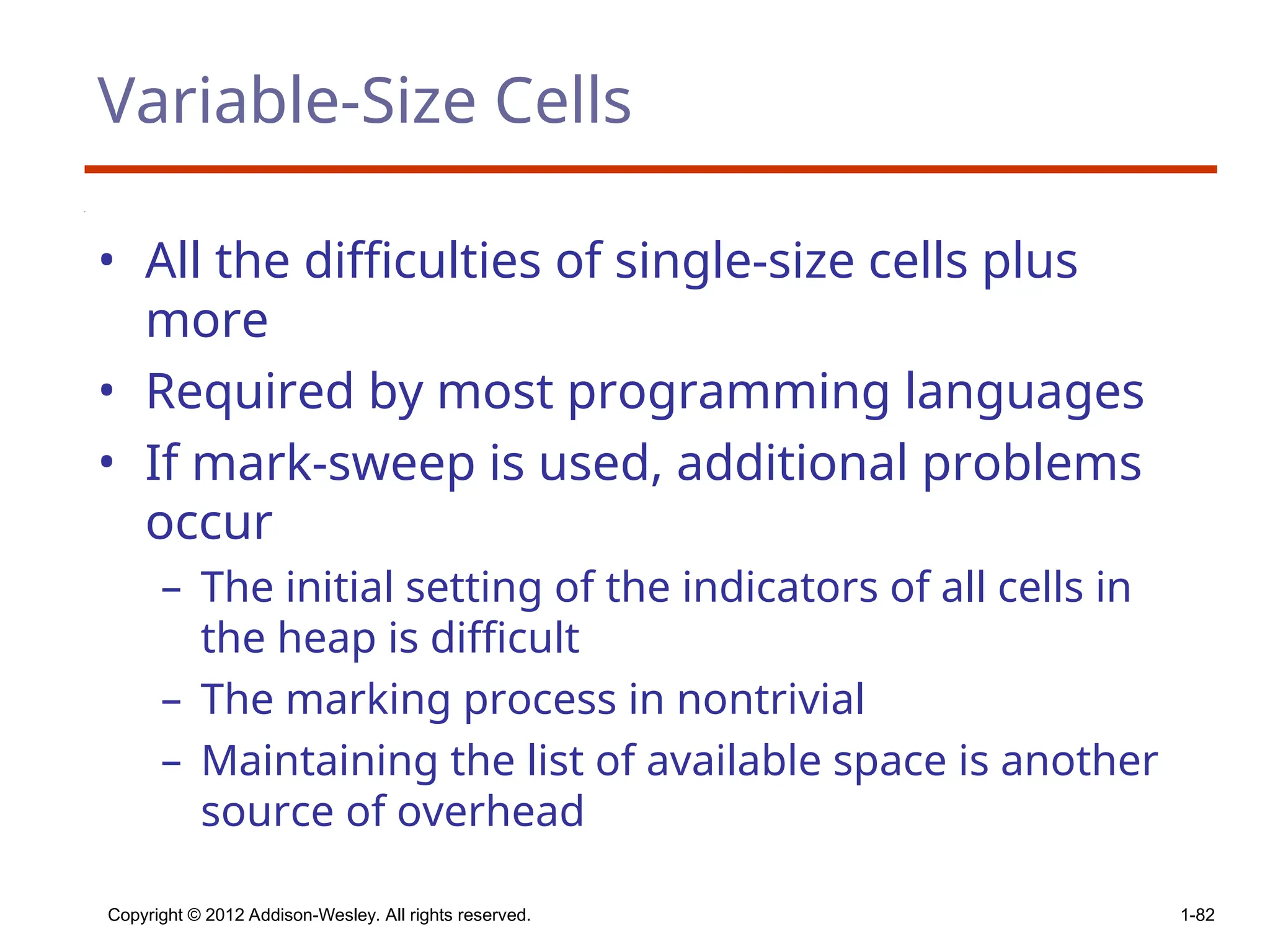
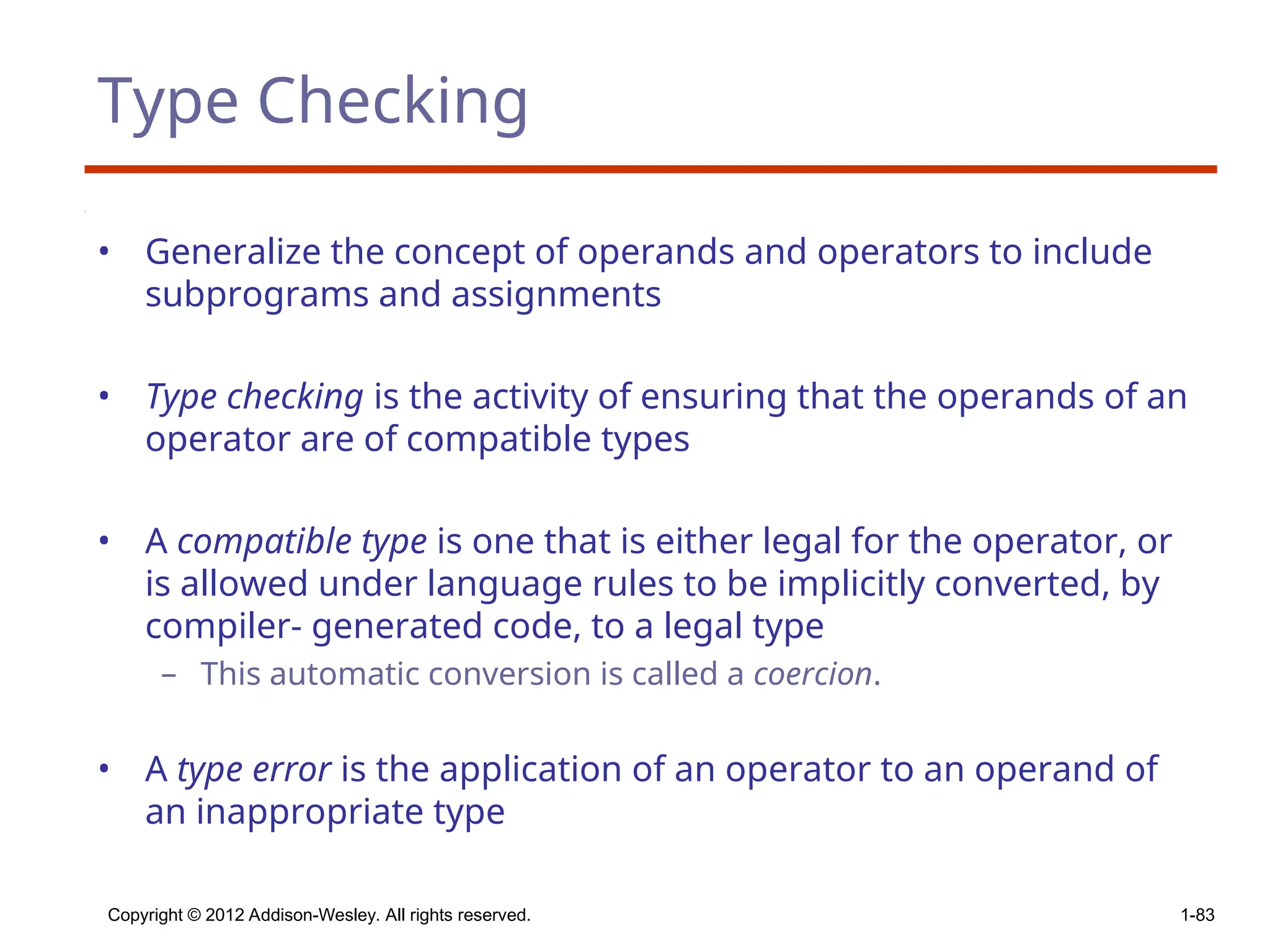
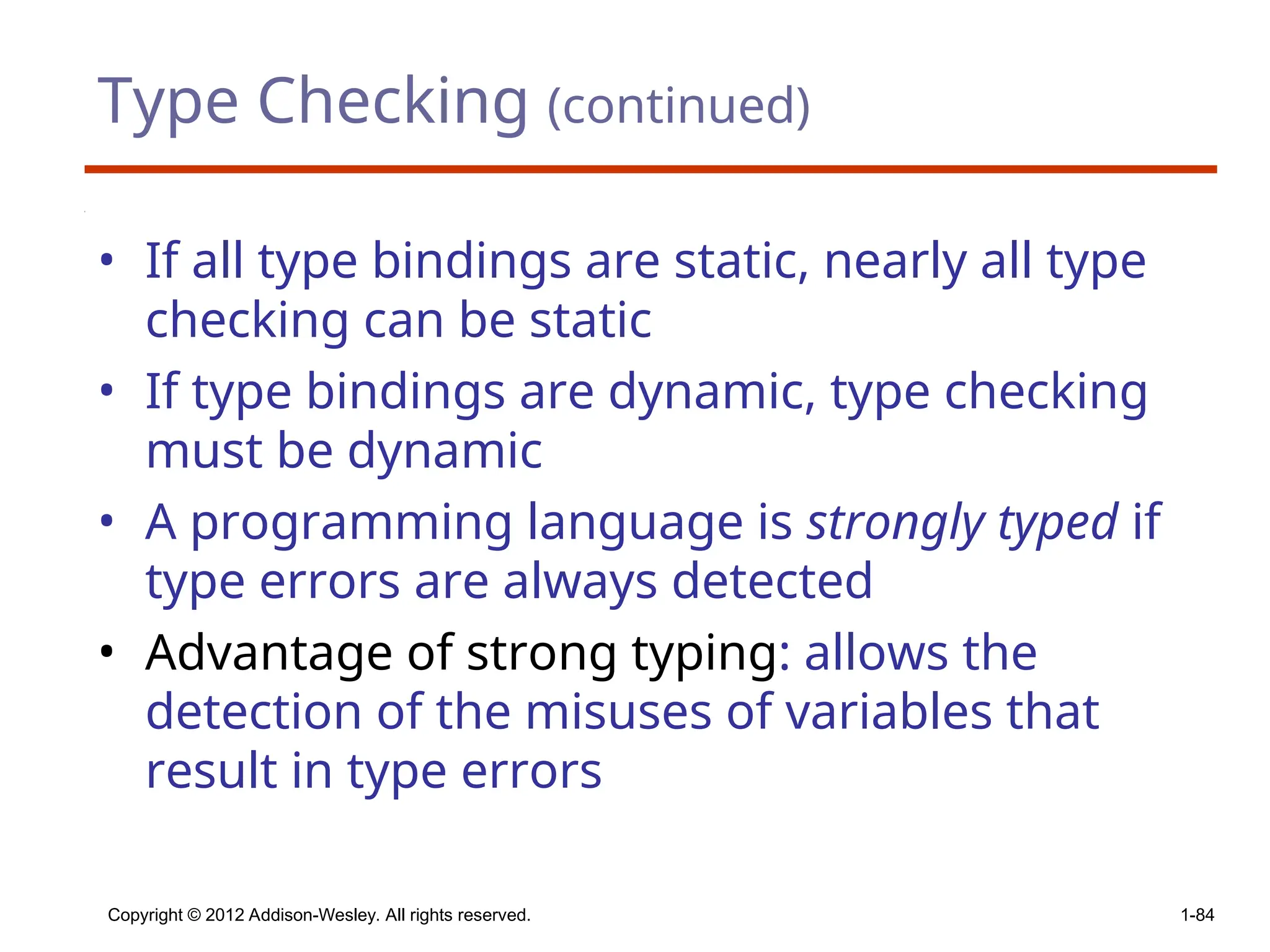
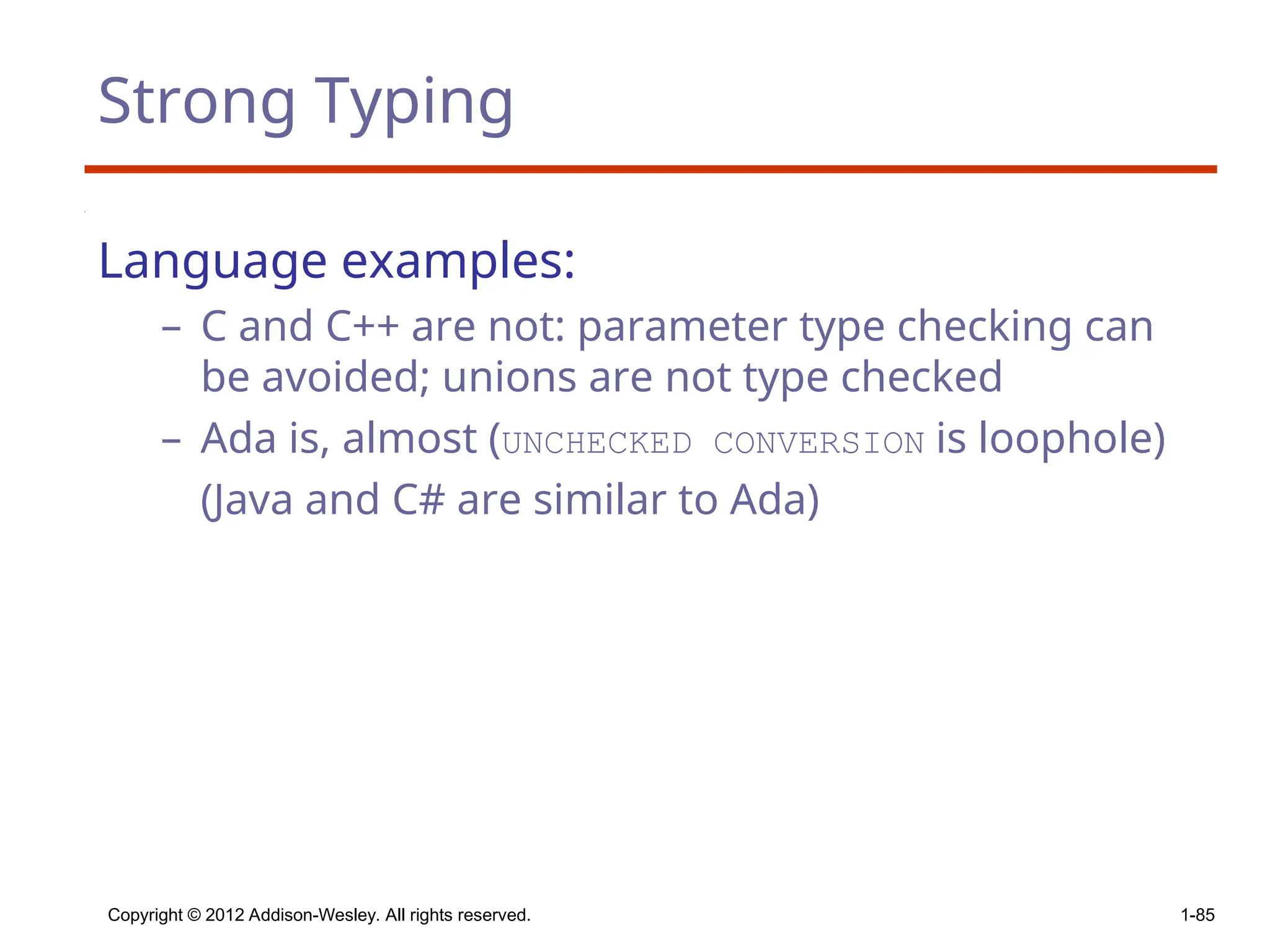
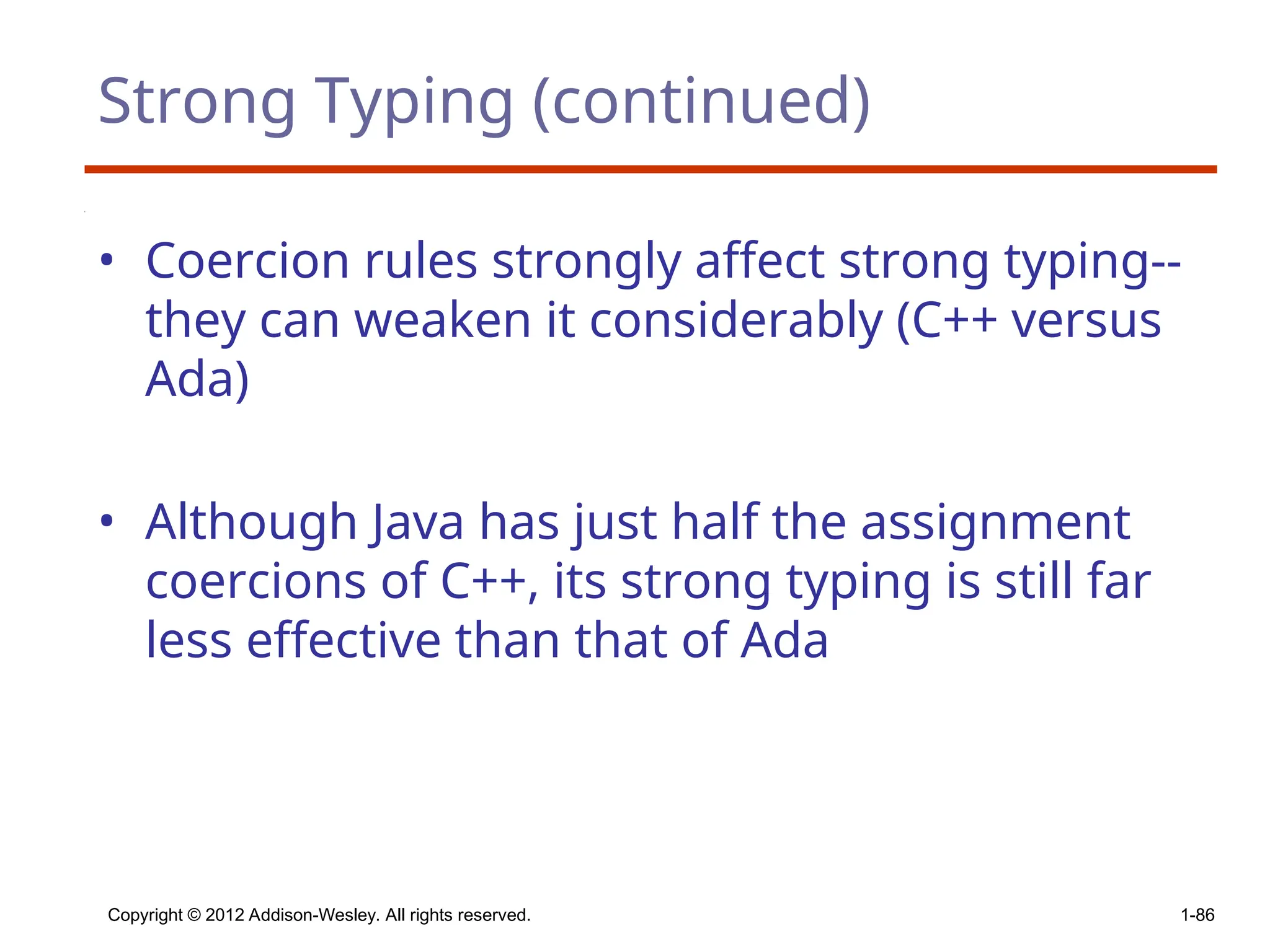
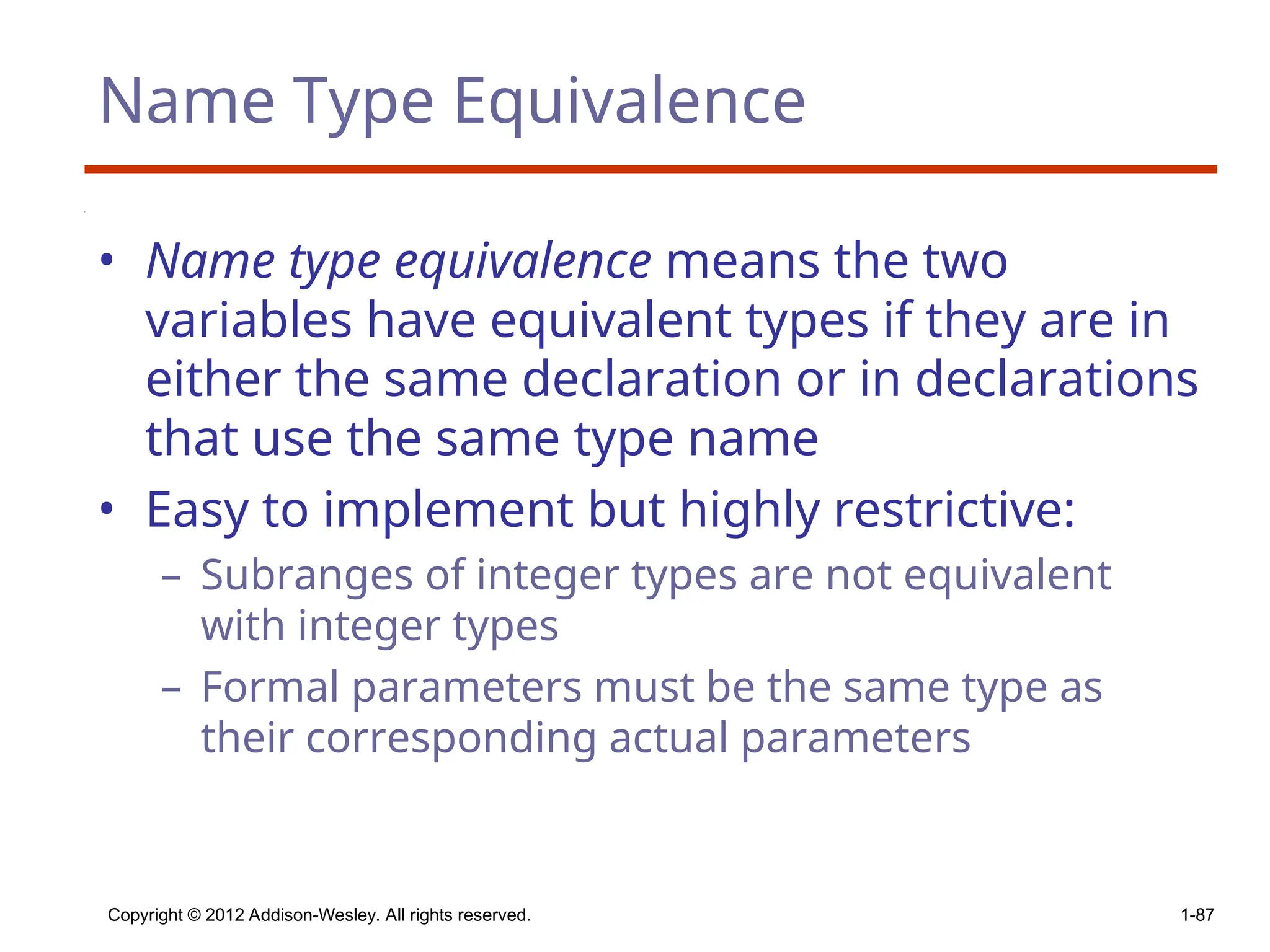
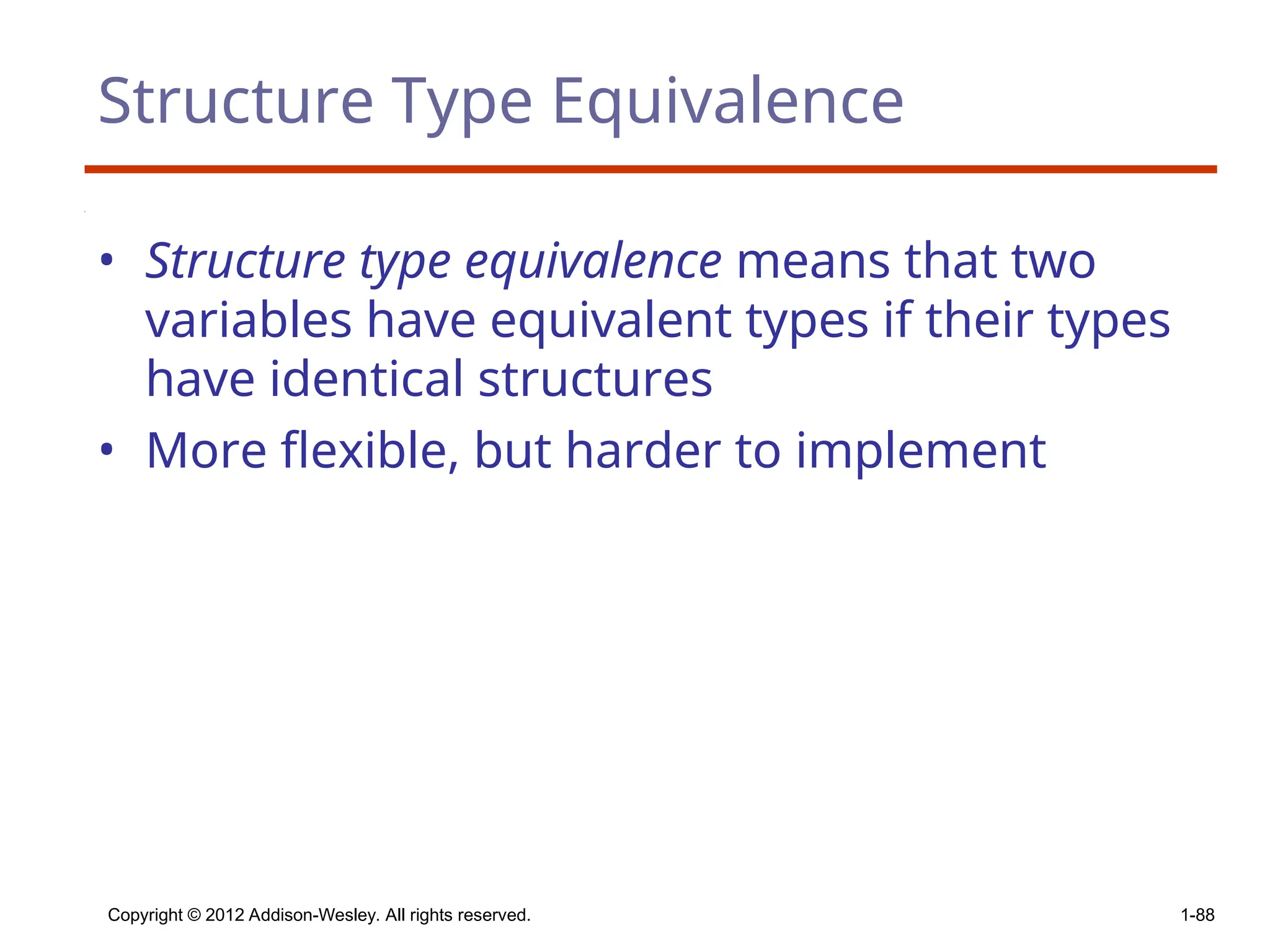
![Type Equivalence (continued) • Consider the problem of two structured types: – Are two record types equivalent if they are structurally the same but use different field names? – Are two array types equivalent if they are the same except that the subscripts are different? (e.g. [1..10] and [0..9]) – Are two enumeration types equivalent if their components are spelled differently? – With structural type equivalence, you cannot differentiate between types of the same structure (e.g. different units of speed, both float) Copyright © 2012 Addison-Wesley. All rights reserved. 1-89](https://image.slidesharecdn.com/pl10ch6datatypes-250217025822-ba0cdf5c/75/pl10ch6_datatypesprinciplesof-programing-ppt-89-2048.jpg)
